This document will continue to evolve as existing sections change and new information is added. All updates are logged below, with the most recent updates at the top.
The new functionality referenced in this document may not be immediately available to you if your organization has chosen not to receive optional monthly updates. Rest assured you will receive the new functionality in the next quarterly update which is required and cumulative. Quarterly updates are applied in February, May, August, and November. As a one-off exception the February 2017 Quarterly update will be applied in March 2017.
.
| Date |
Feature |
Notes |
|---|---|---|
| The following features were included in the May Quarterly update. |
||
| 27 APR 2018 |
Oracle Fusion Global Human Resources for the United Kingdom: P11D- Employee Benefits and Expenses Reporting |
Delivered new feature in update 17, the May quarterly update. |
| 27 APR 2018 |
Oracle Fusion Global Human Resources for the United States: Tax Withholding Card Enhancement for Guam |
Delivered new feature in update 17, the May quarterly update. |
| 27 APR 2018 |
Oracle Fusion Global Human Resources for the United States: e-IWO Inbound Process Enhancement |
Delivered new feature in update 17, the May quarterly update. |
| 30 MAR 2018 |
Oracle Fusion Global Human Resources for the United Kingdom: Gender Pay Gap Reporting |
Delivered new feature in update 16 (April), which will also be included in the May quarterly update. |
| 30 MAR 2018 |
Oracle Fusion Global Human Resources for the United Kingdom: Scottish Income Tax Rates and Bands |
Delivered new feature in update 16 (April), which will also be included in the May quarterly update. |
| 02 MAR 2018 |
Strategic Workforce Planning: Strategic Workforce Planning |
Delivered new feature in update 15 (March), which will also be included in the May quarterly update. |
| 02 MAR 2018 |
Oracle Fusion Benefits for the United States: e-IWO Audit Report Enhancement |
Delivered new feature in update 15 (March), which will also be included in the May quarterly update. |
| 02 MAR 2018 |
Oracle Fusion Global Human Resources for the United Kingdom: Legislative Updates |
Delivered new feature in update 15 (March), which will also be included in the May quarterly update. |
| 02 MAR 2018 |
Oracle Fusion Global Human Resources for the United Kingdom: Support for XML Format Submission for all RTI Outgoing Files |
Delivered new feature in update 15 (March), which will also be included in the May quarterly update. |
| 02 MAR 2018 |
Oracle Fusion Global Human Resources for the United Kingdom: Full Payment Submission (FPS) Breakdown to Smaller Files |
Delivered new feature in update 15 (March), which will also be included in the May quarterly update. |
| The following features were included in the February Quarterly update. |
||
| 02 FEB 2018 |
Oracle Fusion Benefits for the United States: e-IWO Enhanced Search Capabilities |
Delivered new feature in the February quarterly update. |
| 02 FEB 2018 |
Oracle Fusion Benefits for the United States: Third-Party Periodic Tax Filing Extract Inclusion of Payroll Frequency |
Delivered new feature in the February quarterly update. |
| 02 FEB 2018 |
Oracle Fusion Benefits for the United States: Involuntary Deduction Fee Priority |
Delivered new feature in the February quarterly update. |
| 02 FEB 2018 |
Oracle Fusion Global Human Resources for the United Kingdom: Legislative Updates for Tax Year 2018-19 |
Delivered new feature in the February quarterly update. |
| 02 FEB 2018 |
Oracle Fusion Global Human Resources for the United Kingdom: XML Format for RTI Outgoing Files |
Delivered new feature in the February quarterly update. |
| 02 FEB 2018 |
Oracle Fusion Global Human Resources for the United Kingdom: Benefits in Kind – Car and Car Fuel Rates for Tax Year 2018-19 |
Delivered new feature in the February quarterly update. |
| 02 FEB 2018 |
Oracle Fusion Benefits for Canada: Reporting Mode: Draft and Final Mode for End-of-Year Reports Process |
Delivered new feature in update 13 (January), which will also be included in the February quarterly update. |
| 02 FEB 2018 |
Oracle Fusion Benefits for the United States: Involuntary Deduction Disposable Income Recalculation |
Delivered new feature in update 10 (October), which will also be included in the November quarterly update. |
| 05 JAN 2018 |
Oracle Fusion Global Human Resources for the United Kingdom: XML Message Retrieval Support from HMRC Data Provisioning System |
Delivered new feature in update 13 (January), which will also be included in the February quarterly update. |
| 05 JAN 2018 |
Oracle Fusion Global Human Resources for the United Kingdom: Processing Benefits in Kind Through Payroll |
Delivered new feature in update 13 (January), which will also be included in the February quarterly update. |
| 05 JAN 2018 |
Oracle Fusion Human Capital Management for Luxembourg: Enhanced Postal Code Validation |
Delivered new feature in update 13 (January), which will also be included in the February quarterly update. |
| 05 JAN 2018 |
Oracle Fusion Human Capital Management for the United States: Affordable Care Act Override Upload (United States Customers only) |
Delivered new feature in update 1 (February 2017). |
| 08 DEC 2017 |
Oracle Fusion Human Capital Management for the United States: New York Family Leave Insurance Support |
Delivered new feature in the Statutory Update 12.2 (December), which will also be included in the February quarterly update. |
| 08 DEC 2017 |
Oracle Fusion Human Capital Management for the United States: Guam Support |
Delivered new feature in the Statutory Update 12.2 (December), which will also be included in the February quarterly update. |
| 08 DEC 2017 |
Oracle Fusion Human Capital Management for the United States: Run US Tax Balance Adjustment Process |
Delivered new feature in the Statutory Update 12.2 (December), which will also be included in the February quarterly update. |
| 08 DEC 2017 |
Oracle Fusion Human Capital Management for the United States: Enhanced Year-Begin Process |
Delivered new feature in the Statutory Update 12.2 (December), which will also be included in the February quarterly update. |
| 08 DEC 2017 |
Oracle Fusion Human Capital Management for the United States: Enhanced Ohio School District Tax Calculation |
Delivered new feature in the Statutory Update 12.2 (December), which will also be included in the February quarterly update. |
| 08 DEC 2017 |
Oracle Fusion Human Capital Management for the United States: Puerto Rico Young Entrepreneurs Act |
Delivered new feature in the Statutory Update 12.2 (December), which will also be included in the February quarterly update. |
| 08 DEC 2017 |
Oracle Fusion Global Human Resources for Canada: Employee Active Payroll Balance Report |
Delivered new feature in the Statutory Update 12.2 (December), which will also be included in the February quarterly update. |
| 01 DEC 2017 |
Oracle Fusion Global Human Resources for the United States: Third-Party Periodic Tax Filing Audit Report Detail Enhancements |
Delivered new feature in update 12 (December), which will also be included in the February quarterly update. |
| 01 DEC 2017 |
Oracle Fusion Global Human Resources for the United States: Third-Party Quarterly Tax Filing Extract Enhancement for Amended Quarter Filings |
Delivered new feature in update 12 (December), which will also be included in the February quarterly update. |
| 01 DEC 2017 |
Oracle Fusion Global Human Resources for the United States: Third-Party Quarterly Tax Filing Extract Vendor Enhancements for Fourth Quarter |
Delivered new feature in update 12 (December), which will also be included in the February quarterly update. |
| 01 DEC 2017 |
Oracle Fusion Global Human Resources for the United States: Employee Active Balance Report Enhancements to Include New Balances |
Delivered new feature in update 12 (December), which will also be included in the February quarterly update. |
| 01 DEC 2017 |
Oracle Fusion Payroll Interface: Deleted Data Report |
Delivered new feature in update 12 (December), which will also be included in the February quarterly update. |
| The following features were included in the November Quarterly update. |
||
| 03 NOV 2017 |
Oracle Fusion Global Human Resources for the United States: Electronic Income Withholding Orders Reference Code Enhancement |
Delivered new feature in update 11, the November quarterly update. |
| 03 NOV 2017 |
Oracle Fusion Global Human Resources for the United States: New Ninety Day Balance Dimension |
Delivered new feature in update 11, the November quarterly update. |
| 03 NOV 2017 |
Oracle Fusion Global Human Resources for the United States: Involuntary Deductions Processing Fee Enhancement |
Delivered new feature in update 7 (July), which was included in the August quarterly update. |
| 06 OCT 2017 |
Oracle Fusion Global Human Resources/ HCM Cloud Mobile: Edit Person Information |
Delivered new feature in update 10 (October), which will also be included in the November quarterly update. |
| 06 OCT 2017 |
Oracle Fusion Global Human Resources/ HCM Cloud Mobile: Enhanced Directory Search |
Delivered new feature in update 10 (October), which will also be included in the November quarterly update. |
| 06 OCT 2017 |
Oracle Fusion Global Human Resources for Australia: Identification of Working Holiday Makers |
Delivered new feature in update 10 (October), which will also be included in the November quarterly update. |
| 06 OCT 2017 |
Oracle Fusion Global Human Resources for Australia: Identification of Trade Support Loan Participation Separately From Higher Education Loan Program |
Delivered new feature in update 10 (October), which will also be included in the November quarterly update. |
| 06 OCT 2017 |
Oracle Fusion Global Human Resources for China: Supplementary Public Housing Fund |
Delivered new feature in update 10 (October), which will also be included in the November quarterly update. |
| 06 OCT 2017 |
Oracle Fusion Global Human Resources for the United Kingdom: Alabaster Ruling for Statutory Maternity – pay Rise During Leave |
Delivered new feature in update 10 (October), which will also be included in the November quarterly update. |
| 06 OCT 2017 |
Oracle Fusion Global Human Resources for the United States: Electronic Income Withholding Orders Inbound Process Enhancements |
Delivered new feature in update 10 (October), which will also be included in the November quarterly update. |
| 06 OCT 2017 |
Oracle Fusion Global Human Resources for the United States: Absence Element Template Enhancements |
Delivered new feature in update 10 (October), which will also be included in the November quarterly update. |
| 06 OCT 2017 |
Oracle Fusion Global Human Resources for Argentina: Enhanced Postal Code Validation |
Delivered new feature in update 10 (October), which will also be included in the November quarterly update. |
| 06 OCT 2017 |
Oracle Fusion Global Human Resources for China: Enhanced Social Security Account Information Page |
Update document. Delivered new feature in update 3 (March). |
| 01 SEP 2017 |
Oracle Fusion Global Human Resources for the United Kingdom: Sexual Orientation and Gender Identity |
Delivered new feature in update 9 (September), which will also be included in the November quarterly update. |
| 01 SEP 2017 |
Oracle Fusion Global Human Resources for the United Kingdom: Errors and Warnings Report in Pension Automatic Enrolment Flow |
Delivered new feature in update 9 (September), which will also be included in the November quarterly update. |
| 01 SEP 2017 |
Oracle Fusion Global Human Resources: Display NonWorkers in My Team and Directory |
Delivered new feature in update 9 (September), which will also be included in the November quarterly update. |
| The following features were included in the August Quarterly update. |
||
| 04 AUG 2017 |
Oracle Fusion Global Human Resources: Populate the Context of the Document Records DFF Based on the Document Type |
Delivered new feature in the August quarterly update. |
| 04 AUG 2017 |
Oracle HCM Cloud Mobile: Exporting Contact Information |
Delivered new feature in the August quarterly update. |
| 04 AUG 2017 |
Oracle HCM Cloud Mobile: Profile Options to Show or Hide Worker Information |
Delivered new feature in the August quarterly update. |
| 04 AUG 2017 |
Oracle HCM Cloud Mobile: View Personal Information |
Delivered new feature in the August quarterly update. |
| 04 AUG 2017 |
Oracle HCM Cloud Mobile: Edit Areas of Expertise |
Delivered new feature in the August quarterly update. |
| 04 AUG 2017 |
Oracle Fusion Global Human Resources for South Africa: New Values for the National Identifier and Visa or Permit Type |
Delivered new feature in the August quarterly update. |
| 04 AUG 2017 |
Oracle Fusion Global Human Resources for South Africa: Enhanced National Identifier Validation |
Delivered new feature in the August quarterly update. |
| 04 AUG 2017 |
Oracle Fusion Global Human Resources for Canada: Absence Elements: Discretionary and Final Disbursement Absence Payments |
Delivered new feature in the August quarterly update. |
| 04 AUG 2017 |
Oracle Fusion Global Human Resources: New Hidden Fields in My Team and Directory |
Delivered new feature in the August quarterly update. |
| 04 AUG 2017 |
Oracle Fusion Global Human Resources: Persistency in My Team and Directory |
Delivered new feature in the August quarterly update. |
| 04 AUG 2017 |
Oracle Fusion Global Human Resources for the United Kingdom: Court Orders – DEO Reference Number Output on BACS File |
Delivered new feature in update 7 (July), which will also be included in the August quarterly update. |
| 04 AUG 2017 |
Oracle Fusion Global Human Resources for the United Kingdom: Payroll Validation Report – Change to Excel Output |
Delivered new feature in update 7 (July), which will also be included in the August quarterly update. |
| 04 AUG 2017 |
Oracle Fusion Global Human Resources for Qatar: Organization Setup |
Delivered new feature in update 7 (July), which will also be included in the August quarterly update. |
| 04 AUG 2017 |
Oracle Fusion Global Human Resources for Qatar: Person and Employment |
Delivered new feature in update 7 (July), which will also be included in the August quarterly update. |
| 04 AUG 2017 |
Oracle Fusion Global Human Resources for Qatar: Payroll Base Data |
Delivered new feature in update 7 (July), which will also be included in the August quarterly update. |
| 04 AUG 2017 |
Oracle Fusion Global Human Resources for Qatar: Payroll Data Capture |
Delivered new feature in update 7 (July), which will also be included in the August quarterly update. |
| 04 AUG 2017 |
Oracle Fusion Global Human Resources for Qatar: Automatic Calculation Card Creation |
Delivered new feature in update 7 (July), which will also be included in the August quarterly update. |
| 04 AUG 2017 |
Oracle Fusion Global Human Resources for Qatar: Social Insurance Calculations |
Delivered new feature in update 7 (July), which will also be included in the August quarterly update. |
| 04 AUG 2017 |
Oracle Fusion Global Human Resources for Qatar: Gratuity Calculations |
Delivered new feature in update 7 (July), which will also be included in the August quarterly update. |
| 04 AUG 2017 |
Oracle Fusion Global Human Resources for Qatar: Involuntary Deduction Element Template |
Delivered new feature in update 7 (July), which will also be included in the August quarterly update. |
| 04 AUG 2017 |
Oracle Fusion Global Human Resources for Qatar: Statement of Earnings |
Delivered new feature in update 7 (July), which will also be included in the August quarterly update. |
| 07 JUL 2017 |
Oracle Fusion Global Payroll Interface: Integration with ADP Global Payroll |
Delivered new feature in update 7 (July), which will also be included in the August quarterly update. |
| 07 JUL 2017 |
Oracle Fusion Global Human Resources for the United States: Involuntary Deductions Subprocessing Order Defaults |
Delivered new feature in update 7 (July), which will also be included in the August quarterly update. |
| 07 JUL 2017 |
Oracle Fusion Global Human Resources for the United States: New VETS-4212 Audit Report |
Delivered new feature in update 7 (July), which will also be included in the August quarterly update. |
| 07 JUL 2017 |
Oracle Fusion Global Human Resources for the United Kingdom: Test Mode for Start of Year and Tax Code Uplift Processes |
Delivered new feature in update 6 (June), documented in Update 7, and will also be included in the August quarterly update. |
| 07 JUL 2017 |
Oracle Fusion Global Human Resources for the United Kingdom: Interchange Reference Control Number for Incoming Messages |
Delivered new feature in update 6 (June), documented in Update 7, and will also be included in the August quarterly update |
| 07 JUL 2017 |
Oracle Fusion Global Human Resources for the United Kingdom: Unique Reporting Reference for New Court Orders |
Delivered new feature in update 6 (June), documented in Update 7, and will also be included in the August quarterly update |
| 07 JUL 2017 |
Oracle Fusion Global Human Resources for the United Kingdom: Statutory Sick Pay for Employees Working Overnight Shifts |
Delivered new feature in update 6 (June), documented in Update 7, and will also be included in the August quarterly update |
| 07 JUL 2017 |
Oracle Fusion Global Human Resources for the United Kingdom: Configure Average Weekly Earnings |
Delivered new feature in update 6 (June), documented in Update 7, and will also be included in the August quarterly update |
| 07 JUL 2017 |
Oracle Fusion Global Human Resources: Worker User Accounts No Longer Created Automatically for Users Loaded in Bulk |
Removed feature. |
| 02 JUN 2017 |
Oracle Fusion Global Human Resources for the United States: Enhanced Deductions At Time of Writ Support |
Delivered new feature in update 6 (June), documented in Update 7, and will also be included in the August quarterly update |
| 02 JUN 2017 |
Oracle Fusion Global Human Resources for the United States: Enhanced Form 1494 Exemption Amount Derivation |
Delivered new feature in update 6 (June), documented in Update 7, and will also be included in the August quarterly update |
| 02 JUN 2017 |
Oracle Fusion Global Human Resources for Chile: Enhanced Validation of the RUT |
Delivered new feature in update 6 (June), documented in Update 7, and will also be included in the August quarterly update |
| 02 JUN 2017 |
Oracle Fusion Transactional Business Intelligence: Compensation Manager List |
Delivered new feature in update 6 (June), documented in Update 7, and will also be included in the August quarterly update |
| 02 JUN 2017 |
Oracle Fusion Global Human Resources: Navigate to Person Spotlight from Internal Information Sharing |
Delivered new feature in update 6 (June), documented in Update 7, and will also be included in the August quarterly update |
| The following features are included in the May Quarterly update. |
||
| 02 JUN 2017 |
Oracle Fusion Global Human Resources: Areas of Responsibility Enhancements |
Delivered new feature in update 5, the May quarterly update. |
| 02 JUN 2017 |
Oracle Fusion Hiring Manager Experience: Hiring Manager Experience |
Delivered new feature in update 5, the May quarterly update. |
| 05 MAY 2017 |
Oracle Fusion Global Human Resources for the United Kingdom: Add Support for BACS Processing Date to BACS Flow |
Delivered new feature in update 5, the May quarterly update. |
| 05 MAY 2017 |
Oracle Fusion Global Human Resources for the United Kingdom: Court Orders Reference List of Values Available |
Delivered new feature in update 5, the May quarterly update. |
| 05 MAY 2017 |
Oracle Fusion Global Human Resources/ HCM Cloud Mobile: Using Directory Search |
Delivered new feature in update 5, the May quarterly update. |
| 05 MAY 2017 |
Oracle Fusion Global Human Resources/ HCM Cloud Mobile: New My Day Format |
Delivered new feature in update 5, the May quarterly update. |
| 05 MAY 2017 |
Oracle Fusion Global Human Resources/ HCM Cloud Mobile: Consistent User Experience in Mobile and Web Application |
Delivered new feature in update 5, the May quarterly update. |
| 05 MAY 2017 |
Oracle Fusion Global Human Resources: Enhanced Manage Direct Reports |
Feature was included in the base release; with this update we have added information on the feature. |
| 07 APR 2017 |
Oracle Fusion Global Human Resources for the United States: EFT Payments Now Include A Reference ID |
Delivered new feature in update 4 (April), which will also be included in the May quarterly update. |
| 07 APR 2017 |
Oracle Fusion Global Human Resources: Streamlined Navigation |
Feature was included in the base release. However, there are two new options that were added to this feature in Update 4 (April). |
| The following features are included in the March Quarterly update. |
||
| 07 APR 2017 |
Oracle Fusion Global Human Resources: Enhanced Document Records |
Delivered new feature in update 3, the March quarterly update. |
| 07 APR 2017 |
Oracle Fusion Global Human Resources: Enhanced Document Records |
Delivered new feature in update 3, the March quarterly update. |
| 07 APR 2017 |
Oracle Fusion Global Human Resources: Enhanced Document Delivery Preferences |
Delivered new feature in update 3, the March quarterly update. |
| 17 MAR 2017 |
Oracle Fusion Global Human Resources for Canada: Involuntary Deductions: Enhanced Protected Pay Rules |
Delivered new feature in update 3, the March quarterly update. |
| 17 MAR 2017 |
Oracle Fusion Global Human Resources for Canada: Reporting Information Card |
Delivered new feature in update 3, the March quarterly update. |
| 17 MAR 2017 |
Oracle Fusion Global Human Resources for Canada: Global Absence Element Uptake |
Delivered new feature in update 3, the March quarterly update. |
| 17 MAR 2017 |
Oracle Fusion HCM Employee Wellness: Wellness Administration Experience Improvements |
Delivered new feature in update 3, the March quarterly update. |
| 17 MAR 2017 |
Oracle Fusion HCM Employee Wellness: Employee Experience Improvements |
Delivered new feature in update 3, the March quarterly update. |
| 17 MAR 2017 |
Oracle Fusion HCM Employee Wellness: Invitations |
Delivered new feature in update 3, the March quarterly update. |
| 17 MAR 2017 |
Oracle Fusion HCM Employee Wellness: Individual Challenges |
Delivered new feature in update 3, the March quarterly update. |
| 17 MAR 2017 |
Oracle Fusion HCM Employee Wellness: Timed Activities |
Delivered new feature in update 3, the March quarterly update. |
| 17 MAR 2017 |
Oracle Fusion HCM Employee Wellness: Individual Measurement Preference |
Delivered new feature in update 3, the March quarterly update. |
| 17 MAR 2017 |
Oracle Fusion Reputation Management: Improved Employee Experience |
Delivered new feature in update 3, the March quarterly update. |
| 17 MAR 2017 |
Oracle Fusion Reputation Management: Build Skill Profile and Ratings |
Delivered new feature in update 3, the March quarterly update. |
| 17 MAR 2017 |
Oracle Fusion Reputation Management: Recognize Others Using Endorsements |
Delivered new feature in update 3, the March quarterly update. |
| 17 MAR 2017 |
Oracle Fusion Reputation Management: Request for Mentoring |
Delivered new feature in update 3, the March quarterly update. |
| 17 MAR 2017 |
Oracle Fusion Reputation Management: Seek Feedback Using Surveys |
Delivered new feature in update 3, the March quarterly update. |
| 17 MAR 2017 |
Oracle Fusion Reputation Management: Ask an Expert |
Delivered new feature in update 3, the March quarterly update. |
| 17 MAR 2017 |
Oracle Fusion Reputation Management: Simplified Administration User Experience |
Delivered new feature in update 3, the March quarterly update. |
| 17 MAR 2017 |
Oracle Fusion Global Human Resources for the United States: Electronic Income Withholding Orders Inbound Process |
Delivered new feature in update 3, the March quarterly update. |
| The following features were delivered via monthly updates. |
||
| 14 FEB 2017 |
Oracle Fusion Global Human Resources: Job Family Code Added To Job Family Pages |
Delivered new feature in update 1 (February). |
| 14 FEB 2017 |
Oracle Fusion Global Human Resources: Employment Model Simplification |
Delivered new feature in update 1 (February). |
| 14 FEB 2017 |
Oracle Fusion Global Human Resources for the United States: Electronic Income Withholding Orders (e-IWO) Inbound Process |
Delivered new feature in update 1 (February). |
| 14 FEB 2017 |
Oracle Fusion Global Human Resources for the United Kingdom: Statutory Sick Pay |
Delivered new feature in update 1 (February). |
| 14 FEB 2017 |
Oracle Fusion Global Human Resources for the United Kingdom: Statutory Adoption Pay |
Delivered new feature in update 1 (February). |
| 14 FEB 2017 |
Oracle Fusion Global Human Resources for the United Kingdom: Statutory Paternity Pay |
Delivered new feature in update 1 (February). |
| 14 FEB 2017 |
Oracle Fusion Global Human Resources for the United Kingdom: Statutory Maternity Pay |
Delivered new feature in update 1 (February). |
| 14 FEB 2017 |
Oracle Fusion Global Human Resources for the United Kingdom: Shared Parental Leave |
Delivered new feature in update 1 (February). |
| 14 FEB 2017 |
All Oracle Fusion HCM Applications: Streamlined Navigation |
Delivered new feature in update 1 (February). |
| 14 FEB 2017 |
Oracle Global Human Resources: Streamlined Navigation to Infolets and OTBI Reports |
Delivered new feature in update 1 (February). |
| 14 FEB 2017 |
Oracle Fusion Global Human Resources for Australia: Manage Australian Features |
Delivered new feature in update 1 (February). |
| 14 FEB 2017 |
Oracle Global Human Resources: Display Flexfield Information on Review Pages for Jobs, Positions, Grades, and Locations |
Delivered new feature in update 1 (February). |
| 14 FEB 2017 |
Oracle Global Human Resources: Synchronization of Grade Ladder from Position |
Delivered new feature in update 1 (February). |
| 14 FEB 2017 |
Oracle Global Human Resources: Changed Rules for Populating Grades and Grade Ladders in Assignments |
Delivered new feature in update 1 (February). |
| 14 FEB 2017 |
Oracle Global Human Resources: New Position Attribute - Standard Working Hours |
Delivered new feature in update 1 (February). |
| 14 FEB 2017 |
Oracle Global Human Resources: New Scheduled Process for Position Synchronization |
Delivered new feature in update 1 (February). |
| 14 FEB 2017 |
Oracle Fusion Transactional Business Intelligence: New Subject Area: Human Capital Management - Approval Notification Archival Real Time |
Feature was included in the base release. However, just made a documentation adjustment. |
| 14 FEB 2017 |
Oracle Fusion Employee Wellness: Wellness Assessment |
Feature was included in the base release. However, just made a documentation adjustment. |
| 17 JAN 2017 |
Created initial document. |
|
This guide outlines the information you need to know about new or improved functionality in Oracle HCM Cloud Release 12. Each section includes a brief description of the feature, the steps you need to take to enable or begin using the feature, any tips or considerations that you should keep in mind, and the resources available to help you.
Oracle HCM Cloud release documents are delivered in five functional groupings:
Suggested Reading for all HCM Products:
- HCM Cloud Common Features (This document pertains to all HCM applications. It is the base human resource information for all products and HCM Tools).
- Global Human Resources Cloud (Global Human Resources contains the base application in which other application use for common data such as workforce structures and person information. Regardless of what products you have implemented you may want to see the new features for Global Human Resources that could impact your products).
NOTE: Not all Global Human Resource features are available for Talent and Compensation products.
Optional Reading for HCM Products (Depending on what products are in your cloud service):
- Talent Management Cloud (All Talent applications)
- Workforce Rewards Cloud (Compensation, Benefits, Payroll and Global Payroll Interface)
- Workforce Management Cloud (Absence Management and Time and Labor)
Additional Optional Reading:
- Common Technologies and User Experience (This documents the common features across all Cloud applications and is not specific to HCM)
NOTE: All of these documents can be found on the Oracle Help Center at: https://cloud.oracle.com/saasreadiness/hcm under Human Capital Management Release Readiness
We welcome your comments and suggestions to improve the content. Please send us your feedback at oracle_fusion_applications_help_ww_grp@oracle.com. Indicate you are inquiring or providing feedback regarding the Global HR Cloud What’s New for Release 12 in the body or title of the email.
Some of the new Release 12 features are automatically available to users after the upgrade and some require action from the user, the company administrator, or Oracle.
The table below offers a quick view of the actions required to enable each of the Release 12 features.
Oracle Fusion Global Human Resources enables your organization to plan, manage and optimize all workforce segments using flexible and extensible best practices to realize extraordinary gains while ensuring compliance and increasing total workforce engagement.
The Add Person flows are enhanced for capturing employment, compensation, and roles information. The earlier Employment Information page is split into two train stops: Employment Information, and Compensation and Other Information to avoid scrolling down the page.
You can also add direct reports to the person in the same transaction from the Manage Direct Reports section in the Employment Information page.

Employment Information Train Stop Split Into Employment Information, and Compensation and Other Information Train Stops
There are no steps necessary to enable this feature.
Enhanced Manage Direct Reports
Manage direct reports functionality now supports matrix management. You can now add direct reports or reassign both direct and other types of reports to different manager types on the Manage Direct Reports page. You can either select or deselect the direct reports in a single click.

Add Direct Reports to Different Manger Types on the Manage Direct Reports Page
You can also add direct reports and reassign line reports from the following manager self-service pages: Hire, Add Contingent Worker, Promote, Transfer, Change Working Hours, and Change Manager. In addition the manage direct reports functionality is also included in the following human resource specialist processes: Hire, Add Contingent Worker, Create Work Relationship, Global Transfer, Global Temporary Assignment, Temporary Assignment, Add Assignment, Add Work Terms, End Assignment, and End Work Terms.
However, on the Terminate page, you can manage only direct line reports because terminations may involve multiple assignments.

Add Direct Reports Included in Promote Page
Steps to Enable
There are no steps needed to enable the feature.
Use the Reassign Direct Reports section embedded on the Employment pages if the proposed manager is different from the manager's manager.
Key Resources
For more information, go to Applications Help for the following topics:
- Managing Direct Reports: Explained
- Adding and Reassigning Direct Reports for Global Transfers and Global Temporary Assignments: Explained
Changes from Extensible to User for Specific Person Lookup Types
You can now customize your own values for the following lookup types as they are converted from a customization level of extensible to user:
- CONTACT
- MAR_STATUS
- PER_HIGHEST_EDUCATION_LEVEL
- PER_NATIONAL_IDENTIFIER_TYPE
- PER_ETHNICITY
- PER_VISA_PERMIT_TYPE
You can add lookup codes or change the tags for the user lookup type to suit your business requirements.

Customization Level for Contact Lookup Type is User
There are no steps necessary to enable this feature.
A new system-level lookup type now exists for each of the above user-level lookup types. Predefined legislative and statutory reports use the system-level lookup types, which are as follows:
- ORA_PER_CONTACT
- ORA_PER_MAR_STATUS
- ORA_PER_HIGHEST_EDUCATION_LEVE
- ORA_PER_NATIONAL_IDENTIFIER_TY
- ORA_PER_ETHNICITY
- ORA_PER_VISA_PERMIT_TYPE
You must create an extended lookup mapping to add a new lookup code that needs to be included in reports delivered by Oracle localization teams. You map the extended lookups using the Manage Extended Lookups task.

Mapping Highest Education Level System Lookup Code
For example, if you add 'HUSB' and 'WIFE' as new lookup codes for country US, and 'PART' as a new lookup code for country 'GB', the extended lookup for 'ORA_PER_CONTACT' will be as follows.
| Lookup Type |
Country |
Lookup Code |
Extended Code |
Extended Meaning |
| ORA_PER_CONTACT |
SPOUSE |
SPOUSE |
Husband/Wife/Partner for China |
|
| ORA_PER_CONTACT |
US |
SPOUSE |
HUSB |
Husband (US only) |
| ORA_PER_CONTACT |
US |
SPOUSE |
WIFE |
Wife (US only) |
| ORA_PER_CONTACT |
GB |
SPOUSE |
PART |
Life Partner (GB only) |
If you change any of the details in an Oracle delivered lookup code in the user lookup types, you take ownership of the lookup code. The lookup code will not be updated when Oracle delivers any updates to that lookup code. But, if you delete the lookup code in the user lookup type, it will be replaced when Oracle delivers updates to the lookup type.
Enhanced Duplicate Person Validation
The prevention of adding duplicate people functionality in the Add Person flows is extended to the Worker service. A new option, Person Creation Service Duplicate Check is added on the Manage Enterprise HCM Information page. This option is referenced when creating workers though the Worker service. You must update this option to specify your preferred level of duplicate person validation. This option checks for matches between person name, date of birth, gender and national ID. The validation generates an error and prevents creation of a duplicate person if there are any conflicts.

Person Creation Service Duplicate Check Field Added on the Manage Enterprise HCM Information Page
By default, the Person Creation Service Duplicate Check option is disabled to avoid regression issues. You must specify a value for this option to enable the validation and the level of check in the Worker service.
Salary Update when Changing Working Hours
Enhance line manager’s ability to update the salary of part-time workers when changing their working hours. You can now update the salary by using the Change Working Hours task in Manager Self Service.

Update Salary Based on Working Hours
There are no steps necessary to enable this feature.
Areas of Responsibility Enhanced to Include Additional Attributes and Responsibility
Provide greater flexibility in defining the scope of areas of responsibility. You can now define scope based on job families and job functions. The Areas of Responsibility page also shows a new Recruiting responsibility type and new scope attributes based on recruiting type and hierarchies. The recruiting responsibility type and recruiting attributes are for use with a future enhancement.
- You can access the new scope attributes using the Manage Areas of Responsibility task in the Person Management work area.

New Attributes in the Scope Definition
There are no steps necessary to enable this feature.
Job Family Code Added to Job Family Pages
The Job Family Code is a new field added on the Manage Job Family and Create Job Family page. The job family code facilitates tighter integration with other external applications that have this attribute and require the value to be passed to Oracle Fusion Human Capital Management (HCM). The attribute value is automatically populated from the job family name after formatting it into capitals and replacing blank spaces with underscores. Although you can change the job family code, the changes aren’t tracked.

Job Family Code on the Create Job Family Page
Steps to Enable
There are no steps necessary to enable this feature.
Employment Model Simplification
The employment model is now simplified to only include the following 2 Tier options for new customers:
- 2 Tier – Multiple Assignment
- 2 Tier – Single Assignment
- 2 Tier – Single Contract – Single Assignment
Existing customers can also continue to use the following 3 Tier options:
- 3 Tier – Multiple Employment Terms – Multiple Assignment
- 3 Tier – Multiple Employment Terms – Single Assignment
- 3 Tier – Single Employment Terms – Multiple Assignment
- 3 Tier – Single Employment Terms – Single Assignment
NOTE: For existing customers using only the 2 Tier options, we recommend that you don’t use the 3 Tier options because of the employment model simplification.
You can access the employment model options using the Manage Legal Entity HCM Information or Manage Enterprise HCM Information task in the Setup and Maintenance work area.

2 Tier Employment Model Options for a Legal Entity
The following screen capture shows the employment model options when using the Manage Enterprise HCM Information task.

2 Tier Employment Model Options for an Enterprise
There are no steps necessary to enable this feature.
For more information, go to Applications Help for the following topics:
- Employment Model: Explained
- Selecting the Employment Model: Critical Choices
To simplify navigation for users and encourage usage of new user interface components, our delivered menu structures are changing.
The following menu items are moved from the Navigator and springboard to the simplified navigation:
- Directory > Person Gallery
- About Me > My Portrait
- About Me > Talent Profile
New menu items available are:
- About Me > Skills and Qualifications
- About Me > Career Planning
Beginning with release 7, Oracle HCM Cloud has delivered enhanced pages and navigation to replace functionality available within the Person Gallery work area and the portrait pages.
The new Directory provides a robust search and an updated organization chart, replacing similar features which were available from Person Gallery. You can access additional worker details from the View More Details icon in the card view. The expanded card shows the same information available in the person Smart Navigation. The expanded card contains an additional subtab that includes the direct reports of the person you are viewing.
Actions previously available from Person Gallery are easily accessible from the Actions menu in Smart Navigation.

Actions Available from Smart Navigation
Worker details previously available from the Portrait pages are consolidated in the new feature, Person Spotlight. You can access Person Spotlight by clicking the name of a person in Directory, Smart Navigation, My Team, Team Talent, and Team Compensation pages.
Person Spotlight includes the following tabs:
- Public Information
- Employment Details
- Skills and Qualifications
- Career Planning
- Goals
- Performance
- Succession Planning
- Compensation
- Documents

Person Spotlight
Additional private details available such as addresses, payslips, benefit enrollments, compensation, and documents are available from About Me > Personal Information.

Personal Information
The following table details recommended navigation for information previously available on Portrait cards.
| Portrait Card |
Replacement Manager Navigation |
Replacement Worker Navigation |
|---|---|---|
| Activities and Interests |
Person Spotlight > <Person Name>: Public Information |
Directory > Person Spotlight > Public Person |
| Availability |
Manager Dashboard > Worker Availability Time Management > Manage Planned Schedule For more information, see the Role Information section in this document. |
About Me > Time > Calendar |
| Benefits |
N/A |
About Me > Personal Information > Benefits |
| Career Planning |
Person Spotlight > Career Planning |
About Me > Career Planning |
| Contact Information |
Person Spotlight > Public Person Smart Navigation > Information |
About Me > Personal Information > My Details |
| Compensation |
Person Spotlight > Compensation My Team > Team Compensation |
About Me > Personal Information > Compensation |
| Development and Growth |
Person Spotlight > Skills and Qualifications Person Spotlight > Goals My Team > Career Development My Team > Goals |
About Me > Skills and Qualifications About Me > Goals About Me > Career Development |
| Employment |
Person Spotlight > Employment |
About Me > Personal Information > Employment |
| Experience and Qualifications |
Person Spotlight > Skills and Qualifications Person Spotlight > Career Planning Person Spotlight > Performance |
About Me > Skills and Qualifications About Me > Career Planning About Me > Career Development |
| Payroll |
N/A |
About Me > Personal Information > Payroll |
| Personal Information |
N/A |
About Me > Personal Information > My Details |
| Personal Information |
N/A |
About Me > Personal Information > My Documents |
| Personal Information |
N/A |
About Me > Personal Information > Document Delivery Preferences (right hand panel drawer) |
| User Account Details |
My Team > Manage Users |
About Me > My Account |
Steps to Enable
There are no steps necessary to enable this feature.
Role Information
The following table provides a summarized list of security privileges that grant access to Person Spotlight tabs and related navigation. Additional information about security changes for release 12 is available in the Upgrade Guide for Oracle HCM Cloud Release 12. The New in Release 12 column identifies privileges that were newly added in Release 12.
| Tab |
Required Role or Aggregate Privilege |
New |
Details |
|---|---|---|---|
| Public Person |
Access Person Gallery |
Grants access to the Public Person page |
|
| Career Planning |
View Person Career Planning Edit Person Career Planning |
Yes |
View privilege grants access to the Career Planning page Edit privilege provides access to Edit button on page |
| Compensation |
View Compensation Details for Worker |
Grants access to the Compensation page |
|
| Employment Information |
View Employment Information Summary |
Grants access to the Employment Information page |
|
| Documents |
Manage Person Documentation Person Management |
Grants access to Manage Document Records page for line managers and HR specialists |
|
| Manage Person Documentation by Worker |
Grants access to Manage Document Records page for employees and contingent workers |
||
| Human Resource Analyst – Person View |
Grants access to View Document Records page for page HR analysts |
||
| Goals |
Manage Performance Goal by Worker |
Yes |
Grants access to Goals page for employees and contingent workers |
| Manage Performance Goal by Manager |
Yes |
Grants access to Goals page for line managers |
|
| Manage Performance Goal by HR |
Yes |
Grants access to Goals page for HR specialists |
|
| Performance |
View Performance Summary |
Yes |
Grants access to Performance Summary page |
| Skills and Qualifications |
View Person Skills and Qualifications Edit Person Skills and Qualifications |
Yes |
View privilege grants access to Skills and Qualifications page Edit privilege provides access to Edit button on page |
| Time Management > Manage Planned Schedule |
Time and Labor Manager |
Grants access to both view and manage a worker’s availability |
Tips and Considerations
For customers who require a period of transition to the new navigation structure, access to Person Gallery and My Portrait can be configured through the Structure administration tool.
Select the Create Page Entry.

Create Page Entry
Enter the following information for each menu item.
| Name |
Person Gallery |
My Portrait |
| Category |
Directory |
About Me |
| Link Type |
Application Page |
Application Page |
| Focus View ID |
/PersonGallery |
/MyPortrait |
| Web Application |
hcmCore |
hcmCore |
| Secured Resource Name |
oracle.apps.hcm.people.gallery.ui.page.PeopleGalleryPageDef |
oracle.apps.hcm.people.portrait.ui.page.MyPortraitPageDef |
| Application Stripe |
hcm |
hcm |
Support for Person Gallery and My Portrait will be deprecated in the release following Release 12. If you have configured the Person Gallery pages, you should review each of the replacement navigation pages above to include similar configurations.
Key Resources
For more information, go to Applications Help for the following guides and topic:
- Person Spotlight: Explained
Streamlined Navigation to Infolets and OTBI Reports
To streamline navigation to new user interface components like infolets and encourage use of highly flexible analytics in Oracle Transaction Business Intelligence (OTBI), the following menus items are removed from the Navigator and springboard:
- My Workforce > Human Resources Dashboard
- My Team > Manager Resources Dashboard
Enhanced pages and navigation now replace functionality available from the Human Resources Dashboard and the Manager Resources Dashboard.
Steps to Enable
There are no steps necessary to enable this feature.
Tips and Considerations
You can customize the Navigator and springboard to access the Human Resources Dashboard and Manager Resources Dashboard pages using the Structure page.
To display a menu item on the Navigator:
- From the Navigator menu, select Tools - Structure
- Select Create > Create Page Entry

Select the Create Page Entry
- On the Create Page Entry page, enter the following information for each menu item.
- Click Save and Close

Enter Details on the Create Page Entry Page
| Field |
Human Resources Dashboard |
Manager Resources Dashboard |
| Category |
My Workforce |
My Team |
| Link Type |
Application Page |
Application Page |
| Focus View ID |
/DashHrSpecialist |
/DashLineManager |
| Web Application |
hcmCore |
hcmCore |
| Secured Resource Name |
oracle.apps.hcm.dashboards.hrSpecialist.publicUi.page.HrSpecialistDashboardPageDef |
oracle.apps.hcm.dashboards.lineManager.publicUi.page.DashLineManagerPageDef |
| Application Stripe |
hcm |
hcm |
Key Resources
The Report Sharing Center on Oracle Applications Customer Connect has many sample reports that are free to download. Some of those reports are OTBI examples of some of the analytics that previously appeared on these dashboards.
https://appsconnect.custhelp.com/pages/111909f106
Display Flexfield Information on Review Pages for Jobs, Positions, Grades, and Locations
You can now see flexfield information on the Review page when you create or edit jobs, positions, grades, and locations.

Flexfield Information Displayed on the Edit Job: Review Page
Steps to Enable
There are no steps to enable this feature.
Synchronization of Grade Ladder from Position
Grade ladder option is added to the Position Synchronization Configuration section on the Manage Enterprise HCM Information page. If you select this option grade ladder in the assignment is synchronized with the grade ladder defined in the position.

Grade Ladder Option Added to Position Synchronization Configuration Section
- In the Setup and Maintenance work area, search for and click the Manage Enterprise HCM Information task.
- Select Grade Ladder in the Position Synchronization Configuration section to synchronize the grade ladder.
NOTE: If you want to enable position synchronization for a legal entity, in the Setup and Maintenance work area, search for and click the Manage Legal Entity HCM Information task.
Changed Rules for Populating Grades and Grade Ladders in Assignments
The rules for populating the grades and grade ladders in an assignment are now changed. You can now use the Default Valid Grades profile option independent of the Enforce Valid Grades profile option, to populate valid grades in an assignment. The Default Valid Grades profile option populates the grade in a new assignment, while the Enforce Valid Grades profile option also restricts the Grade LOV in the assignment to allow only the selection of a grade that is valid for the job or position.
Valid grades are now populated from the position, even if no entry grade is specified in the position. If valid grades are enforced or configured to be synchronized from the position and the enforced valid grade is not part of the selected grade ladder, a warning is shown in the assignment.
Some of the other rules for populating the grade and grade ladder are as follows:
- Grades specified in a position always take precedence over grades specified in a job. If valid grades are specified for a job and position, then the grades for the jobs would be ignored and the position grades would be used in an assignment if a position exists.
- If an entry grade is captured at the position, then this is always used for populating in a new assignment, even if the profile option to default valid grades is not enabled.
- Synchronization of a grade from the position takes precedence over the profile option to default or enforce valid grades.
- If the grade or the grade ladder is selected for position synchronization, the value is inherited from the position and is displayed as read-only in the assignment. But if no value exists at the position for these attributes, the attribute remains editable in the assignment. If multiple valid grades exist, the entry grade will be the default and the attribute remains editable in the assignment but is restricted to only valid grades of the position.
Steps to Enable
There are no steps to enable this feature.
New Position Attribute - Standard Working Hours
Use the new Standard Working Hours field on the Create and Edit Position pages to capture standard working hours, which can be different from working hours to support part-time positions. This value is now used to calculate the FTE (Full Time Equivalent) in the assignment. So, even if a value for the FTE exists at the position it won’t be copied in an assignment that uses that position. Instead, the assignment FTE value is calculated as a ratio of working hours to standard working hours. For example, if there are 3 incumbents in a position working 20 hours each, the information displayed in the position and assignment is as follows:
| Field |
Position |
Assignment |
| Working Hours |
20 Weekly |
20 Weekly |
| Standard Working Hours |
40 Weekly |
40 Weekly |
| Headcount |
3 |
1 |
| FTE |
1.5 |
0.5 (20/40) |

Standard Working Hours Added to the Create and Edit Position Pages
There are no steps to enable this feature.
Tips and Considerations
- After an upgrade, the Standard Working Hours field is populated with the same value as the working hours in existing positions.
- The value for the FTE (Full Time Equivalent) in an assignment is not synchronized from the position. Instead the FTE value is calculated as a ratio of working hours to standard working hours. The FTE is used for validating the number of incumbents where hiring for a position is allowed only if sufficient vacant FTE and headcount is available for the position.
New Scheduled Process for Position Synchronization
A new process, Synchronize Person Assignment from Position is introduced. You must run this process to:
- Update impacted assignments in the enterprise or legal entities when position synchronization is enabled for the first time or changed later.
- Update impacted assignments when you upload changes in the position using HCM Data Loader.
The current function of the Initialize Position Synchronization process is now incorporated into the new process and hence, the Initialize Position Synchronization process is now obsolete.
There are no steps needed to enable the feature.
Schedule this process to run daily.
Improve the usability of document records by now managing it in the simplified user interface. The changes to the document records user interface include:
- Redesigning the Manage Document Records page that is now part of the worker's documents in the Personal Information work area.
- Listing of all worker document records on the Manage Document Records page so that you don’t have to search for any particular record.
- Populating the required document code attribute as an auto generated value in the Create Document Record page based on the document type and timestamp.
- Redesigning the Manage Document Records page in the Document Records work area for Line Managers and HR Specialists to provide a consistent user experience.
- Adding the Document Record tab to the worker’s person spotlight that is accessible from the directory and My Team work area.
Workers can access the Manage Document Records page from the My Documents tab in the Personal Information work area or the person smart navigation window.
Line Managers and HR Specialists can access the Manage Document Records page from the Document Records work area.

Redesigned Manage Document Records Page in the Personal Information Work Area for Workers

Redesigned Create Document Record Page with Document Code Auto Generated

Redesigned Manage Document Records Page in the Document Records Work Area for Line Managers and HR Specialists

Person Spotlight Containing the Document Record Tab
Steps to Enable
There are no steps necessary to enable this feature.
Key Resources
For more information, go to Applications Help for the following topics:
- Document Types, Categories, and Statuses: Explained
Enhanced Document Delivery Preferences
Improve the usability of document delivery preferences by now managing it in the simplified user interface. The document delivery preferences user interface is redesigned and is now part of the worker's Personal Information work area and the person smart navigation window.
You can access the Document Delivery Preferences task from the Related Links panel in the Personal Information work area or the person smart navigation window.

Redesigned Page in the Simplified User Interface

Person Smart Navigation Window
Steps to Enable
There are no steps necessary to enable this feature.
Key Resources
For more information, go to Applications Help for the following topic:
- Document Delivery Preferences: Explained
Navigate to Person Spotlight from Internal Information Sharing
The Information Sharing task is enhanced to provide access to a worker’s person spotlight rather than the worker’s Portrait, when information is shared internally. When a worker or his manager shares the worker’s information with an internal recipient, the recipient will receive a notification with a link to view the shared information.

Notification Sent to Recipient of Shared Information
When the recipient clicks the link, the worker’s person spotlight is displayed, with access to employment, talent, and compensation information.

Recipient of Shared Information Accesses Person Spotlight
Steps to Enable
There are no steps necessary to enable this feature.
Tips and Considerations
When clicking the link in the notification, the user will only see the public person, employment, talent and compensation pages. The user may see additional pages when accessing person spotlight from other areas of the application, depending on their role.
Key Resources
For more information, go to Applications Help for the following guides and topic:
Areas of Responsibility Enhancements
Enhance the user experience by securing access to the following Areas of Responsibility (AOR) tasks:
- Manage Areas of Responsibility
- Maintain Areas of Responsibility
The access to manage or view a worker’s responsibility is now secured separately using new aggregate privileges. You can easily add or remove responsibility-related functions when defining custom roles to better suit your business requirements.
HR Analysts can view responsibilities by responsibility type, responsibility name, or person using the Maintain Areas of Responsibility task in the Workforce Structures work area. The HR Analyst has view-only access to the Maintain Areas of Responsibility page whereas the HR Specialist can reassign responsibilities using the same page. HR Analysts can view responsibilities by person using the Manage Areas of Responsibility task in the Person Management work area. HR Specialists can manage responsibilities by person using the Manage Areas of Responsibility task in the Person Management work area.

HR Analysts Can View Responsibilities by Person and HR Specialists Can Manage Responsibilities by Person

HR Analysts Can View Responsibilities by Type, Name, or Person and HR Specialists Can Manage Responsibilities by Type
Steps to Enable
To enable view-only access for the Maintain Areas of Responsibility page, your custom HR Analyst job roles must have access to the Workforce Structures work area. The seeded HR Analyst job role will not have access to the Maintain Areas of Responsibility page until Bug 24704097 is resolved. As a workaround, you can add the duty role ORA_PER_WORKFORCE_STRUCTURES_MANAGEMENT_DUTY for the HR Analyst job role.
Role Information
Four new aggregate privileges are provided and delivered out-of-the-box to HR Specialists and HR Analysts. The following table shows the new aggregate privileges, the pages they secure, and the roles that inherit them by default.
| Aggregate Privilege Name |
Secures Page |
Work Area |
Inherited By |
| Manage Areas of Responsibility by Responsibility Type ORA_PER_MAINTAIN_AREAS_OF_RESPONSIBILITY |
Maintain Areas of Responsibility |
Workforce Structures |
Human Resource Specialist |
| Manage Areas of Responsibility by Person ORA_PER_MANAGE_AREAS_OF_RESPONSIBILITY |
Manage Areas of Responsibility |
Person Management |
Human Resource Specialist |
| View Areas of Responsibility by Responsibility Type ORA_VIEW_AREAS_OF_RESPONSIBILITY |
Maintain Areas of Responsibility |
Workforce Structures |
Human Resource Analyst |
| View Areas of Responsibility by Person ORA_VIEW_AREAS_OF_RESPONSIBILITY_BY_PERSON |
Manage Areas of Responsibility |
Person Management |
Human Resource Analyst |
The Manage Areas of Responsibility and Maintain Areas of Responsibility pages are now secured independently of other pages, and you can separate any changes.
If you have custom roles that access the Maintain Areas of Responsibility or Manage Areas of Responsibility page using the aggregate privileges, you must:
- Add the appropriate new aggregate privileges shown in the table above to your custom roles.
- Regenerate any data roles that inherit your custom job roles or predefined job roles that are used to access the AOR pages.
NOTE: If you don’t make these updates, users will no longer be able to manage or maintain areas of responsibility.
Key Resources
For more information, see the following guides and topics:
- Upgrade Guide for Oracle HCM Cloud Applications Security Release 12 (available from My Oracle Support Document ID 2023523.1)
- Areas of Responsibility: Explained
New Hidden Fields in My Team and Directory
New hidden fields are added to the Directory organization chart and My Team pages.
The following attributes are added to Directory organization chart:
- Business Unit
- Cost Center
- Grade Code
- Job Code
- Location Code
- Location Name
- Person Number
- Preferred Name
The following attributes are added to the My Team page:
- Cost Center
- Legal Employer
- Preferred Name
Steps to Enable
Use standard customization to enable the new fields.
Persistency in My Team and Directory
You can now save the filters in the Directory organization chart and in the My Team pages as a default setting. The filters that you save will be automatically applied the next time you open either Directory or the My Team pages.

Grade Filter is Removed from the My Team Page
Steps to Enable
There are no steps necessary to enable this feature.
Tips and Considerations
You can also set the default filters for all users who have not personalized their filters, by customizing the page at the site level and changing the filter settings in design mode.
Populate the Context of the Document Records DFF Based on the Document Type
Improve the usability of document records by now automatically populating the context of the document records descriptive flexfield (DFF) when you create a document record. The context is populated based on the selected document type. This enhancement will automatically control the display of the flexfield segments for the populated context based on the configuration.
You can populate the context by configuring the context code for the document records DFF to be the same as the system document type. You manually enter the context code based on the document type when you create the context. The context will be automatically populated when the context code matches the internally generated system document type. You can create the context by using the Manage Descriptive Flexfields task in the Setup and Maintenance work area.
The system document type is an internal code that is not currently shown on the UI, but stored in the HR_DOCUMENT_TYPES_B table. The value of the system document type is derived by the application using the following logic:
- The document type is applicable for a specific country or legislation: In this case, the system document type is derived using the country code + '_' + document type name converted to upper case. The spaces ( ) and hyphens (-) in the document type name are replaced with underscores (_). For example, if the document type name is 'Loan Request' and the document type is specific to the Indian legislation; the system document type value will be 'IN_ LOAN_REQUEST'.
- The document type is applicable for all countries (global): In this case, the system document type is derived using 'GLB' + '_' + document type name converted to upper case. The spaces and hyphens in the document type name are replaced with underscores. For example, if the document type name is 'Loan Request' and the document type is defined for all countries (global); the system document type value will be 'GLB_ LOAN_REQUEST'.

Create the Context by Entering the Display Name and the Context Code

Create the Document Record with the Context Defaulted and Segments Displayed Accordingly
Steps to Enable
There are no steps necessary to enable this feature.
Key Resources
For more information, go to Applications Help for the following topics:
Display NonWorkers in My Team and Directory
Nonworkers are now displayed in the Directory organization chart and My Team pages similar to contingent workers and employees. This gives a complete view of the team.

Display of Nonworker in Directory
The Nonworker check box is also added to the employee and contingent worker filter. You can hide this field through customization at the site or user level.
Steps to Enable
There are no steps required to enable this feature.
Search for peers, directs, managers in your organization by entering the name, job title, location, telephone number or any other criteria.
The search results display a list that you can refine and sort according to your preferences.

Directory Search
There are no steps necessary to enable this feature.
TIPS AND CONSIDERATIONS
- Employees and managers can view the Public Profiles of workers.
- Tap the person’s details to contact them. If you tap e-mail address, it will create an e-mail with the person’s e-mail id.
Key Resources
For additional information see the following topics in Application Help:
- Using Search on Your Mobile Device: Explained
With My Day you are now notified of upcoming meetings and events. You can also view corporate announcements and Talent Ticker spotlights for employment milestones and important dates.
Steps to Enable
There are no steps necessary to enable this feature.
Key Resources
For additional information see the following topics in Application Help:
- Setting Up Your Calendar on Your Mobile Device: Explained
Consistent User Experience in Mobile and Web Application
You can now leverage the new user experience that aligns the user experience in mobile devices and the web application. This consistent user experience is evident when you connect the mobile application to the Release 12 HCM Cloud environment.
Steps to Enable
There are no steps necessary to enable this feature.

Consistent User Experience in Mobile Device and Web Application
ROLE INFORMATION
This table identifies the required security privileges and suggests target job and abstract roles to access Oracle Tap.
| Functional Security Privilege |
Job Role |
| Access Tap Application |
Line Manager Employee |
A new profile option, Tap Enable Export Contacts (TAP_ENABLE_EXPORT_CONTACTS) is added to enable or disable export of contact information for a colleague, direct report, or for a selected worker using the Export Public Profile option.
The default value is No, select Yes to enable the Export Public Profile option.
Steps to Enable
To set the profile option, perform the following steps:
- Navigate to the Setup and Maintenance work area in the HCM application server.
- Select Search from the panel drawer.
- Search for and select the task Manage Administrator Profile Values.
- In the Application field, select Tap for Oracle Applications.
- Click Search.
- Select the TAP_ENABLE_EXPORT_CONTACTS profile option.
- In the TAP_ENABLE_EXPORT_CONTACTS: Profile Values section, set the profile value to Yes, to enable the Export Contacts option, or set it to No to disable the option.
Key Resources
For more information, go to Applications Help for the following topics:
- Profile Options for HCM Mobile Features: Explained
- Exporting Contacts, Workers, Colleagues, and Directs on Your Mobile Device: Procedure
Profile Options to Show or Hide Worker Information
You can now show or hide a worker’s information on the Public Profile page. The following profile options are added to display or hide a worker's job, grade, position, primary phone number, primary email address, and length of service on the Public Profile page.
- Tap Display Primary Phone Number (TAP_SHOW_PHONE_PUBLIC_PROF)
- Tap Display Primary E-mail (TAP_SHOW_EMAIL_PUBLIC_PROF)
- Tap Display Length of Service (TAP_SHOW_LEN_OF_SERV_PUBLIC_PROF)
- Tap Display Grade (TAP_SHOW_GRADE_PUBLIC_PROF)
- Tap Display Position (TAP_SHOW_POSITION_PUBLIC_PROF)
- Tap Display Job (TAP_SHOW_JOB_PUBLIC_PROF)
Set the profile options to Yes to display the information on the Public Profile page and No to hide the data for all workers.
Steps to Enable
To set the profile options, perform the following steps:
- Navigate to the Setup and Maintenance work area in the HCM application server.
- Select Search from the panel drawer.
- Search for and select the task Manage Administrator Profile Values.
- In the Application field, select Tap for Oracle Applications.
- Click Search.
- Select the profile option for which you want to show or hide information.
- In the <Profile Option Name>: Profile Values section set the profile value to Yes, to show the information, or set it to No to hide the information.
Key Resources
For more information, go to Applications Help for the following topics:
- Profile Options for HCM Mobile Features: Explained
- Viewing Your Public Profile and Team on Your Mobile Device: Explained
You can now view your contact information, emergency contacts, and documents on your mobile device.

View Contact Information, Contacts, and Documents
The ability to edit or update contact details will be added in a phased manner in future releases, for now you can only view details related to:
- Contact Information - you can view your mailing address specified in the web application.
- Contacts – you can view contacts on the mobile device.
- My Documents – you can view government-related identification such as citizenship, driver’s licenses, passports, and visas and permits.
Steps to Enable
There are no steps necessary to enable this feature.
ROLES
| Aggregate Privilege Name and Code |
Job Role |
| Access Tap Application FTA_ACCESS_TAP_APPLICATION_PRIV |
Employee |
Key Resources
For more information, go to Applications Help for the following topic:
- Updating Personal Information on Your Mobile Device: Explained
You can now edit areas of expertise displayed on your talent profile. Use the Edit Skills and Qualifications page to add or edit areas of expertise.

Areas of Expertise Displayed for a Talent Profile

Areas of Expertise on the Edit Skills and Qualifications Page

Edit Areas of Expertise Page
Steps to Enable
There are no steps necessary to enable this feature.
ROLES
| Aggregate Privilege Name and Code |
Job Role |
| Access Tap Application FTA_ACCESS_TAP_APPLICATION_PRIV |
Employee |
You can now edit your personal information in addition to your biographical information such as contact information, contacts, and documents. You can only view your addresses when editing your personal contact information or creating a new emergency contact. Use the web application to update addresses. You can only view the personal information when there is a pending change that requires approval.
By default, edit capabilities are enabled. You can disable these actions for all users by changing the corresponding profile options to No.
- Tap Enable Edit Biographical Information (TAP_ENABLE_WORKERBIO)
- Tap Enable Edit Contact Information (TAP_ENABLE_CONTACT_INFO)
- Tap Enable Edit Contacts (TAP_ENABLE_CONTACTS)
- Tap Enable Edit Documents (TAP_ENABLE_MY_DOCS)
Steps to Enable
There are no steps necessary to enable this feature.
The Directory search logic is improved to mimic the logic used in the Directory in the web application. The search results are not limited to just displaying the values cached on the mobile device.
Disable the profile option TAPENABLESYNCALLWORKERS for this feature to work.
Steps to Enable
If you have the TAPENABLESYNCALLWORKERS profile option set to Y, change it to N.
Key Resources
For more information, go to the Applications help for the following topics:
- Profile Options for Oracle HCM Mobile: Explained
- Using the Directory on Your Mobile Device: Explained
Human Capital Management for Argentina
Oracle Fusion HRMS (Argentina) supports country specific features and functions for Argentina. It enables users to follow Argentina’s business practices and comply with its statutory requirements.
Enhanced Postal Code Validation
The Argentine postal code validation is enhanced to accept both the ANNNNAAA and NNNN formats, where A is an upper case letter and N is a number. When entering a postal code using the old NNNN format, a warning message is displayed to notify users that using this old postal code format might impact statutory reporting or filing.
Steps to Enable
There are no steps necessary to enable this feature.
Key Resources
For more information on address format and validation, go to My Oracle Support for the following document:
- Oracle Fusion HCM: HCM Address Validation (Document ID 2140848.1)
Human Capital Management for Australia
Oracle Fusion HRMS (Australia) supports country specific features and functions for Australia. It enables users to follow Australia’s business practices and comply with its statutory requirements.
The Manage Australian Features flow enables users to activate or deactivate select features delivered for Australia. Features that can be activated or deactivated through this flow are defined by Oracle.
Starting Release 12.1, users who wish to use Workplace Gender Profile Reporting can use the Manage Australian Features flow to activate the Workplace Gender Profile Information Capture feature.
NOTE: Users who have already activated the Workplace Gender Profile Information Capture feature and are currently using it do not have any additional tasks to perform.
The Manage Australian Features flow can be accessed as follows:
- Navigate to the Payroll Checklist work area.
- Click on the Submit a Process or Report task.
- Select an Australian legislative data group. The Manage Australian Features flow is displayed under flow patterns.
- Select the flow and click Next.
- In the parameters section, provide the following details:
- Payroll Flow: A unique name that can be used to track this submission
- Australian Feature: Workplace Gender Profile Information Capture
- Activate Usage: Yes
- Click Submit. The run results are displayed on successful completion of the process flow.
- Deploy the extensible flexfield Assignment EIT Information EFF. For more information, see the Key Resources section.

Navigation

Payroll Flows and Patterns

Submit a Process or Report: Select Flow Pattern Page

Submit a Process or Report: Enter Parameters Page

Run Results Page
Steps to Enable
There are no steps necessary to enable this feature.
Key Resources
For more information on extensible flexfields and how to deploy them, go to Applications Help for the following topics:
- Extensible Flexfields: Explained
- Planning Extensible Flexfields: Points to Consider
- Managing Extensible Flexfields: Points to Consider
- Deploying Flexfields Prerequisites: Explained
- Deploying Flexfields: Explained
Identification of Working Holiday Makers
The Working Holiday Maker program enables young adults between 18 and 30 years of age from eligible partner countries to work in Australia during an extended holiday. The person must have the appropriate visa to enroll in this program.
To identify participants who have enrolled in this program, a new checkbox has been introduced under Basis of Payment in the Tax File Number Declaration group on the Manage Calculation Cards: Statutory Deductions page.

Working Holiday Maker on the Manage Calculation Cards: Statutory Deductions Page
Steps to Enable
There are no steps necessary to enable this feature.
Identification of Trade Support Loan Participation Separately From Higher Education Loan Program
Employee participation in the Trade Support Loan (TSL) program and Higher Education Loan Program (HELP) used to be captured together under one category. With the need to identify participation in these programs separately, the existing checkbox has been removed and 2 new checkboxes HELP and TSL have been introduced under Basis of Payment in the Tax File Number Declaration group on the Manage Calculation Cards: Statutory Deductions page.

HELP and TSL on the Manage Calculation Cards: Statutory Deductions Page
Steps to Enable
There are no steps necessary to enable this feature.
Human Capital Management for Canada
Oracle Fusion HRMS (Canada) supports country specific features and functions for Canada. It enables users to follow Canada’s business practices and comply with its statutory requirements.
Involuntary Deductions: Enhanced Protected Pay Rules
Additional Protected Pay functionality is introduced to specify how the employee’s protected pay is calculated.
Protected Pay functionality for involuntary deductions was initially introduced in release 10, bundle 17. It was also previously enhanced in release 11, bundle 8. Several new rules are introduced with this release.
You can configure protected pay rules for each individual deduction on the involuntary deduction card for the employee. The payroll process calculates the protected pay amount based on the rules configured on the involuntary deduction card for the employee. Use the Enterable Calculation Values on Calculation Cards tab on the Manage Calculation Cards page, to create individual entries and define the rules.

Enterable Calculation Values on Calculation Cards
You can create entries using the following new rules:

New Rules
- Apply Protected Pay Percentage to Income Above Protected Pay Amount
This is a Yes or No option that specifies how the protected pay calculation applies the percentage.
For example, if the court order specifies a Protected Pay exemption of $X, plus 50% of the wages above that exemption, then you would use this rule.
If your selection is:
- Yes, the protected pay percentage is calculated on the disposable income over the protected pay amount, and then added to the protected pay amount.
- No, the protected pay is the maximum of the protected pay percentage or the protected pay amount.
For example, PP= (Disposable Income - PP Amount) * PP % + PP Amount.
PP – Protected Pay

Exemption
This is an exemption amount used to reduce the gross or net prior to applying the deduction percentage in the calculation.

Maximum Protected Pay Amount Per Month
This is an amount that specifies a maximum value for the protected pay amount for each deduction in a month. If there are multiple deductions of the same type (for example, 2 garnishments), this serves as the maximum value for all deductions of the same deduction type.

Maximum Withholding Amount Per Month
This is an amount that specifies a maximum withholding value for the deduction in a month.

Configure these rules for any of the deduction types: Garnishment, Maintenance and Support, and Tax Levy. You can use a combination of these rules to meet the requirements in the court order.
The British Columbia Family Maintenance Enforcement Program (BC FMEP) has a prescribed rate for protected pay based on the amount of wages paid per period. This is only for maintenance and support deductions and is addressed by configuring the following rule:
Maintenance and Support BC FMEP
This is a Yes or No option that specifies whether the protected pay calculation for British Columbia FMEP is enabled.
If your selection is Yes, the British Columbia FMEP protected pay calculations are performed.
If your selection is No, the British Columbia FMEP protected pay calculations are not performed.
If you configure other protected pay rules, the British Columbia FMEP protected pay calculations are overridden and the other protected pay rules are used in the calculations.


The requirements for British Columbia FMEP are preconfigured by Oracle.
Some important items to note regarding the Disposable Income Calculation Rule are:
- If the Disposable Income Calculation Rule is not defined, the default value is Percentage of Net Pay. This means that employee’s net pay is used in the protected pay calculations.
- The Disposable Income Calculation Rule works in the same way for the Deduction Percentage as it does for the Protected Pay Percentage rule, in that:
- If the rule is Percentage of Gross, the percentage entered on Calculation Values is the percentage of gross pay
- If the rule is Percentage of Net, the percentage entered on Calculation Values is the percentage of net pay
- If rule is Percentage of Net Pay Less Specific Deductions, the percentage entered on Calculation Values is the percentage of net pay less specific deductions
The protected pay amount calculated for the deduction, as well as additional details, is displayed in the run results for the Results and element’s shadow elements.
Any amounts in arrears will also observe the protected pay limits.
Use the Manage Calculation Cards task from the Payroll Calculation or the Person Management work areas to create the involuntary deduction card.
Steps to Enable
There are no steps necessary to enable this feature.
Use the reporting information card to capture values required for the Record of Employment (ROE).
ROE information is captured by creating calculation components and their associated component details. For example, the calculation component of ‘Reason for Issuing ROE’ corresponds to its component details of the valid reasons as per Service Canada.
The information captured is used to report ROE information in the following blocks:
- Reason for Issuing ROE (Block 16)
- ROE Vacation Pay (Block 17A)
- ROE Statutory Holiday Pay (Block 17B)
- ROE Other Monies (Block 17C)
- ROE Comments (Block 18)
- ROE Special Payments (Block 19)
Additionally, several items are now defaulted and automatically created. The enhancements to the UI include:
- The TRU association is now created automatically based on the employee’s payroll relationship. Previously you had to manually create this association.
- The payroll associated with the payroll relationship is now defaulted when creating a calculation component. Previously you had to manually select a payroll.
- The component details are now enabled by default for the related calculation component. Previously you had to manually select and add it before being able to enter any values.
- The Federal heading under the component group section is renamed to Reporting Information and the components and component details are displayed in that section.
Use the Manage Calculation Cards task from the Payroll Calculation and the Person Management work areas to create a Reporting Information card.

Calculation Component for “Reason for Issuing ROE” and its Related Calculation Component Details
The image below displays additional calculation components created for an employee and the related calculation component details for the component “ROE Vacation Pay”.

Additional Calculation Components
Steps to Enable
There are no steps necessary to enable this feature.
Oracle Fusion Human Capital Management for Canada provides the ability to process absences in Canada. There is integration between the absence management system and payroll. The information passed from absences to payroll is used to calculate the absence payment in payroll.
The absence element is created in payroll. When defining the absence plan, the absence element is associated to the plan, which serves as the connection between the absence and payroll systems. When an absence is recorded for the employee, the person’s absence calculation card is created and the absence plan is linked to the calculation component on the person's calculation card. Also, the daily and summary breakdown information is automatically transferred to payroll.
You can process the payroll that includes these absence entries and view the resulting absence balances on the person's Statement of Earnings (SOE). After you process and archive payments, you can also view the resulting absence balances on the person's payslip.
Rules and leave plans for absences vary throughout Canada. In general, they are defined by provincial Employment Standards, although employers can also define their own rules. Uptake of the global absence template will provide the primary classification of Absence and the additional secondary classifications of the following absence types:
- Vacation
- Sickness
- Maternity
- Other
Absence and accrual balances are displayed in the following:
- Payslip
- Cheque advice
- SOE
- Global reports
- Payroll Activity Report
- Payroll Balance Report
- Payroll Gross-to-Net Report
- Payroll Register Report
- Element Result Report
As a summary, the high-level list of the steps involved in processing absences is noted below. These are in sequential order, as some of the setup may be used in a subsequent step. A number of the steps show the related pages displaying the configuration or results of the processing.
- Create rate definitions to use in calculating accrual and liability balances.
- Create absence element and eligibility.
- Create derived factors, if applicable.
- Create eligibility profile.
- Create an absence plan and ensure the following is defined for payroll:
- You select the transfer absence payment information for payroll processing check box.
- You select the element for the plan in the Element field.
- Create absence types and associate them to the absence plans.
- Enroll employees in the absence plan.
- Process the Run Accruals for Selected Plan task action (for approvals).
- Record an absence for the employee.
- Process payroll.
- View absence balances in the SOE.
- Process payslip and other reports.



You must create the eligibility for the following elements:
<base element (for example, RLH CA Vacation)
<base element> accrual (for example, RLH CA Vacation Accrual)
<base element> entitlement (for example, RLH CA Vacation Entitlement)

















NOTE: When the absence accrual is run or absence record is recorded, an absence card is automatically created and the daily and summary breakdown information is automatically transferred to payroll.



NOTE: The capture above is the entitlement component that displays its related component details. It is an example of an absence entitlement payment.

NOTE: The capture above is the accrual component that displays its related component details. It is an example of an absence accrual balance.




The absence information is configured in the Absence Administration work area.
Steps to Enable
There are no steps necessary to enable this feature.
Tips and Considerations
Within the absence plan, you must ensure the following is defined for the absence information to transfer to payroll for processing.
- Select the transfer absence payment information for payroll processing check box.
- Select the element for the plan in the Element field (this element is the absence element created in payroll).


Key Resources
Refer to the Canada Information Center in My Oracle Support at the links below for additional information on absences:
- Canada Information Center (Document ID 2102586.2)
- Configuring Oracle Fusion Absence Management for the US and Canada (Document ID 2102835.1)
Absence Elements: Discretionary and Final Disbursement Absence Payments
Oracle Fusion Human Capital Management for Canada provides the ability to select different options for taxation, EI allocation, and EI hours for discretionary and final disbursement payments. Because these types of payments may be taxed differently than regular absence payments, this functionality was introduced to designate different values when creating the absence element.
When the absence element is created, two questions exist on the element template that creates additional shadow elements, based on the input to the question. The existing questions on the absence template are:
- Does this plan enable balance payments when enrollment ends?
- This creates the Final Disbursement shadow element, if the value selected is Yes. If No, the element is not created.
- Does this plan enable partial payment of balance?
- This creates the Discretionary Disbursement shadow element if the value selected is Yes. If No, the element is not created.

When you select Yes to either question, you are presented with additional questions related to Tax Processing and Record of Employment. Previously, you could only select those options for the base element, but you are now able to select those options for both the Final and Discretionary Disbursement elements that are automatically created. You may select different values for each element if you choose to.
When you select Yes for the question, Does this plan enable balance payments when enrollment ends?, you are now presented with the additional options to specify the tax method, EI allocation and EI hours for the final disbursement payments. If you select No, the element is not created.

When you select Yes for the question, Does this plan enable partial payment of balance?, you are now presented with the additional options to specify the tax method, EI allocation and EI hours for the discretionary disbursement payments. If you select No, the element is not created.

Additionally, you may override the values selected during element creation for the tax method, EI hours and EI allocation for any of the shadow elements that are created (entitlement, discretionary disbursement and final disbursement). These values are stored as value definitions, so you override them using the Manage Calculation Value Definitions task.
The naming convention of the value definitions created for each shadow element is as given below:
Entitlement Element
- <Element Name> Tax Processing Type
- <Element Name> EI Allocation
- <Element Name> EI Hours
Discretionary Disbursement Element
- <Element Name> Disc Tax Processing Type
- <Element Name> Disc EI Allocation
- <Element Name> Disc EI Hours
Final Disbursement Element
- <Element Name> Final Tax Processing Type
- <Element Name> Final EI Allocation
- <Element Name> Final EI Hours
To override the value, use the Manage Calculation Value Definitions task, select the value definition name to edit, and make the change to the value definition. This overridden value is used during the payroll process, instead of the value initially configured at element creation.
If you override the values, they must be valid. The text values you must use to override the various types of value definitions are as given below:
Tax Processing
- Regular: R
- Nonperiodic: N
- Lump Sum: L
EI Allocation
- Date earned: DATE_EARNED
- Date paid: DATE_PAID
EI Hours
- Yes: Y
- No: N

The following is an example of where an override to the tax processing type is entered. The ‘N’ noted in the text column indicates that the tax will be calculated using the nonperiodic method.

Steps to Enable
There are no steps necessary to enable this feature.
Tips and Considerations
This functionality is only applicable for new absence elements that you create. Previously configured absence elements will not support this functionality.
Key Resources
Refer to the Canada Information Center in My Oracle Support at the links below for additional information on absences:
- Canada Information Center (Document ID 2102586.2)
- Configuring Oracle Fusion Absence Management for the US and Canada (Document ID 2102835.1)
Employee Active Payroll Balance Report
Run the Employee Active Payroll Balance report to reconcile your balances prior to periodic or year-end reporting. The Employee Active Payroll Balance Report displays current and year-to-date values for employee balances without the need to process the payroll archive. This report assists in determining if any tax balances are over the statutory limits and if any of the tax liability balances are improperly calculated. To assist with year-end reconciliation and balancing of your year-end box balance data, run this report throughout the year to make year-end balancing easier.
The report is a pipe delimited text file of live payroll balances for an employee filtered by various parameters. You can easily convert the output text file into an Excel spreadsheet for further totaling and manipulation to meet your specific requirements. Select a dimension of run or year, and a balance group usage to display all balances defined for that group.
You can configure this report to return balances for the following:
- Individual employees
- Members of a payroll relationship group
- All employees in a Tax Reporting Unit (TRU)
- Employees associated with a specific payroll run
- Year-end employee balances
- Pay-period employee balances
The parameters of the Employee Active Payroll Balance report are:
- Start Date
- Required
- End Date
- Required
- Payroll
- If blank, all payrolls are reported
- Consolidation Group
- Tax Reporting Unit
- If blank, all TRUs are reported
- Payroll Relationship Group
- Employee Name
- If blank, all employees are reported
- Balance Dimension
- Required
- Select either Run or Year
- Balance Group Usages
- Required
- The LOV values are dynamically determined based on Balance Dimension parameter value
- Process Configuration Group
The Balance Group Usage parameter is a defined group of balances used for reporting. There are six usages preconfigured by Oracle:
- Canadian T4 Balance Group
- Canadian T4A Balance Group
- Canadian RL-1 Balance Group
- Canadian RL-2 Balance Group
- Canadian Tax Remittance Balance Group
- Canadian Employer Liabilities Balance Group
The individual balances reported for each of the preconfigured balance groups are listed in the order they are displayed on the report. Please see the End-of-Year Processing Guide on the Canada Information Center for a complete list of balances defined for each balance group.
If the preconfigured balance groups do not meet your specific reporting needs, you may create additional balance group usages to use for reporting.
For Canada, we have certain contexts associated with some balances, which may cause multiple lines on the report for one employee’s balance. Some balances may have province, statutory reporting type, or reference code contexts associated with them, although not all balances contain contexts.
The statutory reporting type context is the year-end form that the balances are associated with. The statutory reporting type is associated with an element's secondary classification and determines how that element is used in the payroll calculation, as well as how it is reported at the end of the year.
The reference code context is for Worker’s Compensation and Provincial Medical balances and contain the relevant account information.
The only prerequisite to running the report is that a valid payroll action must exist, like a payroll run, quickpay, or balance initialization. Processing the payroll archive is not required prior to running the report.
You may access the Run Employee Active Payroll Balance Report from the following work areas:
- Checklist
- Payroll Calculation

The Output Displays the Balances for the Canadian T4 Year to Date Balance Group Usage After Importing the Data into Excel
Steps to Enable
There are no steps necessary to enable this feature.
Tips and Considerations
The output of this report is purely a balance-based record of an employee’s live balances. If an employee has any of the balances defined in the balance group usage selected as a parameter, within the date range specified, they are included in this report. As noted, certain balances require certain contexts (province, statutory report type, reference code) and are stored that way in the application. As a consequence of this, the report may display multiple lines for each balance for each dimension and context for that employee. A row with a blank context value may also appear as a total. You can restrict the output of the data by selecting specific report parameters to pick up the relevant employees for each balance group usage. For example, if you want to restrict the output for only those employees to receive an RL-2, you may create a group that contains only those RL-2 employees and select that group using the parameters.
Additionally, you can import the data into Excel or another similar spreadsheet tool and manipulate the data as per your requirements. Once the report completes, use the steps below to import the data into Excel.
- Click the txt file created by the process and save it.
- Open Excel.
- Click the Data tab, and then click From Text.
- Navigate to the saved txt file and select it. This will engage the Text Import Wizard.
- Select Delimited.
- Click the My data has headers checkbox, and then click Next.
- During this step, you are able to preview your data and how it is going to appear in Excel as you make changes to ensure it is correctly displayed in the spreadsheet. You may also format the data in each column using this method by clicking each column and selecting the desired format. Alternatively, you may format the data in the spreadsheet itself. The default format is General for each column, which converts numeric values to Numbers, date values to Dates and all others to Text.
- When you are happy with the results, click Finish.
- Name the worksheet, and then click OK.
If the pre-defined balance groups do not meet the customer’s specific reporting needs, they may create additional balance group usages to use for reporting. To create a user-defined balance, balance group and group usage, use the steps below.
To create a new balance:
- Navigate to Payroll Calculation > Manage Balance Definitions. If you want to use pre-defined balances, skip these steps and create the new balance group.
- Click Create.
- Select the Legislative Data Group, and click Continue.
- Add the Payroll Balance details, and click Next.
- On the Balance Dimensions page, click Select and Add.
- Search for and select the Dimension Name (for example, Relationship Tax Unit Run or Relationship Tax Unit Year to Date).
- Click Apply, and then Done.
- Click Next, Submit, and then OK.
To create a new balance group:
- Navigate to Payroll Calculation > Manage Balance Groups.
- Click Create.
- Select the Legislative Data Group, enter a Name, and then click Continue.
- Click Submit.
- In the Balance Group Overview pane, click Balance Definitions, and then click Select and Add.
- Search for and select the desired balance definitions. Click Apply to add each balance definition you require, and then click OK. You may select pre-defined balances or a newly created balance.
- Note: If the context level balance values are required for Reference Code and Year End Forms (Statutory Report Type) contexts, then you must add the balances with dimensions that include that context (for example Relationship Tax Unit, Province, Reference Code Year to Date or Relationship Tax Unit, Statutory Report Type Run).
- Click Submit.
To create a new balance group usage:
- Navigate to Payroll Calculation > Manage Balance Group Usages.
- Click Create.
- Select the Legislative Data Group, enter a Name, select the newly added Balance Group, and select Matrix.
- Click Continue.
- In the Balance Group Usages pane, select Matrix Items.
- In Matrix Items, click Create.
- Search for and select the Balance Dimension Name, and enter a Position value. Continue this step until you have created all desired usages. You may create multiple usages for each combination of contexts required.
NOTE: Each Balance Group Usage should only contain one period type of balance dimensions (for example, all Run, or all Year to Date, or all Month to Date).

- To sort the balances in the group, select Sorting to define the sequencing.
- Click Submit.
You may now select your newly added Balance Group Usage as a parameter of the report.
Key Resources
Refer to the Canada Information Center at the link below for additional information.
Canada Information Center
https://support.oracle.com/rs?type=doc&id=2102586.2
CA – Payroll tab > Product Documentation > White Papers > Payroll Reconciliation
CA – Payroll tab > End-of-Year Processing > End-of-Year Processing Guide
Hot Topics Email (To Receive Critical Statutory Legislative Product News)
To receive important Fusion Canada Legislative Product News, you must subscribe to the Hot Topics Email feature available in My Oracle Support.
See My Oracle Support Document ID 2102586.2 (Information Center: Fusion Human Capital Management - Canada) for further details, and access the content at the location below.
CA – Welcome tab > Other Documents > How To Use My Oracle Support Hot Topics Email Subscription Feature
Reporting Mode: Draft and Final Mode for End-of-Year Reports Process
Use the Format parameter to run the year-end slips in draft or final mode. The mode applies to all year-end report types of T4, T4A, RL-1, and RL-2 and is available for the Original, Amended, and Cancelled Report Type options.
The Format parameter contains the following new options:
- PDF Draft
- PDF Final

The PDF Draft option generates a draft version of the year-end slips as they would appear in final form. This allows you to perform data verification prior to distributing the final versions to the employees. Additionally, it allows you to verify and ensure that you are satisfied with the results and how it will appear in the final versions of the employee’s slips. This option does not publish them to the Document of Record (DOR), so they are not visible by the employee. This option creates one PDF that contains all the employee’s slips included in the process. You can run the year-end slips in draft mode multiple times without the need to roll back the process. Additionally, you can roll back the the end-of-year archive without having to rollback the draft PDF process.
The PDF Final option generates a final version of the individual year-end slips to distribute to the employees and publishes them to the DOR. Additionally, it creates one PDF that contains all the employee’s slips included in the process. After you have run the process in PDF Final mode, you must roll back the process if you require changes.
Steps to Enable
There are no steps necessary to enable this feature.
Key Resources
Refer to the Canada Information Center at the link below for additional information.
Canada Information Center
https://support.oracle.com/rs?type=doc&id=2102586.2
CA – Payroll tab > End-of-Year Processing > End-of-Year Processing Guide
Hot Topics Email (To Receive Critical Statutory Legislative Product News)
To receive important Fusion Canada Legislative Product News, you must subscribe to the Hot Topics Email feature available in My Oracle Support.
See My Oracle Support Document ID 2102586.2 (Information Center: Fusion Human Capital Management - Canada) for further details, and access the content at the location below.
CA – Welcome tab > Other Documents > How To Use My Oracle Support Hot Topics Email Subscription Feature
Human Capital Management for Chile
Oracle Fusion HRMS (Chile) supports country specific features and functions for Chile. It enables users to follow Chile’s business practices and comply with its statutory requirements.
Enhanced Validation of the RUT
Chile’s national identifier RUT validation is enhanced to check the specific format, in addition to the existing check of minimum length. Moreover, the check digit validation is now also enabled for RUT.
- A warning message is displayed if you do not enter a correct check digit.
- An error message is displayed if you do not enter the RUT in the specified format.
Steps to Enable
There are no steps necessary to enable this feature.
Key Resources
For more information on national identifier validation, go to My Oracle Support for the following guide:
- Validating National Identifier Numbers in Oracle Fusion Human Capital Management (Document ID 2159758.1)
Human Capital Management for China
Oracle Fusion HRMS (China) supports country specific features and functions for China. It enables users to follow China’s business practices and comply with its statutory requirements.
Non Taxable Employee and Employer Contribution Threshold Amounts
Comply with the regulation on taxable social security contribution calculations in Shenzhen and Shanghai by capturing nontaxable employee and employer contribution threshold amounts and using them in monthly individual income tax calculations.
Set up the employee and employer nontaxable contribution threshold amounts by social security item, territory and contribution type as needed. This setup should occur at the payroll statutory unit level, on the Statutory Deductions calculation card, under the Social Security group.

Set Up Nontaxable Contribution Threshold Amounts at Payroll Statutory Unit Calculation Card Level
You may also set up the threshold amounts at tax reporting unit level and/or payroll relationship level.
Tips and Considerations
Amounts set up at payroll statutory unit level apply to everyone in a territory of a contribution type, if no overriding value is provided at tax reporting unit level or payroll relationship level. Amounts set up at tax reporting unit level apply to everyone making contribution via the tax reporting unit if no overriding value is provided at payroll relationship level. Amounts set up at payroll relationship level are used in the tax calculation for a particular employee if available.
For the taxable social security contribution calculation, data set up at Payroll Relationship level always takes precedent, followed by the data set up at Tax Reporting Unit level and then the data at Payroll Statutory Unit level.
The nontaxable contribution threshold amounts will be used in the calculations, if, apart from nontaxable contribution threshold amounts, the nontaxable contribution rates and/or nontaxable contribution base amounts are set up at the Payroll Statutory Unit, Tax Reporting Unit and the Payroll Relationship level.
Supplementary Public Housing Fund
Set up the contribution rules on the payroll statutory unit deduction card by contribution type for the territories where you manage supplementary public housing fund contributions for your employees. Add the supplementary public housing fund component, component details, and overriding values on the employees’ deduction card. The Calculate Payroll process will then calculate both employee and employer’s contributions to the fund.
If the contribution policy varies by organization within the territory, you may set up overriding values on the tax reporting unit deduction card.
Steps to Enable
To use the functionality, administrators must perform the following steps:
- In the Setup and Maintenance work area, search for an implementation project with the Workforce Deployment offering.
- Select the payroll statutory unit, click the Go to task of the Manage Legal Entity Calculation Cards task.
- Open the Statutory Deductions card and select the Social Security component group.
- Add the Supplementary Public Housing Fund component, component details, and calculation values.
- If within a territory, there is more than one tax reporting unit, and the contribution rule varies by tax reporting unit, you may set up overriding rules on tax reporting unit Statutory Deductions cards.
- Payroll users must perform the following steps for every employee who contributes to the fund.
- Search for an employee.
- Open the employee’s Deduction Information card through the Manage Calculation Cards task.
- Select the Social Security component group and add the Supplementary Public Housing Fund component, component details, and overriding values.

Contribution Base Information for Supplementary Public Housing Fund by Territory and Contribution Type

Contribution Rates for Supplementary Public Housing Fund by Territory and Contribution Type

Addition of the Supplementary Public Housing Fund Component to the Employee’s Personal Statutory Deduction Card
Enhanced Social Security Account Information Page
Enhance the existing View Social Security Account Information page. This page is available for employees from the About Me and Personal Information. For payroll users, it is available by clicking the More Information icon of an employee.

Enhanced View Social Security Account Information Page

Employee Access from About Me and Personal Information

Payroll User Access by Clicking the More Icon Next to the Employee Name
Steps to Enable
There are no steps necessary to enable this feature.
Human Capital Management for France
Oracle Fusion HRMS (France) supports country specific features and functions for France. It enables users to follow France’s business practices and comply with its statutory requirements.
New Calculation Card: Hardship Factor
Use the Hardship Factor calculation card to capture information related to Hardship Factor. The calculation card component and component details contain the following fields:
- Year Concerned
- Hardship Factor: Hyperbaric activities, Night time work, Alternative cycle, Repetitive work
For the same year when the person reaches a new hardship factor, you must update this calculation card to specify the new factor. In the subsequent years, even though the hardship factors may remain the same, you must update the Year Concerned field to reflect the change in year, and the hardship factors, if required.

Values for Hardship Factor
There are no steps necessary to enable this feature.
Statutory Deduction Calculation Card Enhancement
Capture the following additional information in the Statutory Deduction calculation card:
- Resident Abroad: Social Security and Tax status
- Pensioner: Employee Pension status upon hire

Enhanced Statutory Deduction Calculation Card
There are no steps necessary to enable this feature.
Pension and Welfare Calculation Card Enhancement
Capture the following additional information in the Pension and Welfare calculation card:
- Number of adult legal beneficiaries
- Number of dependent children
- Number of child legal beneficiaries
- Number of beneficiaries
The Internal Contract Reference field is defined at the TRU-level. You must select a value here.

Enhanced Pensions and Welfare Employee Calculation Card
There are no steps necessary to enable this feature.
Support of additional external organization type:
- French unemployment agency

Additional Field for Unemployment Agency Information in TRU Calculation Card
There are no steps necessary to enable this feature.
Human Capital Management for Germany
Oracle Fusion HRMS (Germany) supports country specific features and functions for Germany. It enables users to follow Germany’s business practices and comply with its statutory requirements.
Legislative Changes for Name Validations
To comply with legislative changes published by the Social Insurance authority as of June 1, 2015, the validation messages for person names are enhanced.
There are no steps necessary to enable this feature.
Enhanced Person Name Validations
You can now enter a "+" (plus sign) at the first position for birth name, first name, or last name for persons, whose birth name, first name, or last name is not known. All the messages and business rules are enhanced to include this validation.
There are no steps necessary to enable this feature.
Validations for Reporting First Name and Reporting Last Name
The fields Reporting First Name and Reporting Last Name are no longer mandatory. They are automatically populated from the person’s name fields, if they comply with all validation rules. The reporting name must be entered only if the person’s name fields do not comply with the validation rules.
There are no steps necessary to enable this feature.
Use this report to export data to the third-party software REHADAT-Elan. The report is enhanced to count the number of positions reported in file c, that is, employer’s workforce.
There are no steps necessary to enable this feature.
Human Capital Management for Kuwait
Oracle Fusion HRMS (Kuwait) supports country specific features and functions for Kuwait. It enables users to follow Kuwait’s business practices and comply with its statutory requirements.
Electronic Funds Transfer Template Update
Electronic Funds Transfer (EFT) is an electronic transmission of financial data and payments to banks in a fixed position format flat file (text).
The EFT template includes the following assignments, in compliance with banking regulations:
- MOSAL ID: This is the Ministry of Social Affairs and Labor (MOSAL) identifier. It is assigned at the following levels: Employee or Legal entity
- IBAN: International Bank Account Number (IBAN) is an international standard for numbering bank accounts (ISO 13616).

MOSAL ID at the Employee Level: Edit National Identifiers Screen
Steps to Enable
There are no steps necessary to enable this feature.
Ensure payroll processes are run in the correct order. Payroll Cycle is a global seeded payroll flow which enables you to run predefined payroll tasks in a predefined sequence for each payroll period, in a best practice flow. The payroll cycle flow has been amended so that the payroll archive is run prior to payment tasks.

Amended Payroll Cycle
Steps to Enable
There are no steps necessary to enable this feature.
The payroll archive and Report 56 have been enhanced to manage multiple payroll runs for the same period and report each employee only once.
Steps to Enable
There are no steps necessary to enable this feature.
IPE Consolidated Report Updates
New hires and terminations are now reported separately in the IPE Consolidated report for citizens of the Gulf Cooperation Council (GCC). The new hire details are not displayed when the employee is terminated.
Steps to Enable
There are no steps necessary to enable this feature. You can run this report from the Regulatory and Tax Reporting work area.
Key Resources
For more information about this report, go to Application Help and search for the following topic:
- Kuwaiti IPE Consolidated Report
Highest Education Level Specialization
To comply with Employee Social Insurance Contributions or Insurance Protection Extension (IPE) reporting needs, in addition to recording the highest education level a person has achieved, you can now record the subject, or specialization, for the highest education level. You can view this information in the IPE report.

Employee Personal Information: Details Screen
Steps to Enable
There are no steps necessary to enable this feature.
Human Capital Management for Luxembourg
Oracle Fusion HRMS (Luxembourg) supports country specific features and functions for Luxembourg. It enables users to follow Luxembourg’s business practices and comply with its statutory requirements.
Enhanced Postal Code Validation
The Luxembourg postal code validation is enhanced to also accept the L-NNNN format, in addition to the existing NNNN format. L- is a unique prefix and N is a number.
Steps to Enable
There are no steps necessary to enable this feature.
Key Resources
For more information on address format and validation, go to My Oracle Support for the following guide:
- Oracle Fusion HCM: HCM Address Validation (Document ID 2140848.1)
Human Capital Management for Qatar
Oracle Fusion HRMS (Qatar) supports country specific features and functions for Qatar. It enables users to follow Qatar’s business practices and comply with its statutory requirements.
A new organization information EFF has been added to the legal entity HCM information for a legal employer.

Qatari Legal Employer Details
Employer category can be either military sector or civil sector.
If the employer category is military sector then the employer sector can be;
- Military
- Army
- Police
If the employer category is civil sector then the employer sector can be;
- Government
- Government agencies and authorities
- Joint stock companies
- Private
- Other
Steps to Enable
There are no steps necessary to enable this feature.
The following Qatar specific information is delivered:
- Additional information related to contacts
- Additional information related to visa and sponsorship
- Additional information related to disability
- Payroll relationship mapping
Contact Details
This feature supports the ability to identify contacts as a dependent for the purpose of statutory calculations.

Visa Details
This feature supports the ability to record the sponsorship details that may be required for an employee.

Disability Country Specific Details
This feature supports the ability to record the reporting description that may be required for a disability report.

Payroll Relationship Definition
Each country defines the person types for which a payroll relationship is created. For Qatar, to be processed in payroll, a worker must have a person type of Employee.
Employee maps to Payroll Relationship Type: Standard
Contingent Worker maps to Payroll Relationship Type: Element Entries only
Pending Employee maps to Payroll Relationship Type: Standard
Pending Contingent Worker maps to Payroll Relationship Type: Element Entries only
Candidate Employee maps to Payroll Relationship Type: Standard
Candidate Contingent Worker maps to Payroll Relationship Type: Element Entries only
Nonworker types map to Payroll Relationship Type: Element Entries only
Steps to Enable
There are no steps necessary to enable these features.
The delivery of base payroll data specific to a Qatari payroll, that includes element classifications, balance categories, context usages, and dimension usage enables the use of the element template and associated objects.

Create Element
Calculation cards have been provided to capture the appropriate data for both social insurance and gratuity, at legal entity level and person level.
The employer social insurance details calculation card uses the following information for the social insurance calculation at the legal entity level:
The employer type can be government sector, a joint stock company, military sector, private sector, or petroleum sector. The calculation rules for social insurance are applied based on the employer type chosen.
You can define the formula that calculates the contributory salary at the legal entity level. The contributory salary value is derived from this formula and is used as the reference value for the social insurance calculation. This formula must have the value returned using variable CONTRIBUTORY_SALARY_REFERENCE.

Calculation Component Details: Employer Social Insurance Details
The gratuity calculation card contains the payroll statutory unit (PSU) gratuity details and uses the following information for gratuity calculation at the legal entity level:
You can indicate whether or not gratuity is to be paid to workers employed in the legal entity. If no gratuity is to be paid to any employee this field should be left blank, and there will be no gratuity calculation made when any employee period of service is terminated. Otherwise gratuity will be paid based on the legislative regulations.
You must define your own salary formula to calculate the salary to be used for the gratuity calculation. Once you have defined the salary formula, you select it as the gratuity salary formula on the calculation card. The formula must return the values using variable MONTHLY_SALARY.
You can define your own reference formula to calculate the paid gratuity amount and select it as the gratuity reference formula. The formula must return the values using variable PAID_GRATUITY. This overrides the amount calculated by the default reference formula.

Calculation Component Details: Employer Gratuity Details
The Employee Social Insurance Details calculation card captures values required for calculating and processing social insurance deductions.
Social insurance deductions are only processed for Gulf Cooperation Council (GCC) citizens. You must specify the citizenship of the employee as social insurance will be processed based on this information.
The registered for social insurance checkbox indicates whether to process social insurance calculations for employees.
The exempt from SI contribution difference checkbox indicates how to process the difference in any employer's subscription. The employee will normally pay any difference in the contribution unless this field indicates otherwise, as the country of citizenship has agreed to pay the difference on behalf of the employee.
The country of citizenship pension checkbox indicates whether or not an employee is receiving a pension from their country of citizenship. This does not affect the social insurance calculation, but can be used for reporting purposes.
If the employee is a UAE citizen the social insurance calculations are based on an exception type. Depending on the selected exception type, the employee or the employer pays the contributions. If no value is specified, then the employer and the employee each pay their own contributions.

Calculation Component Details: Qatar Employee Social Insurance Details
The Employee Gratuity Details calculation card is required to trigger the gratuity payment process and can be used to capture an override amount for the gratuity payment, if required.

Calculation Component Details: Qatar Employee Gratuity Details
Automatic Calculation Card Creation
If your payroll product usage is set to Payroll or Payroll Interface, the Employee Social Insurance Details calculation card is created automatically as part of the new hire process or when you rehire an employee, and the Employee Gratuity Details calculation card is created automatically as part of the termination process.
The Employee Social Insurance Details calculation card captures values required for calculating and processing social insurance deductions. Citizenship and registered for social insurance are defaulted automatically. If necessary, you can override this information using the calculation card and its components.
The Employee Gratuity Details calculation card is required to trigger the gratuity payment process and there are no defaults.
Steps to Enable
There are no steps necessary to enable these features.
TIPS AND CONSIDERATIONS
- Calculation cards are only created automatically for users with a Payroll or Payroll Interface license.
- The Employee Social Insurance Details calculation card is only created automatically when citizenship is recorded as part of the new hire flow.
Social insurance is applicable to all Gulf Cooperation Council (GCC) citizens who work in Qatar and are paid there.
Contributions are calculated as percentages of a contributory salary. The contributory salary components are elements like basic compensation, accommodation and transport allowances. The country of citizenship legislation determines which elements are liable to social insurance contributions, whereas the amounts and definitions of those elements depend on the employer’s regulations.
The legislative regulations from each of the GCC countries are taken into account when calculating social insurance, based on whether the employer is in the government or private sector.
The employer and employees rates, any minimum or maximum contributory salaries, whether or not the contributory salary is fixed for the year, or is variable and how social insurance is calculated when an employee is hired or terminated are predefined.
If required the amount of the contributory salary can be overridden at the person level.
If this amount is not entered at the person level, you can define a formula that will be used to calculate the contributory salary at the legal entity level.
Finally, if neither individual override, nor legal entity formula, are defined, the contributory salary uses the value of earnings elements that are subject to social insurance. These elements are identified through the secondary classification and feed the balance Subject to Social Insurance.
When required the contributory salary is set once a year in the employee’s first payroll run of the year. If there is a need to correct the contributory salary that has already been set, then you can use the Social Insurance Contributory Salary Adjustment component of the Employee Social Insurance Details calculation card. The contributory salary will be modified in the next, normal, payroll run.
Steps to Enable
There are no steps necessary to enable these features.
TIPS AND CONSIDERATIONS
- The element eligibility must be defined for the element Social Insurance Processing
When a person comes to the end of their service of employment in the private sector they could be entitled to an amount of gratuity, calculated based on certain criteria, regardless of their nationality.
If the gratuity to be paid indicator is set to true at the legal entity level then a gratuity accrual amount will be calculated each month, and an actual gratuity payment will be calculated and paid on termination.
The entitlement and calculation of gratuity amounts are based on the date of commencement and length of service of the employee, and any reference formula defined at the legal entity level.
The number of days that are to be used in the gratuity calculation, based on completed service, are predefined.
The monthly gratuity accrual is triggered by the presence of the element gratuity accrual initiator and is the amount that an employee would be entitled to, if they were terminated at the end of that month and if they were eligible for payment. This amount will not be paid but is for information only and is available to be transferred to GL.
The actual gratuity payment on termination is triggered by the presence of the employee gratuity details calculation card.
If the employee was summarily dismissed (or left work to avoid such dismissal) then no gratuity will be paid.
Steps to Enable
There are no steps necessary to enable these features.
TIPS AND CONSIDERATIONS
- The element eligibility must be defined for the elements Gratuity and Gratuity Accrual Initiator for the Qatari legislative data group (LDG).
Involuntary Deduction Element Template
Enable employers to create appropriate court order elements using the element template so court orders can be deducted from an employee, if required, and paid to the appropriate third party organization.
The element template now creates Qatar specific objects required to process court orders efficiently.
Select primary classification as involuntary deductions and secondary classification as court order:

Create Element
Type a name that begins with a letter and is meaningful to your organization. The name serves as a prefix for the names of related elements, formulas, and balances, then respond to the given questions as required by your business needs.

Create Element: Basic Information
No additional details are required, you can review the information and select submit to complete the creation of the elements and associated objects.

Create Element: Review
Four elements will be created for each court order:

Court Order Elements
To associate the court order to an employee create a calculation card, as Court Orders

Create Calculation Card
Create a calculation component for the court order that you have received. The names shown will be the same as the elements that were created, and the reference code is the court order reference on the court order notification.

Create Calculation Card: Calculation Component
Edit the calculation component details.
The amount is the amount to be deducted as given on the court order notification. If there is a total sum to be recovered this can be recorded as the total owed.
Frequency refers to the unit of time the amount entered is to be calculated as, for example if the court order notification is given as an amount per day, or an amount per month, frequency should be selected as either daily or calendar month.
The partial deduction rule allows you to specify how to manage any arrears for the court order if there insufficient funds for the court order to be deducted.
The payment issuing authority is the name of the organization created for this purpose.
Date of issue must be recorded as the date on the court order notification, and date of receipt can be used to record when the court order notification was received. If there are multiple court orders of the same type they will be processed in the order of the date of issue, taking into account when they were received.
The order amount payee details must be used to record the third party payee who should receive the court order deduction amount.

Create Calculation Card: Calculation Component Details
To add additional court orders add new components, and component details to the court order calculation card. If there is a requirement for multiple court orders of the same type the reference code will be used to differentiate between them.
Steps to Enable
There are no steps necessary to enable these features.
TIPS AND CONSIDERATIONS
- The element eligibility must be defined for the element Court Order for the Qatari legislative data group (LDG).
- A third party organization who will receive court order deductions must be created as type external payee, and third party payee details should be associated to the third party organization.
- A third party organization who has issued the court order notification can be created as type Payment Issuing Authority, if required.
The online Statement of Earnings (SOE) is a feature within payroll that allows the end-user to view all the relevant information for an individual employee payroll run or a prepayment in a single place so that the results can be easily viewed and verified.

Statement of Earnings
- Gross-to-net: Displays balances used to calculate gross-to-net, such as threshold and ceiling balances.
- Information: Displays balances that belong to the Information balance category.
- Absence Accruals: Displays accrual balances.
- Calculation Card: Displays details captured on the employee's calculation cards.
Steps to Enable
There are no steps necessary to enable these features.
Human Capital Management for Saudi Arabia
Oracle Fusion HRMS (Saudi Arabia) supports country specific features and functions for Saudi Arabia. It enables users to follow Saudi Arabia’s business practices and comply with its statutory requirements.
IPE Consolidated Report Updates
New hires and terminations are now reported separately in the IPE Consolidated report for citizens of the GCC. The new hire details are not displayed when the employee is terminated.
Steps to Enable
There are no steps necessary to enable this feature. You can run this report from the Regulatory and Tax Reporting work area.
Key Resources
For more information about this report, go to Application Help and search for the following topic:
- Saudi IPE Consolidated Report
Highest Education Level Specialization
To comply with Employee Social Insurance Contributions or Insurance Protection Extension (IPE) reporting needs, in addition to recording the highest education level a person has achieved, you can now record the subject, or specialization, for the highest education level. You can view this information in the IPE report.

Employee Personal Information: Details Screen
Steps to Enable
There are no steps necessary to enable this feature.
Human Capital Management for South Africa
Oracle Fusion HRMS (South Africa) supports country specific features and functions for South Africa. It enables users to follow South Africa’s’ business practices and comply with its statutory requirements.
New Values for the National Identifier and Visa or Permit Type
New national identifier type values are seeded for South Africa: Company or Close Corporation Registration Number, Trust Registration Number, and Asylum Permit Number. In addition, a new visa or permit type value is made available out of the box for South Africa: Critical skill visa.
Steps to Enable
There are no steps necessary to enable this feature.
Enhanced National Identifier Validation
South Africa’s national identifier Identity Number validation is enhanced to cover the check digit validation, in addition to the existing check of format. Moreover, the format validation is now enabled for the Company or Close Corporation Registration Number national identifier type.
- A warning message is displayed if you do not enter a correct check digit for the Identity number.
- An error message is displayed if you do not enter the Company or Close Corporation Registration Number in the specified format.
Steps to Enable
There are no steps necessary to enable this feature.
Key Resources
For more information on national identifier validation, go to My Oracle Support for the following guide:
- Validating National Identifier Numbers in Oracle Fusion Human Capital Management (Document ID 2159758.1)
Human Capital Management for the United Arab Emirates
Oracle Fusion HRMS (United Arab Emirates) supports country specific features and functions for the United Arab Emirates. It enables users to follow the United Arab Emirates’ business practices and comply with its statutory requirements.
IPE Consolidated Report Updates
New hires and terminations are now reported separately in the IPE Consolidated report for citizens of the GCC. The new hire details are not displayed when the employee is terminated.
Steps to Enable
There are no steps necessary to enable this feature. You can run this report from the Regulatory and Tax Reporting work area.
Key Resources
For more information about this report, go to Application Help and search for the following topic:
- Emirati IPE Consolidated Report
Human Capital Management for United Kingdom
Oracle Fusion HRMS (UK) supports country specific features and functions for the United Kingdom. It enables users to follow United Kingdom’s business practices and comply with its statutory requirements.
Employment Intermediaries Reporting
Comply with the HMRC requirement by recording information for employees that are employed through intermediaries. To capture this information, the following fields are available:
- Worker Engagement Details: Use this to identify the category under which the employees provide their services. The values for this field are not defined in the application. You must enter one of the following values:
- A – Self employed contractor
- B – Partnership
- C – Limited liability partnership
- D – Limited company
- E – Non-UK engagement
- F – Another party operated PAYE on the worker’s payments
- Worker Unique Taxpayer Reference: This the 10-digit number issued to the person from HM Revenues & Customs (HMRC).
There are no steps necessary to enable this feature.
UK Statutory Holiday Calculation
Calculate the statutory holiday entitlement, that is, the number of holidays accrued by a person in a holiday year by using the sample fast formula.
Use the sample formula by associating it with your absence accrual plan. The sample formula accrues holiday monthly from January to December.

Sample Formula for UK Statutory Holiday Calculation
You can copy the formula text of the sample formula and create your own formulas.

Formula Text of UK Sample Formula
Use the Manage Absence Records task in Person Management to attach the accrual formula with the absence plans for the employee.

Run Accrual Plan
You can also schedule an Enterprise Scheduler Service (ESS) process to run accruals for the selected plan.
There are no steps necessary to enable this feature.
The new feature enables you to process statutory sick pay eligibility and entitlement. The resulting payment details are then interfaced to payroll for processing and payment.
Use the absence certification functionality to record reasons for denial or nonpayment of a statutory absence. With the statutory sick pay feature, you can:
- Check the length of an absence. If the absence is less than 4 days, it cannot be linked to other absences as it is not long enough to form a period of incapacity to work.
- Ensure that waiting days are made non payable.
- Stop payment after 28 weeks of paying statutory sick pay or 3 years of linked absences.
- Stop payment if the person has a Job Centre linking letter.
- Ensure that the person has the required earnings to meet or exceed the Lower Earnings Limit.
- Generate a warning message if the absence is pregnancy related and falls within four weeks of the due date of childbirth, advising that the employee should have statutory maternity leave instead of statutory sick pay.
- Allow the use of a different schedule for statutory sick pay calculation than the one the employee normally has.

Sickness Absence Entry Screen
Steps to Enable
The following steps are required to use the feature:
- Create payment rate definitions
- Create payroll element for payment details
- Create absence plan
- Attach formula to absence plan
- Create absence type
- Attach formulas to absence type

Sickness Absence Plan Entitlements Screen

Sickness Absence Type Attributes Screen, Validation

Sickness Absence Type Attributes Screen, Linking
Tips and Considerations
When creating absence setup data, always ensure that the effective date is set to a value which covers the date range of all the absences you wish to create.
The new feature enables you to process statutory adoption eligibility and entitlement. The resulting payment details are then interfaced to payroll for processing and payment.
Use the absence certification functionality to record reasons for denial or nonpayment of a statutory absence.
With the Statutory Adoption Pay feature, you can:
- Check that the employee has been employed for 26 weeks continuously into the matching week.
- Ensure that the employee’s average weekly earnings (during the relevant period) are at or above the Lower Earnings Limit.
- Stop payment, if leave exceeds 39 weeks of Statutory Adoption Pay.
- Generate a warning message if Leave Blocks is for less than seven days.
- Prevent the user from recording an absence, if the start date is more than 14 days before the expected placement date, or later than the placement date of the child, or the child attains 18 years before absence start date.
- Restrict the user from entering leave only up to the child’s 18th birthday, if the child attains the age of 18 years before the end date of leave.
- Allow recovery of monies from HMRC at the appriotate rate.

Adoption Absence Entry Screen
Steps to Enable
The following steps are required to use the feature:
- Create payment rate definitions
- Create payroll element for payment details
- Create recovery rates
- Create absence plan
- Attach formula to absence plan

Adoption Plan Entitlements Screen
- Create absence type
- Attach formula to absence type

Adoption Type Attributes Screen
Tips and Considerations
When creating absence set up data, always ensure that the effective date is set to a value which covers the date range of all the absences you wish to create.
The new feature enables you to process statutory paternity pay eligibility and entitlement. The resulting payment details are then interfaced to payroll for processing and payment.
Use the absence certification functionality to record reasons for denial or nonpayment of a statutory absence.
With the Statutory Sick Pay feature, you can:
- Ensure the employee has been employed for 26 weeks continuously into the qualifying week.
- Ensure that the employee’s average earnings (during the relevant period) are at or above the Lower Earnings Limit to get payment for the absence.
- Stop payment of Statutory Paternity Pay after the 56th day after the date of Child birth or Placement date.
- Check if leave exceeds two weeks of the stop payment of Statutory Paternity Pay.
- Check if Leave Blocks are for seven days.
- Allow recovery of monies from HMRC at the appriotate rate.

Paternity Absence Record Screen
Steps to Enable
The following steps are required to use the feature:
- Create rate payment definitions
- Create payroll element for payment details
- Create recovery rates
- Create absence plan
- Attach formula to absence plan

Paternity Absence Plan Entitlements Screen
- Create absence type
- Attach formula to absence type

Paternity Absence Type Attributes Screen
Tips and Considerations
When creating absence set up data, always ensure that the effective date is set to a value which covers the date range of all the absences you wish to create.
The new feature enables you to process statutory maternity pay eligibility and entitlement. The resulting payment details are then interfaced to payroll for processing and payment.
Use the absence certification functionality to record reasons for denial or nonpayment of a statutory absence.
With the statutory maternity pay feature, you can:
- Ensure the leave block is more than seven days.
- Ensure that the employee is employed in the qualifying week.
- Check that the employee has been employed for more than 26 weeks.
- Check that the maximum weeks paid has not been exceeded.
- Check the employee has reached or exceeded the Lower Earnings Limit (LEL).
- Ensure that the start date of the maternity leave is not more than 11 weeks before the baby is due, unless the baby is born earlier.
- Allow recovery of monies from Her Majesty’s Revenues and Customs (HMRC) at the appriotate rate

Maternity Absence Record Screen
Steps to Enable
The following steps are required to use the feature:
- Create payment rate definitions
- Create payroll element for payment details
- Create recovery rates
- Create absence plan
- Attach formula to absence plan
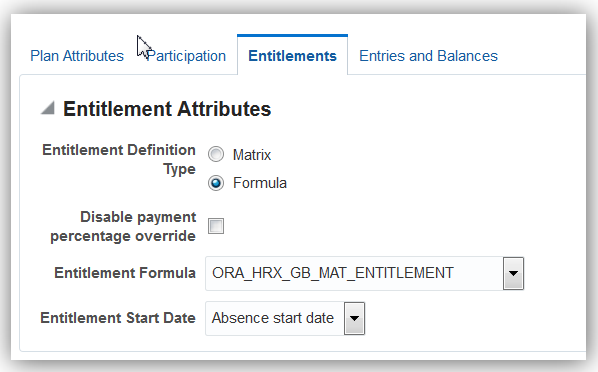
Maternity Leave Absence Plan Entitlement Screen
- Create absence type
- Attach formula to absence type

Maternity Absence Type Attributes Screen
Tips and Considerations
When creating absence set up data, always ensure that the effective date is set to a value which covers the date range of all the absences you wish to create.
The new feature enables you to process shared parental leave eligibility and entitlement. The resulting payment details are then interfaced to payroll for processing and payment.
Use the absence certification functionality to record reasons for denial or nonpayment of a statutory absence.
With the shared parental leave feature, you can:
- Check that the employee satisfies the eligibility conditions to be entitled to shared parental leave, that is, has the required length of service.
- Ensure that the maximum entitlement is not exceeded.
- Allow recording of an agreement and the actual absences against the agreement.
- Allow recovery of monies from HMRC at the appropriate rate.
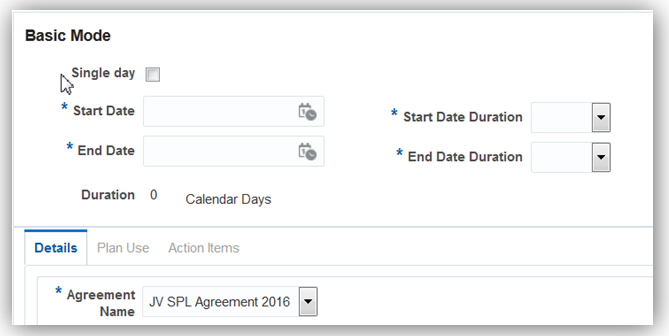
Shared Parental Leave Absence Record
Steps to Enable
The following steps are required to use the feature:
- Create payment rate definitions
- Create payroll element for payment details
- Create recovery rates
- Create absence plan
- Attach formula to absence plan
- Create absence type
- Attach formula to absence type
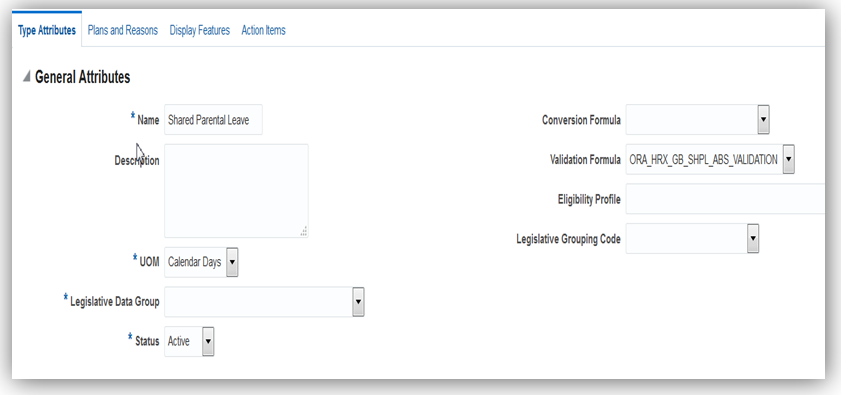
Shared Parental Leave Absence Type
- Create leave agreement templates

Shared Parental Leave Agreement Template Screen
Tips and Considerations
When creating absence set up data, always ensure that the effective date is set to a value which covers the date range of all the absences you wish to create.
Add Support for BACS Processing Date to BACS Flow
The new parameter BACS processing date is a mandatory parameter added to the Make EFT Payments process. You must set the date to one working day prior to the day when payment will be made to the person’s bank. The date must not be a public holiday or weekend.
This date renders in the BACS file as the BACS processing date. The overriding payment date is still available. To change the payment date (as defined on the payroll calendar), you can enter that date here. It will appear as the payment date on payslip and other reports.
Steps to Enable
There are no steps necessary to enable this feature.
TIPS AND CONSIDERATIONS
If you enter an overriding payment date, you must also enter a corresponding BACS processing date, for example, the working day before the overriding payment date.
Court Orders Reference List of Values Available
When you create a new court order, the reference that you enter against the court order will be available on the adjustment element as a list of values in the reference field. The field contains the list of unique court order references for the payroll relationship. You can select the reference relevant for the adjustment element.
Steps to Enable
There are no steps necessary to enable this feature.
TIPS AND CONSIDERATIONS
For existing court order elements, the reference is not a list of values. To enable the list of values, you can use the value set code ORA_HRX_GB_CO_REF_CODE in the reference input value for the adjustment element.
Test Mode for Start of Year and Tax Code Uplift Processes
Run the Start of Year process and Tax Code Uplift Process in Test mode. This enables you to view the updates to the employees’ tax code prior to running the processes in Live mode.

Submission Type set to Test to Run in Test Mode
Steps to Enable
There are no steps necessary to enable this feature.
Interchange Reference Control Number for Incoming Messages
You can now validate the Interchange Control Reference (ICR) numbers during file upload for incoming HMRC messages such as: P6 P6B P9 EDI Upload Process, NINO Verification Reply and Student Loan EDI Upload Process. This ensures that the incoming messages are uploaded in the sequence in which they are issued by HMRC. Validations include duplicate check as well as a gap in the sequence of the ICR number. You can disable the validations by setting the Validation Interchange Reference parameter to No. You must ensure this is done the first time you upload a file to initialize the ICR on the first run, otherwise the process will fail.
The Upload File task is no longer available. You can now upload the incoming files directly to the UCM server, and pass the Content ID as a parameter to the flow. You can also automatically initiate this from a service flow.

Validate Interchange Reference Parameter

Interchange Control Reference Number
Steps to Enable
There are no steps necessary to enable this feature.
Unique Reporting Reference for New Court Orders
If the court order reference provided by the court is the employee’s NI number, you must use the Reference field to provide a unique reference and the Reporting Reference field to provide the reference as provided by the court. You cannot use the NI number as the Reference as it must be unique.
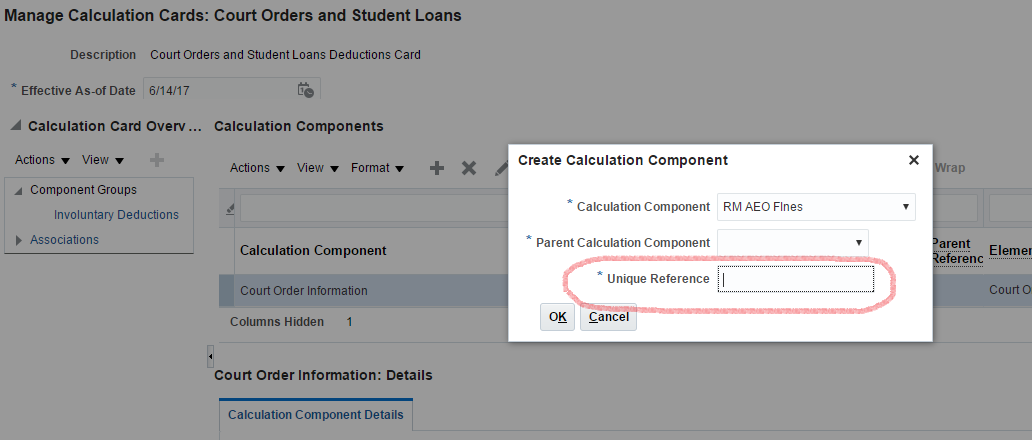
Unique Reference for Court Orders

Reference Provided by Court
Steps to Enable
There are no steps necessary to enable this feature.
Statutory Sick Pay for Employees Working Overnight Shifts
Statutory Sick Pay (SSP) now supports qualifying patterns that includes overnight shifts. When a shift starts and ends on a different day, the day that counts for SSP payment is the day the shift started.
Steps to Enable
There are no steps necessary to enable this feature.
Configure Average Weekly Earnings
Create your own average weekly earnings formula to calculate average weekly earnings. Eligibility to statutory payments is based on the employee’s Average Weekly Earnings calculated over a certain period known as the relevant period. The definition of the relevant period varies depending on the type of absence. It is automatically calculated based on payroll balances. However, there are certain circumstances where this calculation cannot be performed, for example if do not have the required license for payroll application, or for new joiners who have not been processed in payroll during the relevant period. In such scenarios, you can create and plug-in your own user-defined formula to calculate the average weekly earnings.
The payroll application uses the average weekly earnings formula hook in the following scenarios:
- If the license is set to Human Resources or Payroll interface, the formula hook is used for all absence types.
- If the license is set to Payroll:
- For absences related to Maternity, Paternity, Adoption and Shared Parental Leave, you cannot override the calculation using your own formula. This is due to the Definition of the relevant period. If payroll results do not exist for the whole duration of the relevant period, the employee has not met the seniority requirement and therefore should not be entitled to statutory payment. This cannot be overridden by your own formula. Alternatively, you can enter an override amount in the override field on the absence record.
- For sickness absences, if the Employee has less than eight weeks’ worth of payroll results, the AWE calculation has been modified to divide by the number of weeks processed. If the employee has no payroll results, the formula hook is used to calculate the average weekly earnings.
Within your own formula, you can derive the average weekly earnings, based on various sources (for example, salary basis). When you define your own formula, you must ensure that it is compliant with the rules and regulations set by HMRC.
Steps to Enable
Create a formula with the following name: UK_ABSENCES_AWE_OVERRIDE_FORMULA.
Court Orders – DEO Reference Number Output on BACS File
This feature enables you to identify and allocate the court order Deductions of Earnings Order (DEO) deductions made by employer for allocating payments correctly. When you allocate a DEO to an employee, the reference number is shown in the appropriate field of the BACS file payment line.
Where multiple DEOs are present for one employee, you must set up a third-party payee, one for each individual DEO so that this can be displayed on the individual BACS line for the payment. Note that the third-party set up for DEO in such cases should not be used by any other court order for that employee, DEO or otherwise.
Steps to Enable
There are no steps necessary to enable this feature.
Payroll Validation Report – Change to Excel Output
You can download the report results of the Payroll Validation report as an Excel spreadsheet and perform standard excel operations for further processing.
Steps to Enable
There are no steps necessary to enable this feature.
Sexual Orientation and Gender Identity
This feature enables you to add your own list of values for the new field Gender Identity and existing field Sexual Orientation according to your organization’s requirements. The employees can use the Employee Self Service to select the appropriate values for sexual orientation and gender.
The field Gender includes the values Male and Female as these are required by HMRC. You can add more values for selection, as required.
Steps to Enable
There are no steps necessary to enable this feature.
Tips and Considerations
The new field Gender Identity and the existing field Sexual Orientation are delivered with a predefined set of values. You can include additional values to this list according to your requirements.
Errors and Warnings Report in Pension Automatic Enrolment Flow
You can now access the new errors and warnings report within the Pensions Automatic Enrollment process. The report displays the list of issues encountered for employees during the calculation card update process. The description of errors and warnings is also included in the report. You can view this report as part of the output from the process.
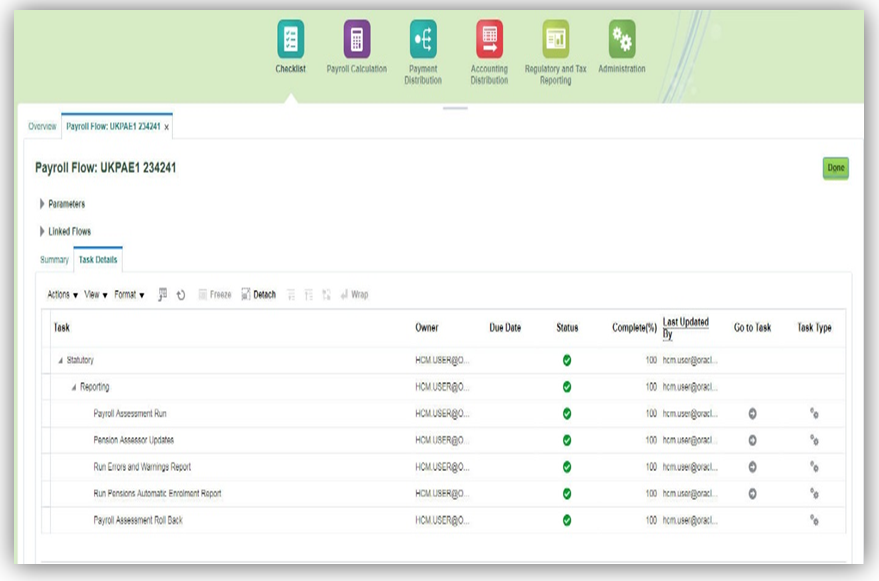
Steps to Enable
There are no steps necessary to enable this feature.
Alabaster Ruling for Statutory Maternity – Pay Rise During Leave
You can adjust an employee’s Statutory Maternity Pay if the employee has received a pay rise during maternity leave. You can make the adjustment either as a monetary value or as a percentage.
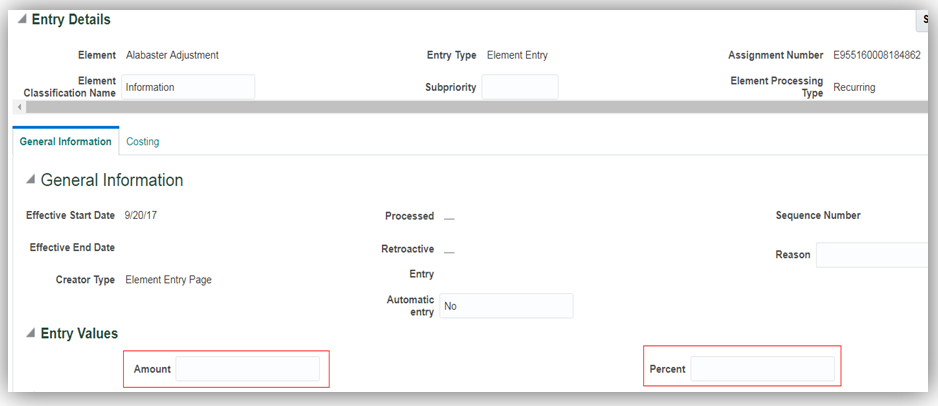
Amount or Percentage Fields
Add the predefined element to the employee by using the element entry functionality.
Steps to Enable
Although the predefined elements are provided, you must create the element eligibility to use the elements.
XML Message Retrieval Support from HMRC Data Provisioning System
You can now use the two new processes to retrieve XML format messages from HMRC’s Data Provisioning Service (DPS) and load this data to update the employee records.
You can retrieve the following incoming XML message types using the retrieve process:
- P6 or P6B
- P9
- NVREP (RTI message)
- Student Loan Start Notice (SL1)
- Student Loan End Notice (SL2)
Prerequisites
Before you start using the process for incoming retrieval, you must set up the tax reporting unit (TRU) related information. Using Manage Legal Reporting Unit HCM Information, set the following attributes for UK TRU RTI Information:
- Enter the following employer RTI credentials
- Sender ID
- Authentication Value
- For each of the supported processes, you must set a current GOT number (high watermark):
- P6 Highest Index Retrieved
- P9 Highest Index Retrieved
- SL1 Highest Index Retrieved
- SL2 Highest Index Retrieved
- RTI Highest Index Retrieved (for NVREP)

HMRC Incoming Data Retrieval Process
The HMRC incoming data retrieval process enables you to retrieve and store your organization data as described below:
- Establishes connection with the HMRC service and verifies credentials
- Sends a request for any new data which is waiting to be sent to the employer from HMRC.
- Receives the XML data and stores it in UCM, ready to be processed by the Load HMRC XML File process
- Updates the GOT number for the relevant message type retrieved.
- flow pattern and the parameters to run the HMRC Data Retrieval Process:
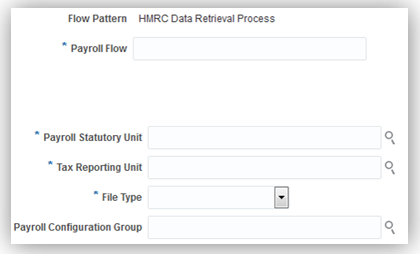
Flow Pattern and the Parameters to Run the HMRC Data Retrieval Process
The file type determines which message type data is requested from the HMRC using the GOT number (from Legal Reporting Unit HCM Information page).
Controlling the Data Volume to Receive
You can control the retrieval of data in terms of how many records should be retrieved each time. Or, the number of iterations the process performs to fetch the data before it consolidates it into a single file for uploading. You can do this by setting the two new action parameters in the Manage Payroll Configuration Process:
- Number of incoming records from HMRC: Indicate the number of records the process should fetch from the HMRC each time.
- Number of times records fetched before upload: Indicate the number of iterations (performed in a loop) to fetch records from the HMRC before consolidating the data into a single file for upload.
If you do not provide the parameters, HMRC has their own default numbers that are used. If the number of records for that employer is lesser than the number you specify in the parameter, HMRC sends the number of records in their system.
Load HMRC XML File Process
The Load HMRC XML File process loads the records fetched from HMRC by the retrieval process and performs the following steps:
- Load the fetched records from HMRC into interface tables;
- Validate the data within the message type against the data in the application
- Report on both validation failures and record updates
- Generate the HDL file with the validated data
- Load the HDL file to update the application data
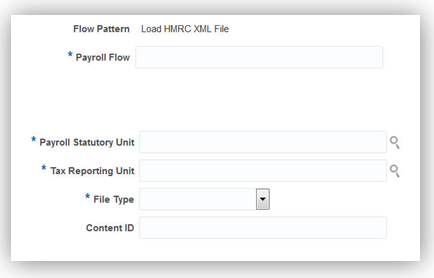
Flow Pattern and the Parameters to Run the Process
You must enter the File Type parameter to indicate the data type being uploaded. The file types listed here are the same as in the retrieval process as shown below:
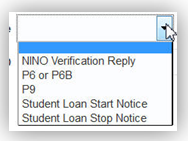
You do not have to provide a UCM ID: by default the process uses the earliest UCM ID that is not processed, that is, loaded for that particular file type. This ensures that files are loaded in the order in which they are received. However, if the exceptional case where you want to load files in a different order, you can provide the UCM ID.
Steps to Enable
There are no steps necessary to enable this feature.
Processing Benefits in Kind Through Payroll
You can process your employees’ taxable benefits in kind through the payroll using the new Taxable Benefits calculation card and its components. Indicate the benefits that you want to process through the payroll at the organization-level and set up the benefits data.
You can change this option to P11D reporting during the year. However, you cannot change the option back to processing through payroll again during the year. You can reset the option for the taxable benefits at the beginning of the new tax year.
You can process employee benefits that have tax implication through payroll (that is, taxable cash equivalent) and the employee is taxed in each period. The taxable income includes the value of taxable benefit.
The benefits are classified into benefit type prescribed by the HMRC as follows:
- Assets transferred
- Payments made on behalf of employee
- Mileage allowance and passenger payments
- Vouchers and credit cards
- Employer provided living accommodation
- Interest free and low interest loans
- Cars and car fuel benefit
- Vans and van fuel benefit
- Private medical insurance
- Qualifying relocation and expenses
- Services supplied
- Assets placed at employee disposal
- Expenses payments made on behalf of employee
- Other items
Organization Information
A new Taxable Benefits calculation card component is available in the tax reporting unit calculation card. Use this to indicate the benefits you want to process through payroll.
You can select all benefit types to process through payroll except the following:
- Living accommodation
- Interest free or Low interest loans
You must still report the exceptions using the P11D at the end of the year as per the HMRC requirement.
If you do not create a calculation component details for Taxable Benefits at TRU-level, no benefits are processed through payroll. You must report them using the P11D at the end of the year.
If you create a calculation component details for Taxable Benefits for any benefit type, but do not indicate an option for any of the benefits listed, they will not be processed through payroll.
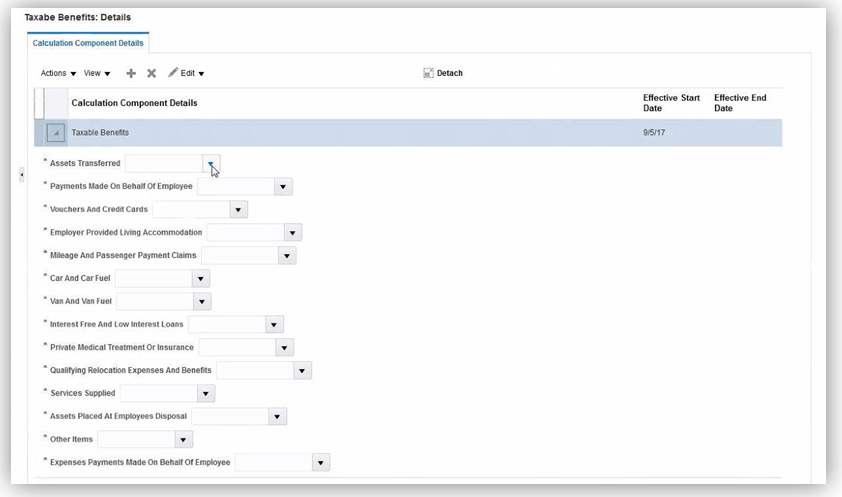
TRU New Calculation Component – Taxable Benefits
Taxable Benefits Calculation Card
You must use the new Taxable Benefits calculation card under the component group Benefits. To process benefits through payroll, the employees must have this calculation card created for them.
Creating the Taxable benefits calculation card
To create the taxable benefits calculation card:
- Select the Manage Calculations Cards task from the Payroll Calculations work area.
- Search for and select the person for whom you want to create the calculation card.
- Click Create:
- Enter the effective date and select Taxable Benefits.
- Click Add to add a calculation component:
- Select the relevant calculation component and enter the component details.
- Click Save.
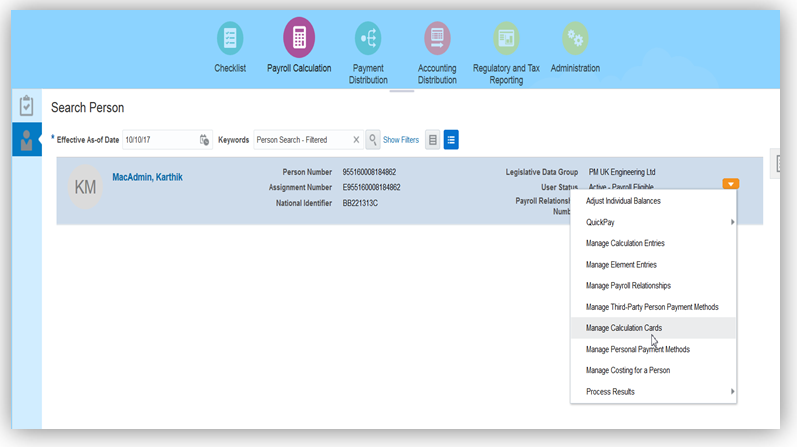
Navigate to => Manage Calculation Cards and Add a Calculation Component.
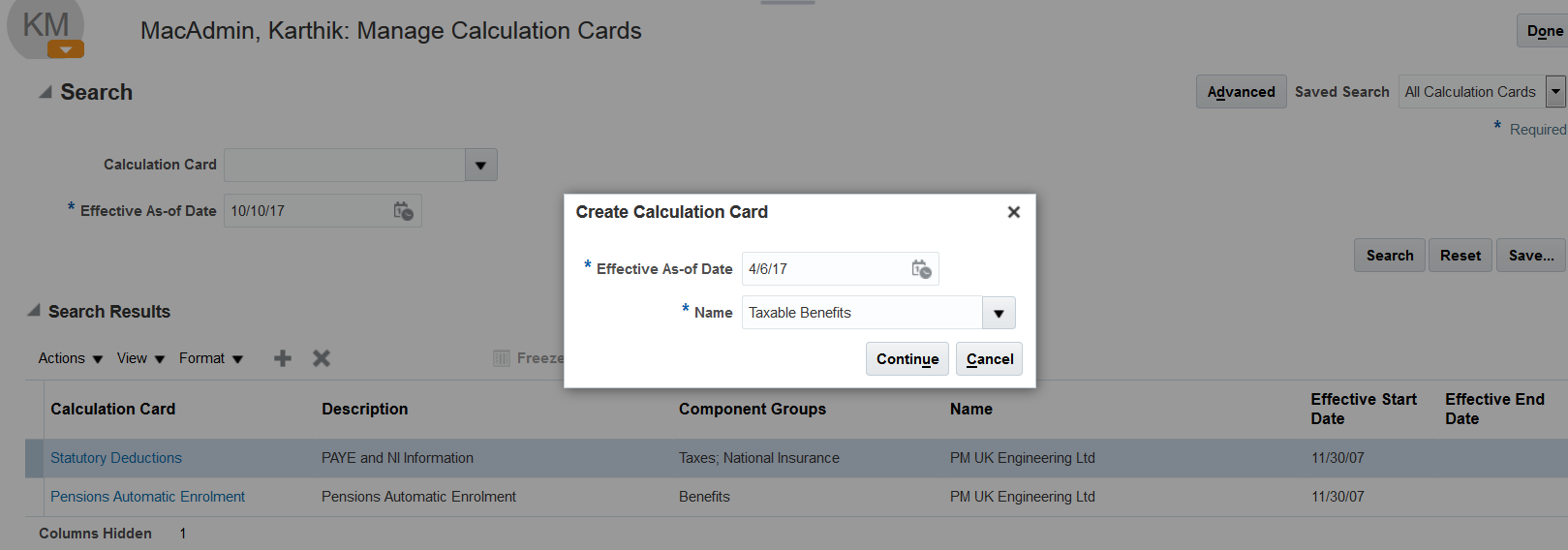
Create Taxable Benefits Calculation Card for the Employee First
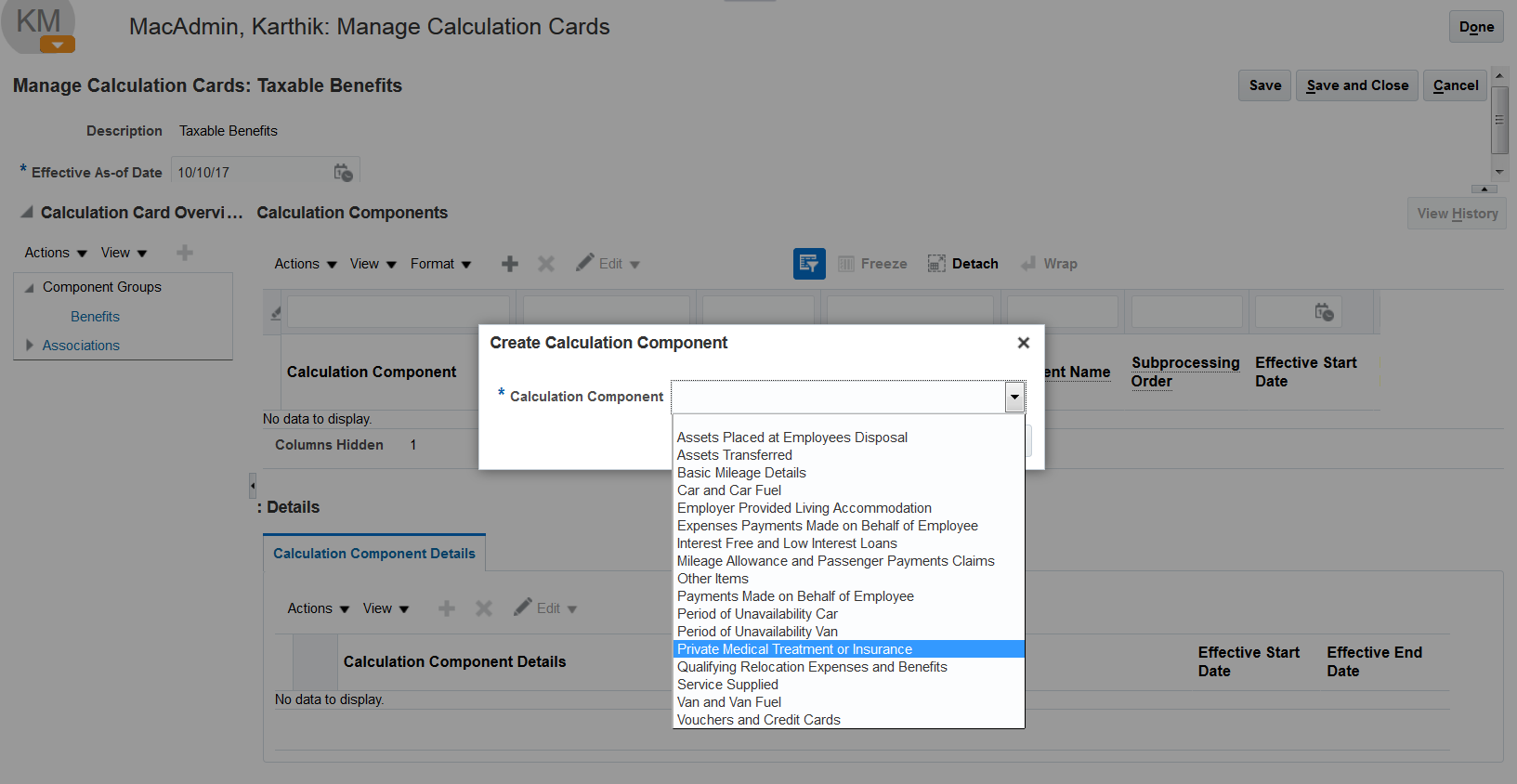
Add the Calculation Component for the Benefit by selecting from the List
Each benefit has its own component details structure to enable you to enter the required information to process that benefit.
When you create a benefit component for the person, an element is also created for each benefit type. One or both of the following two elements entries are created:
- A calculation element (this triggers the formula calculation)
- A results element (this stores the results of the calculations and other relevant information)
Benefits with simple basic information have one element entry – the calculation element, whereas other benefits where interim calculations are performed or rates fetched, for example, have both the above element entries created.
Balances for Benefits in KIND
Each benefit type has a balance delivered in the payroll process. The following is the list of all the balances:
| Balance |
Balance Category |
| Assets Transferred |
Taxable Benefits |
| Payments on Behalf of Employee |
Taxable Benefits |
| Mileage Allowance Taxable Passenger Payments |
Taxable Benefits |
| Mileage Allowance Taxed |
Taxable Benefits |
| Mileage Allowance Taxable Payments |
Taxable Benefits |
| Mileage Allowance Payments |
Taxable Benefits |
| Vouchers and Credit Cards |
Taxable Benefits |
| Car Benefit |
Taxable Benefits |
| Car Fuel Benefit Charge |
Taxable Benefits |
| Van Benefit |
Taxable Benefits |
| Van Fuel Benefit Charge |
Taxable Benefits |
| Private Medical |
Taxable Benefits |
| Qualifying Relocation Expenses and Benefits |
Taxable Benefits |
| Service Supplied |
Taxable Benefits |
| Assets at Employee Disposal |
Taxable Benefits |
| Other Items Class 1A |
Taxable Benefits |
| Other Items Non-class 1A |
Taxable Benefits |
| Entertainment Expense Payments |
Taxable Benefits |
| Payment For Use of Home Phone Expense Payments |
Taxable Benefits |
| Non-qualifying Relocation Expenses Payments |
Taxable Benefits |
| Travel and Subsistence Expenses Payments |
Taxable Benefits |
| Travel and Subsistence Expenses Payments |
Taxable Benefits |
| Other Expenses Payments |
Taxable Benefits |
| Living Accommodation |
Taxable Benefits |
| Interest Free Loans |
Taxable Benefits |
| NIable Earnings for Class 1A NICs |
Total Taxable Benefits |
| Assets Transferred Taxation Period |
Information |
| Payments Made on Behalf of Employee Taxation Period |
Information |
| Vouchers and Credit Cards Taxation Period |
Information |
| Car and Car Fuel Benefit Taxation Period |
Information |
| Van and Van Fuel Benefit Taxation Period |
Information |
| Private Medical Taxation Period |
Information |
| Services Supplied Taxation Period |
Information |
| Assets at Employee Disposal Taxation Period |
Information |
| Other Items Taxation Period |
Information |
| Expense Payment Taxation Period |
Information |
Balance Feeds
To process a benefit through payroll, the benefit types are fed by the relevant balance feeds for appropriate calculations and processing. Balance feeds to other non-benefit type balances ensures that the cash equivalent calculated for a benefit processed through payroll is correctly accounted for tax. Balance feed to the new National Insurance Class 1A balance ensures that the calculation of your employer liability is performed so you have this value to fulfil your obligations of reporting to HMRC.
The following table includes details of the balances that feed each benefit type:
| Benefit Type |
Benefits Taxed through Payroll |
Taxable Pay |
NIable Pay |
NIable Earnings for Class 1A NICs |
| Assets Transferred |
Y |
Y |
N |
Y |
| Payments Made On Behalf Of Employee |
Y |
Y |
N |
N |
| Vouchers and Credit Cards |
Y |
Y |
N |
N |
| Mileage Allowance and Passenger Payments |
Y |
Y |
Y |
N |
| Cars and Car Fuel |
Y |
N |
Y |
Y |
| Vans and Van Fuel |
Y |
N |
Y |
Y |
| Private Medical Treatment or Insurance |
Y |
Y |
N |
Y |
| Qualifying Relocation Expenses |
Y |
Y |
N |
Y |
| Service Supplied |
Y |
Y |
N |
Y |
| Assets Placed At Employee Disposal |
Y |
Y |
N |
Y |
| Other Items |
Y |
Y |
Y |
Y |
| Expenses Payments |
Y |
Y |
N |
N |
Steps to Enable
There are no steps necessary to enable this feature.
Legislative Updates for Tax Year 2018-19
To comply with the legislative updates announced for tax year 2018-19, the following are updated as follows:
- UK PAYE tax rates and thresholds: All allowances and rates for rest of the UK (rUK)
- National Insurance rates and limits: The thresholds for National Insurance contribution calculations, effective 6th April 2018.
- Student Loan thresholds: The new thresholds for student loans
Steps to Enable
There are no steps necessary to enable this feature.
XML Format for RTI Outgoing Files
HMRC is decommissioning the EDI channel for all communications and submission and will only support XML file format transmissions. You must create and send your RTI outgoing files in the XML format for NINO Verification Request (NVREQ).
HMRC File Submission Process
To submit the NVREQ file to HMRC, you must generate a LIVE NVREQ file. You could then send this as either a test file, or as a live file. All new RTI processes delivered for the tax year 2018-19 will generate files for submission only in XML format. You must first run the required RTI process to generate the file for submission.
Once the data file has been generated from your RTI processes for NINO Verification (NVREQ), you can then run the new process HMRC File Submission Process. This process prepares and sends the XML file using the government gateway.
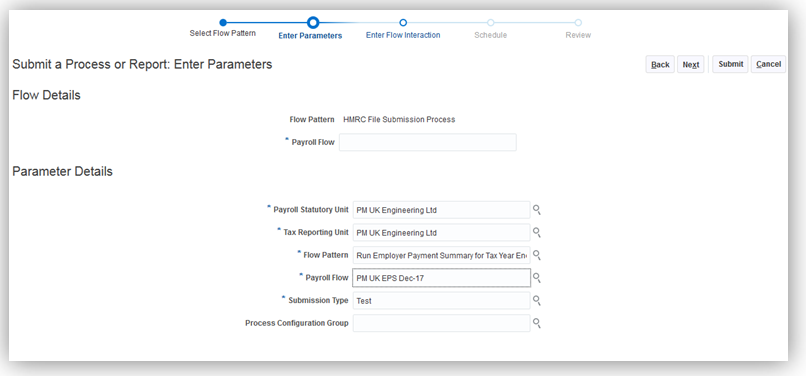
The HMRC File Submission process enables you to do the following:
- Prepare the XML from source file for submission, including compression (for FPS & EYU only)
- Submit the XML file to HMRC’s Government Gateway portal
- The process handles potential connection failures and re-submission. If HMRC reports a successful submission, the process archives the Correlation ID returned from HMRC (along with the endpoint URL, and the file Class). It also waits for the poll interval advised by HMRC’s response (typically 10 seconds).
- Poll the HMRC gateway portal for confirmation of successful submission, using the file Class and Correlation ID (previously archived).
- The process handles potential connection failures and keeps on polling until confirmation is received. Upon confirmation, it stores the response XML (comprising digital signature) and messages
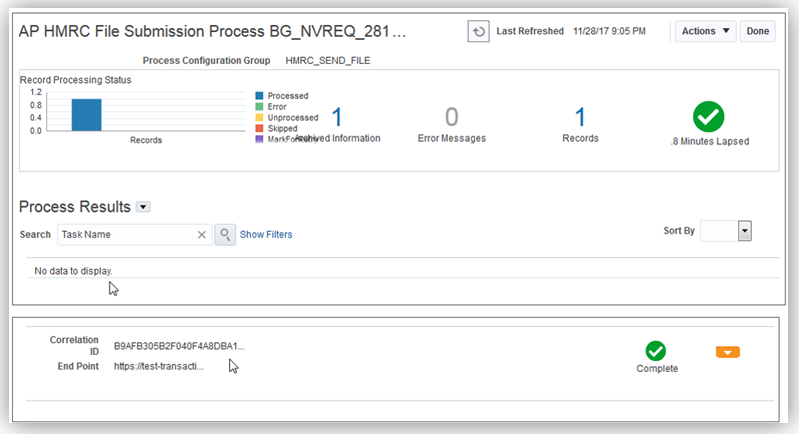
You can use the retry option, if required. On retry, if a Correlation ID is present in the archive, the process will skip the submit phase and will resume from the poll phase.
Steps to Enable
There are no steps necessary to enable this feature.
Benefits in Kind – Car and Car Fuel Rates for Tax Year 2018-19
To process calculations for car or van through payroll, new rates for car and car fuel and van and van fuel will be applied with effect from April 2018.
Updates related to car and car fuel benefits, and van and van fuel benefits are available for the tax year 2018-19:
- Car CO2 emission rates
- Cars registered on or after 1 January 1998 without approved CO2 emissions
- All cars registered before 1 January 1998
- Van benefit charges
Steps to Enable
There are no steps necessary to enable this feature.
You can now comply with the legislative requirements for the tax year 2018-19.
Scottish Rate of Income Tax (SRIT)
The following is a summary of budget changes delivered for the SRIT:
- Tax Rate Changes
- Starter Rate set to 19% for earnings up to £2000
- Basic Rate set to 20% for earnings between £2001 to £12,150
- Intermediate Rate set to 21% for earnings between £12,151 to £32,423
- Higher Rate set to 41% for earnings between £32.424 to £150,000
- Additional Higher Rate set to 46% for earnings over £150,000
- Basic Personal Allowance
- The basic personal allowance is the same as that for the rest of the UK (rUK), which is increased to £11,850.
- You must perform a bulk uplift of tax codes to handle this increase while running the Start of Year process.
- Emergency Tax Code
- There is no emergency tax code for Scottish tax payers.
NOTE: The above bands refer to the actual amount of taxable income, which is subject to each of the rates
Statutory Payments
The thresholds for statutory payments are updated for the tax year as follows:
| Statutory Payment Type |
Weekly Amount (£) |
| Statutory Sick Pay (SSP) |
92.05 |
| Statutory Maternity Pay (SMP) |
145.18 |
| Statutory Paternity Pay (SPP) |
145.18 |
| Statutory Adoption Pay (SAP) |
145.18 |
| Shares Parental Pay (ShPP) |
145.18 |
Pensions Automatic Enrolment
The thresholds for Pensions Automatic Enrolment are updated for the tax year:
- Qualifying Earnings Lower Thresholds (used for assessing Jobholder status)
- Weekly = £116
- Calendar Monthly = £503
- Annual = 6032
- Qualifying Earnings Upper Thresholds (used for assessing Jobholder status)
- Weekly = £892
- Calendar Monthly = £3863
- Annual = 46350
- Earnings Trigger for Automatic Enrolment remain unchanged for tax year 2018-19.
NOTE: Biannual, Fortnightly, Lunar Monthly, and Quarterly Lower and Upper thresholds are also updated.
Real Time Information – New Processes for 2018-19 and Support for XML
The following new processes are available for Real Time Information:
- Run Full Payment Submission for Tax Year Ending April 2019
- For submissions relating to Tax Year 2018-19
- Run Employer Payment Summary for Tax Year Ending April 2019
- For submissions relating to tax year 2018-19
- Run Earlier Year Updates for Tax Year Ending April 2018
- For submissions relating updates to previous tax year (2017-18) only
As HMRC will decommission the EDI channel, all the new processes now generate the data files in the XML format:
- All Earlier Year Updates (EYU) processes supported for previous tax years will generate XML format files
- Full Payment Submission (FPS) and Employer Payment Summary (EPS) for tax year 2017-18 will generate files in XML as well as EDI formats.
Steps to Enable
There are no steps necessary to enable this feature.
Support for XML Format Submission for all RTI Outgoing Files
HMRC will decommission the EDI channel for all communications and submission and will only support XML file format transmissions. You will now be able to create and send your RTI outgoing files in XML format for all your outgoing RTI files.
Full Payment Submission (FPS), Employer Payment Summary (EPS), Earlier Year Updates (EYU), and NINO Verification Request (NVREQ) will generate XML files. You can use the generic process that submits the files to HMRC gateway.
The XML File Submission Process
Once the data file is generated from your RTI processes, you can run the new HMRC File Submission Process. This process prepares and sends the XML file using the government gateway.
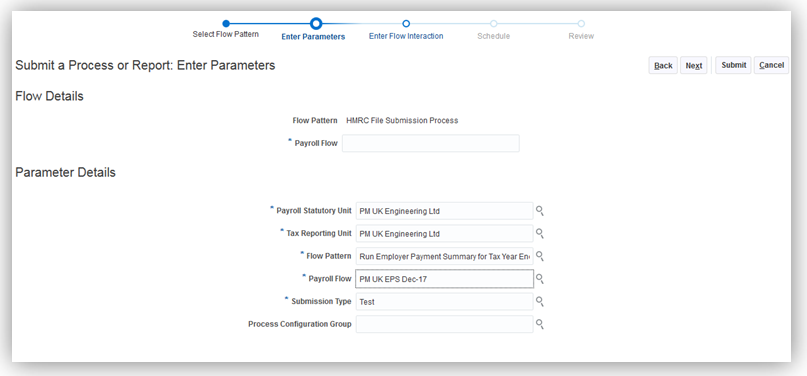
The process performs the following actions:
- Prepares XML from source file for submission
- Compression is supported for FPS & EYU
- Submits the XML file to HMRC’s Government Gateway portal
- Handles potential connection failures and re-submission
- If HMRC reports a successful submission then the process will:
- Archive the Correlation ID returned from HMRC (along with the endpoint URL, and the file class)
- Wait for the poll interval advised by HMRC’s response (typically 10 seconds)
- Polls the HMRC gateway portal for confirmation of successful submission, using the file Class and Correlation ID (as archived previously)
- Handles potential connection failures etc. and keeps on polling until confirmation is received
- When confirmation is received, it stores the response XML (comprising digital signature) and messages
Process Parameters
You must run the new HMRC File Submission Process with the following mandatory parameters:
- Payroll Statutory Unit
- Tax Reporting Unit
- Flow Pattern
- Enter RTI process (for example, NVREQ)
- Payroll Flow
- Enter the flow pattern for the RTI process
- Submission Type
- Specify whether this a Test or Live submission. If you set it to Test, it appends the Test-in-Live flag to the file. If you set it to Live, it interlocks all the source archive child. It also prevents subsequent resubmission using a new submission process.
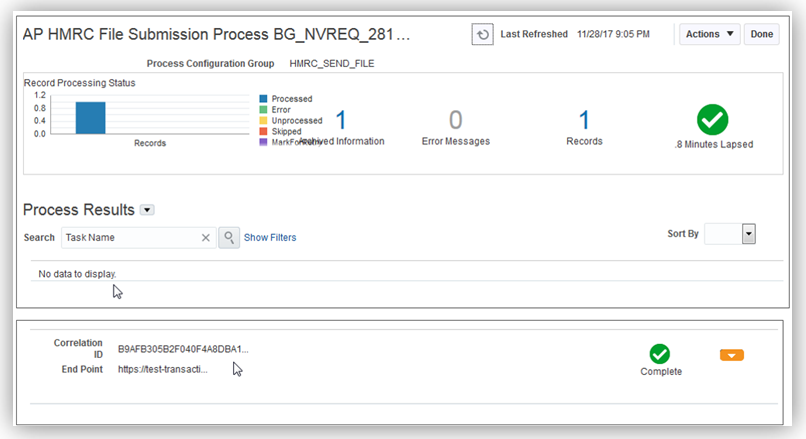
Viewing the Results of the Process
Steps to Enable
There are no steps necessary to enable this feature.
Full Payment Submission (FPS) Breakdown to Smaller Files
You can now create smaller files from Full Payment Submission (FPS) to aid the reconciliation of FPS submissions. To do this, you can create a lookup of Unique IDs and use this at the tax reporting unit (TRU) level to enable FPS process separate files for groups of employees.
To assign a TRU Unique ID to employees for a Statutory Deductions calculation card, create an association for the Unique ID required from the lookup list:
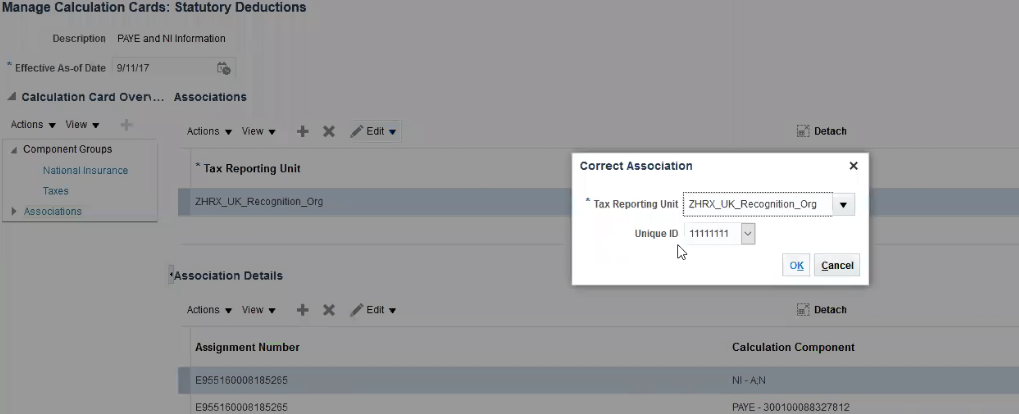
This controls the batch or unique ID in where the employee is reported.
The Full Payment Submission (FPS) process has a new parameter called Unique Part Identifier with the list of values from the lookup created for your Unique IDs:
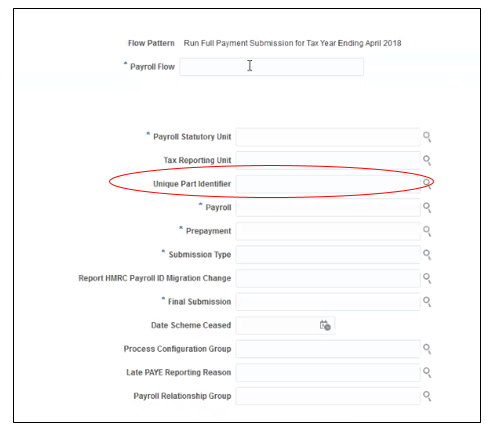
Select the required Unique ID for which you wish to create the FPS output file when running the Full Payment Submission (FPS) process. This will select all the employees who have this Unique ID assigned and create the FPS output for only those employees.
Steps to Enable
To enable the list of values for the Unique IDs:
- Select the Manage Legal Reporting Unit HCM Information task.
- Select Organization Information EFF for UK Tax Reporting Unit Details:
- Enter the name in the Unique ID List field:
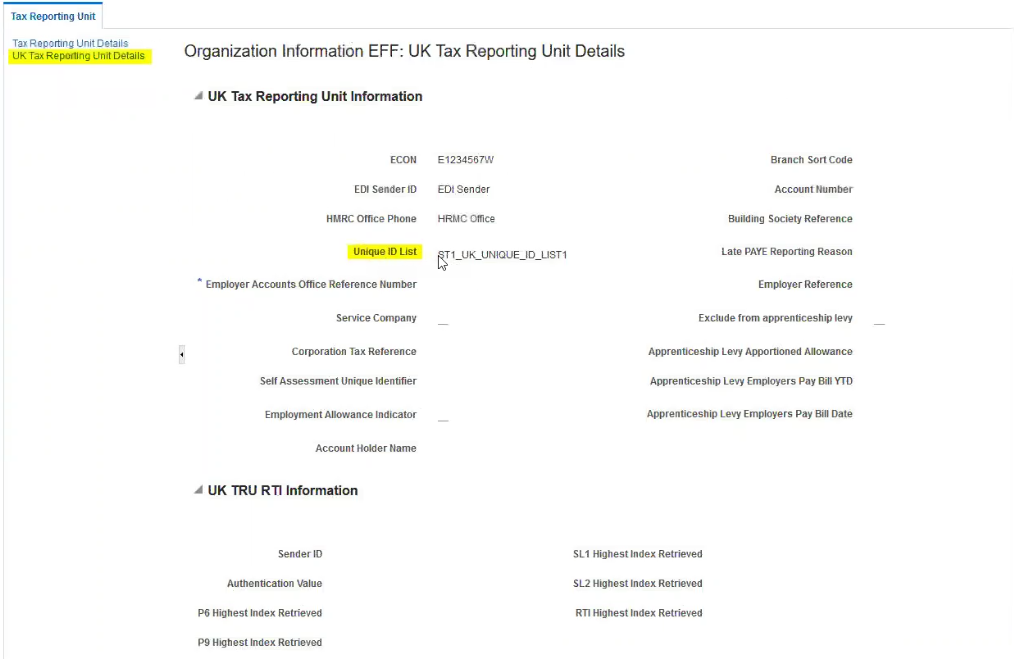
Tips and Considerations
The lookup table contains one predefined value of ‘Unassigned Unique ID. If you select this value, FPS will select all employees with no unique ID entered on their statutory card’s association with the TRU. This means you do not need to assign any unique ID to your population, and the FPS will run for the whole population.
You can use the new process Run UK Gender Pay Gap Report to extract data into a comma-separated values (CSV) file to calculate gender pay gap figures.
The following predefined balances are available for this process:
- Gender Pay Gap Reporting Ordinary Pay
- Gender Pay Gap Reporting Bonus Pay
To maintain these balances, you must setup the balance feeds from the relevant elements.
Steps to Enable
There are no steps to enable this feature.
Scottish Income Tax Rates and Bands
You can comply with legislative changes announced by the Scottish Government recently for the tax bands for the year 2018-2019. The changes announced apply to the intermediate and higher rate bands as follows:
Scottish Rate of Income Tax (SRIT) Tax Bands
| Rate |
Percentage |
Taxable Income (£) |
| Starter Rate |
19 |
0 - 2,000 |
| Basic Rate |
20 |
2,001 – 12,150 |
| Intermediate Rate |
21 |
12,151 – 31, 580* |
| Higher Rate |
41 |
31,581 – 150,000 |
| Top Rate |
46 |
Above 150,000 |
*The original proposed value was £32,423, but this was revised recently.
All other SRIT changes were previously included in Release 12, March Monthly Update.
Steps to Enable
There are no steps to enable this feature.
P11D- Employee Benefits and Expenses Reporting
You can use the new processes for calculating the cash equivalent values for your employee benefits and expenses to report on the P11D statements. In addition, you can also transmit this information in the form of an XML file to HMRC.
You must send your P11D(b) employer declaration together with the P11D employee data in the same file. Functionality has been added to allow you to modify the P11D(b) information before you submit the P11D data to HMRC.
The following new predefined processes are available:
- Run P11D Archive and Generate Reports
- Generate Paper P11D
You can leverage these processes to produce P11D reports, both online and PDF versions. The processes also generate the XML file with employee data and the P11D(b) employer declaration data that you can submit to HMRC.
You can run the process Run P11D Archive and Generate Reports to process the information entered on the Pensions and Benefits calculation card and card components. This data is used to produce the P11D employee statements, P11D(b) employer declaration, and to generate the XML file for transmission.
You must set the following parameters to run this process:
- Payroll Statutory Unit
- Tax Reporting Unit
- Date in Tax Year
- Payroll Relationship Group
- Process Configuration Group
There are a set of manual tasks on this process that must be set as complete as described:
- Archive P11D
- Creates the P11D and P11D(b) audit reports
- Generates the XML file
- Run P11D Errors and Warnings Report
- Generates the Errors and Warnings report
- View P11D Audit Reports (manual task)
- Mark this as complete when you have checked all the audit reports
- Generate Online P11D
- This is an administrator task that is required and does not generate the actual P11D
- Enter and Confirm P11D(b) Adjustments (manual task)
- Enter any P11D(b) adjustment on the organization calculation component P11D(b) Adjustments
- Then you can mark this task as complete to complete the remainder of the tasks
- Apply P11D Adjustments
- This applies the adjustments to the P11D(b) record for output to the XML generated in the next step
- Generate P11D XML
- Generates the XML file for employee data and P11D(b) information
- Generates Audit report for P11D(b)
- Generates the Online P11D statements and Worksheets – This is displayed on Document Records for employee access.
Once the XML file for P11D is generated, you can send it using the HMRC File Submission Process. The process is updated to show the P11D Archive and Generate Reports payroll flow in the Flow Pattern parameter.
Run the process Generate Paper P11D to produce P11D employee statements and P11D(b) as a PDF file for printing.
You must set the following parameters to run this process:
- Payroll Statutory Unit
- Tax Reporting Unit
- Payroll Flow
- Payroll Relationship Group (for a set of employees)
- Include Leavers (to include leavers for paper P11D)
- Delivery Preference (to indicate if the delivery preference set up at Document Records or if TRU is to be used)
- Process Configuration Group (to log system information, do not enter a value unless advised by Oracle Support)
You can use the PDF file from this process to produce paper copies for your employees, as required.
The predefined templates for P11D statement and Worksheets are used.
Steps to Enable
There are no steps necessary to enable this feature.
Human Capital Management for the United States
Oracle Fusion HRMS (US) supports United States-specific features and functions for United States. It enables users to follow the United States’ business practices and comply with its statutory requirements.
Electronic Income Withholding Orders Inbound Process
You can now receive and process e-IWO inbound support orders issued by state authorities. Once imported into storage tables, you can run the new Run e-IWO Process.
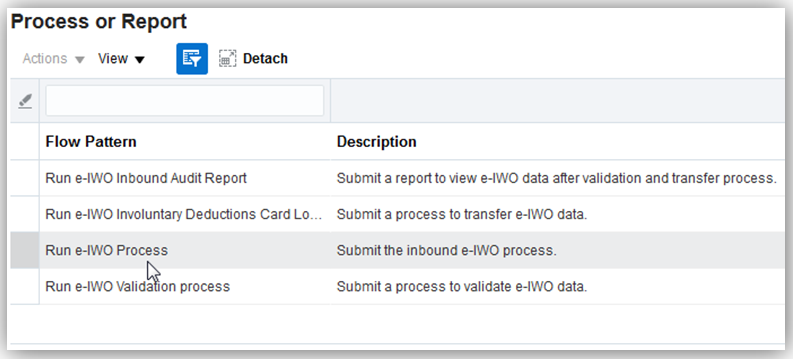
Running e-IWO Process
This process:
- Validates the support orders
- Transfers the valid orders to the employees’ Involuntary Deductions cards and card components
- Generates a report
This report consists of four Microsoft Excel worksheets:
- e-IWO Summary: Provides an overall summary of the processed inbound order file.
- HCM Data Loader Summary Report: Lists details on the orders loaded into the storage tables.
- Audit Report: Lists all valid and transferred orders.
- Exception Report: Lists all failed orders.
An email notification notifies parties when the inbound process is completed.
Steps to Enable
There are no steps necessary to enable this feature.
EFT Payments Now Include a Reference ID
You can now automatically capture reference ID information for EFT payments. The Payment Reference field in the Make EFT Payments process now displays the payroll relationship action ID. This provides a unique reference number for each payment.
Steps to Enable
There are no steps necessary to enable this feature.
Enhanced Deductions At Time of Writ Support
You can now include the following time of writ deduction overrides for your federal tax levy calculations:
- Tax Levy Deductions At Time of Writ Pretax Amount
- Tax Levy Deductions At Time of Writ Pretax Percentage
- Uses the Gross Earnings balance for the calculation.
- Tax Levy Deductions At Time of Writ After-Tax Amount
- Formerly named Tax Levy Deductions At Time of Writ
- Tax Levy Deductions At Time of Writ After-Tax Percentage
- Uses the disposable income derived for the Federal Tax Levy for the calculation.
- Tax Levy Deductions At Time of Writ Deferred Compensation Percentage
- Uses the Deferred Compensation 401K Eligible Earnings balance for the calculation
Steps to Enable
There are no steps necessary to enable this feature.
Key Resources
For more information about this, go to My Oracle Support and search for the following paper:
- Oracle Fusion Human Capital Management for United States: Payroll Involuntary Deductions Document ID 1597039.1
Enhanced Form 1494 Exemption Amount Derivation
Augment your federal tax levy processing through the calculation of your Form 1494 exemption amounts. The payroll process now uses the year you specify on the “Statement of Exemption Received Date” to determine these amounts.
Steps to Enable
There are no steps necessary to enable this feature.
Tips and Considerations
Before you can use this feature, you must create a new Federal Tax Levy element and a new involuntary card component. Existing Federal Tax Levy elements continue to use the year from the current payroll period to retrieve Form 1494 exemption amounts.
When creating the new card component, you must update the total owed override to reflect any amounts already paid from the existing card component.
If you are using the Third-Party Involuntary Payments interface, ensure the Third-Party Involuntary Deduction Number is the same on both the existing and new Federal Tax Levy card components. If you choose to create a new card component using a new Federal Tax Levy element, you must end-date the existing card component.
Key Resources
For more information about this, go to My Oracle Support and search for the following paper:
- Oracle Fusion Human Capital Management for United States: Payroll Involuntary Deductions Document ID 1597039.1
Involuntary Deductions Subprocessing Order Defaults
This feature will help you automatically assign subprocessing orders to your involuntary deductions. When you define an involuntary deduction and create the card component, the subprocessing order of the deductions is automatically determined by its involuntary deduction type. You still have the ability to override the subprocessing order. The default order will be:
- 100 Support Orders
- 200 Bankruptcy Orders
- 300 Federal Tax Levies
- 400 State Tax Levies
- 500 DCIA
- 600 Educational Loan
- 700 Garnishments
- 700 Creditor Debt
- 900 Employee Requested
Steps to Enable
There are no steps necessary to enable this feature.
Key Resources
For more information about this, go to My Oracle Support and search for the following paper:
- Oracle Fusion Human Capital Management for United States: Payroll Involuntary Deductions Document ID 1597039.1
You will find it quicker to perform your VETS-4212 Report analysis through the new Audit Detail report. This comma-delimited Audit Detail report provides details on the employee information included in the Audit Summary report.
Steps to Enable
There are no steps necessary to enable this feature.
Electronic Income Withholding Orders Inbound Process Enhancements
We have made it easier for you to fine-tune the processing of your electronic income withholding orders (e-IWOs) through the new “e-IWO Processing Overrides Formula”. This fast formula enables you to enforce advanced calculation rules in the following areas:
- Override the orders’ sub processing priority.
- Generate a deduction number for each deduction.
- Set a new start date for all new orders, regardless of when you received them.
- Determine the obligor's withholding amount, based on the amount and frequency information provided in the initial e-IWO, and load the amount into their Involuntary Deductions card.
This overrides the default value specified in the e-IWO Employer Configuration Settings user-defined table. If no value is provided, the sub processing priority is determined by the involuntary deduction secondary classification. Use this formula for more complex derivation of the sub processing priority value.
This is the third-party lien number and is not specific to e-IWOs. It is a unique 2-digit number representing the deduction. This number increments whenever the employee incurs a new deduction, such as 01, 02, 03, and so on. The third-party involuntary payment process uses this number.
The default behavior uses the e-IWO income withholding start date. The formula can be used for complex derivation rules for the start date.
The default behavior is to load the Obligation Total Amount and Obligation Total Frequency Code from the e-IWO inbound file. Use the formula to load the total withholding amount override from the Income Withholding Deduction <frequency> Amount from the e-IWO inbound file. It uses the frequency amount based on the employee’s payroll frequency.
To use this formula:
- Start the Manage Fast Formulas task from the Payroll Calculations work area.
- Search for and open the e-IWO Processing Overrides Formula template.
- Copy its contents.
- Open a new formula, and paste in the template formula.
- Edit the formula to fulfill your business needs.
- Save the formula under a unique meaningful name.
- Configure the user-defined tables to use your formula.
Steps to Enable
There are no steps necessary to enable this feature.
Key Resources
For more information go to My Oracle Support for the following document:
- Oracle Fusion HRMS (US): Electronic Income Withholding Orders Processing Guide (Doc ID 2238172.1)
Or Application Help for the following topic:
- Application Configuration for Electronic Income Withholding Orders: Points to Consider
Absence Element Template Enhancements
We have made it easier for you to define Absence elements through the enhanced Absence Element Template. When using the Manage Elements task, you are no longer required to create separate absence payment elements when setting up an absence. The Absence element is now also the payment element.
Steps to Enable
There are no steps necessary to enable this feature.
Key Resources
For more information go to My Oracle Support for the following document:
- Oracle Fusion HRMS (US): Setting Up Absence Elements for Oracle Fusion Absence Management for Release 12 and later (Document ID: 2308118.1)
Third-Party Periodic Tax Filing Audit Report Detail Enhancements
We have made it easier for you to generate the third-party tax filing audit report detail. You can now run it stand-alone by selecting Run Third-Party Tax Filing Audit Report Detail from the Checklist or Regulatory and Tax Reporting work areas.

Run Third-Party Tax Filing Audit Report Detail
You can run this process by:
- Date range
- Specific periodic tax filing extract flow name
- Specific TRU
- Specific employee
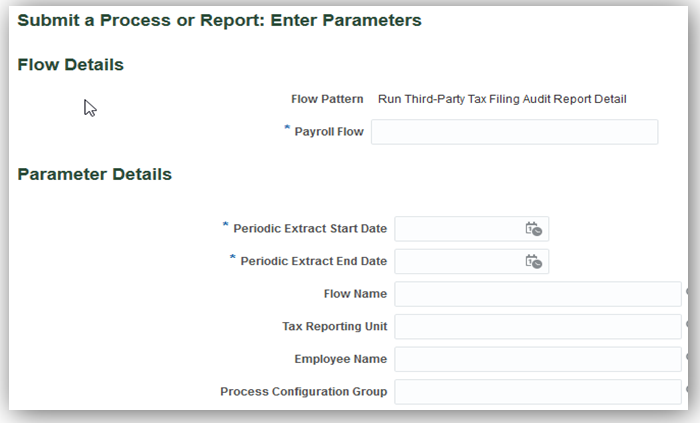
Run Third-Party Tax Filing Audit Report Detail Parameters
Steps to Enable
There are no steps necessary to enable this feature.
Tips and Considerations
The detail audit report can still be generated as part of the Third-Party Periodic Tax Filing Extract by specifying Yes on the Create Employee Detail Report parameter. Run the audit report detail standalone through this new process when you have a large number of employees to process.
Key Resources
For more information on Third-Party Tax Filing go to My Oracle Support for the following document:
- Oracle Fusion Human Capital Management for United States: Third-Party Tax Filing (Document ID 1594079.1)
Third-Party Quarterly Tax Filing Extract Enhancement for Amended Quarter Filings
We have augmented your third-party quarterly tax filing with the addition of new parameters:
- Submission type
- Issue identification date
- Reason codes 1 through 10
- Special instructions needed
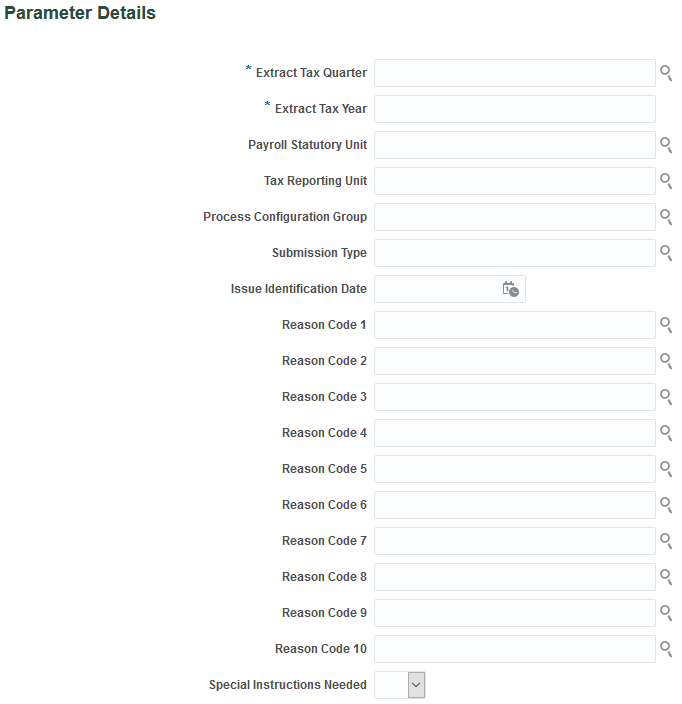
Third-Party Quarterly Tax Filing Parameters
Steps to Enable
There are no steps necessary to enable this feature.
Tips and Considerations
Use Submission Type to identify the type of quarterly file being sent:
- Original
- No additional parameters required.
- Amendment File
- For this type, you must also specify an issue identification date, appropriate reason codes (up to 10 entries), and any special instructions.
- Exception Late Original File
- No additional parameters required.
- W-2 Management File
Specifying an issue identification date, appropriate reason codes (up to 10 entries), and any special instructions is not required but is recommended.

These validations are performed by the supplier and may require resubmission of your file if the appropriate parameters are not populated correctly. For further details on these parameters for closed quarter filings, see your third-party supplier documentation. Additionally, you can contact your third-party account manager.
For more information on Third-Party Tax Filing go to My Oracle Support for the following document:
- Oracle Fusion Human Capital Management for United States: Third-Party Tax Filing (Document ID 1594079.1)
Third-Party Quarterly Tax Filing Extract Supplier Enhancements for Fourth Quarter
We have augmented your third-party quarterly tax filing with support for 4th quarter changes mandated by your supplier. This includes passing new W-2 box records for US Box 12 Code FF and Puerto Rico Box 16 Code F. In addition to these supplier changes, the third-party quarterly tax filing audit report has been enhanced to include the work PSD code for PA Act 32 jurisdictions.
Steps to Enable
There are no steps necessary to enable this feature.
Key Resources
For more information on Third-Party Tax Filing go to My Oracle Support for the following document:
- Oracle Fusion Human Capital Management for United States: Third-Party Tax Filing (Document ID 1594079.1)
Employee Active Balance Report Enhancements to Include New Balances
We have augmented the Employee Active Payroll Balance report with the following new balances:
- Resident and nonresident balances at the city and county balance levels
- New Pennsylvania Locals balance level
This includes information specific to the PA Act 32 local balances, such as the tax collection district code and the work and resident PSD codes.
- Seven state-level W-2 Territory balances for easier reconciliation of Puerto Rican data
Steps to Enable
There are no steps necessary to enable this feature.
Involuntary Deductions Processing Fee Enhancement
This feature helps you control how processing fees associated with involuntary deductions are deducted during the payroll run. With this enhancement, the payroll process no longer automatically deducts the processing fee when an involuntary deduction isn’t processed during the run.
Steps to Enable
There are no steps necessary to enable this feature.
Key Resources
For more information go to My Oracle Support for the following document:
- Oracle Fusion Human Capital Management for United States: Payroll Involuntary Deductions (Document ID 1597039.1)
You can now easily calculate sick pay for your California commissioned or piece-rate employees. When defining Absence elements, use the new “Relationship 90 Earned Days to Date” balance dimension to pay the proper sick rate to affected employees. This dimension looks at balances based on date earned that include full pay periods within the specified 90-day window.
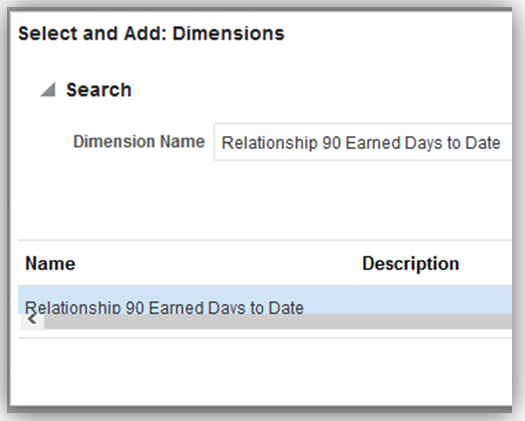
Steps to Enable
There are no steps necessary to enable this feature.
Key Resources
For more information go to My Oracle Support for the following document:
- Setting Up Absence Elements for Oracle Fusion Absence Management for Release 12 and Later. Refer to Appendix F for a worked example. (Document ID 2308118.1)
Electronic Income Withholding Order Reference Code Enhancement
This feature will help you ensure the Reference Codes for your Involuntary Deductions card components are unique. When you load a new inbound electronic income withholding order into the Involuntary Deductions card component, the Reference Code now consists of a concatenation of the following fields:
- Case Identifier
- State Abbreviation
- Remittance Identifier
View the reference code by selecting the link in the Reference column of the Calculation Components table:
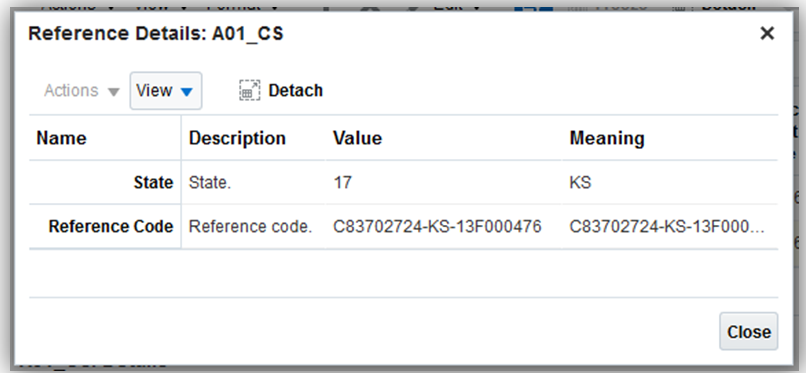
Steps to Enable
There are no steps necessary to enable this feature.
Key Resources
For more information go to My Oracle Support for the following document:
- Oracle Fusion HRMS (US): Electronic Income Withholding Orders Processing Guide (Document ID 2238172.1)
New York Family Leave Insurance Support
We have made it easier for you to calculate New York Family Leave Insurance deductions for eligible employees. The new NY State Disability calculation component enables this deduction at the payroll statutory unit and tax reporting unit levels. All employees associated with those organizations would become eligible.
To begin withholding:
- Start the Manage Legal Entity Calculation Cards or Manage Legal Reporting Unit Calculation Cards task.
- On the NY State Disability Calculation Component, select the Enterable Calculation Values on Calculation Card tab.
- Add the Exempt from Family Leave Insurance component.
- Enter a Value of N.
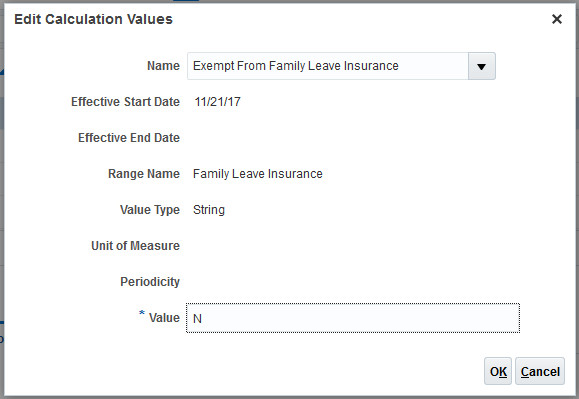
Steps to Enable
There are no steps necessary to enable this feature.
Tips and Considerations
If you have already set up your own Family Leave Insurance deductions for 2017, you must end date those deductions for the last payroll period in 2017 before enabling this deduction.
This feature enables you to process payroll for employees working and living in the territory of Guam.
Steps to Enable
There are no steps necessary to enable this feature.
Tips and Considerations
You must ensure you have correctly configured your organizations for Guam support. For further information, see the Application Configuration for the US Territories: Points to Consider topic in the Help Portal.
Key Resources
For more information go to My Oracle Support for the following document:
- US Implementation and Use White Paper (Document ID 1676530.1)
Run US Tax Balance Adjustment Process
We have made it easier for you to perform FUTA-related tax balance adjustments through the new Run US Tax Balance Adjustment process. When you receive new credit reduction rates for the current calendar year, the payroll process does not self-adjust the taxes for employees that have already reached the FUTA wage limit or for employees that have terminated prior to the rate change. This process performs the tax adjustments on those impacted employees.

Steps to Enable
There are no steps necessary to enable this feature.
Tips and Considerations
This process creates a balance adjustment batch. This batch uses the same name as the adjustment flow. Use Payroll Batch Loader to validate the batch file output by this process.
There is no separate audit report.
Once you have validated the data in your batch file, run the Transfer Batch Process and then the Adjust Multiple Balances process.
Key Resources
For more information go to My Oracle Support for the following document:
- US End-of-Year Processing Guide (Document ID 1944400.1)
We have made it easier for you to perform your year-begin preparations through the updated Run Start of Year Process. This process now provides processing modes to identify 401 (k) limit overrides and exemption details at the federal and state levels.
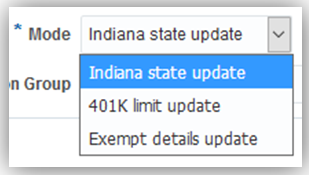
Steps to Enable
There are no steps necessary to enable this feature.
Tips and Considerations
When running this process for 401K limit updates in Final mode, it end dates the override as of 12/31 and creates a new date-effective change as of 1/1.
The Final mode for Exempt details update removes the exempt flag for taxes or wages at the federal and state levels with an effective date of 1/1.
Key Resources
For more information go to My Oracle Support for the following document:
- US End-of-Year Processing Guide (Document ID 1944400.1)
Enhanced Ohio School District Tax Calculation
For Ohio school districts that don’t use the flat rate tax method, the payroll process now determines their taxation based on the allowances you set on the Ohio state component of the employee’s tax card.
Steps to Enable
There are no steps necessary to enable this feature.
Tips and Considerations
Ensure the State tax allowances are up-to-date for the calculation of applicable school district taxes.
Puerto Rico Young Entrepreneurs Act
We have enhanced payroll processing for Puerto Rican employees with support for the Puerto Rico Young Entrepreneurs Act. For all employees meeting the age criteria, this exemption starts immediately for any payroll runs after application of this statutory patch.
With this enhancement, three new calculation value definitions are available:
- Puerto Rico Youth Exempt Maximum Age
- Puerto Rico Youth Exempt Minimum Age
- Puerto Rico Youth Exempt Wage Limit
Steps to Enable
There are no steps necessary to enable this feature.
Tips and Considerations
To ensure the exemption does not impact your remaining payroll runs in 2017 for your eligible employees:
- Start the Manage Calculation Value Definitions task.
- Search for Puerto Rico Youth Exempt Maximum Age calculation value definition with effective as-of date on January 1, 2017 for your legislative data group.
- Select the calculation value definition.
- Under Calculation Values, select Add Row from the Actions menu.
- Use the predefined values for the new row.
- Enter 0 for the Flat Amount.
- Click Submit.
- Set the effective as-of date to December 31, 2017.
- Select the calculation value row for your legislative data group.
- Select End Date from the Actions menu.
- Select Yes on the warning message, and click Submit.
Affordable Care Act Override Upload (United States Customers only)
You generate your 1095-C report for employees once a year in the United States, at the end of the year, but if you implemented Benefits midyear some of the data required for reporting might not be available in the Benefits application. That’s because some of it might still exist in the legacy application. That means that your report might be inaccurate and not show what was offered for a proportion of a year. We now deliver a spreadsheet that enables you to add any missing benefits that you provided in your previous legacy application, and override any incorrect values so you can generate your 1095-C report.
To override or add missing values required in the 1095-C report, go to the Evaluation and Reporting work area, and select the Person Data Loaders tab. A new task called ACA Override Report is available. This task launches a new spreadsheet for you to upload the missing or incorrect data.
- Enter the effective date, which is usually the last day in the year for which you are generating the report, such as 31st December.
- Enter the details for the people missing data, such as the person number, person name and so on. The ACA Report Line Number corresponds to lines in the ACA report that you want to override. For example, Line 14 is Offer of Coverage Line 15 is Employee share of lowest cost, and so on.
- Select the data pertaining to the missing years that you want to upload, and then enter the appropriate values in the months.
- Upload the spreadsheet to apply the changes.
If you need to delete the override, you launch the spreadsheet again, enter the details, such as the person number, person name, ACA report line number, and the year. Then select Yes and upload the spreadsheet.
Steps to Enable
There are no steps necessary to enable this feature.
Role Information
If you are not using the predefined reference roles, then you need to ensure that the transaction analysis duty role that secures the new subject area is mapped to relevant job roles. This table identifies the required transaction analysis duty role and suggests target job and abstract roles. You can add the duty role to different roles if you prefer.
See the Upgrade Guide for Oracle HCM Cloud Applications Security (My Oracle Support document ID 2023523.1) for instructions on implementing new features in existing roles.
|
Transaction Analysis Duty Role |
Job or Abstract Role |
| Manage ACA Upload (BEN_ACA_UPLOAD_PRIV), added to the Benefits Process and Report Administration Duty (ORA_BEN_BENEFITS_PROCESS_AND_REPORT_ADMINISTRATION_DUTY) |
Benefits Administrator and Benefits Manager |
Key Resources
For more information, go to Applications Help for the following topic:
- How do I override or add missing values in the 1095-C benefits report?
e-IWO Enhanced Search Capabilities
We have made it easier for you to search for an e-IWO in the storage table. The new e-IWO search criteria includes the following fields:
- Case Identifier
- Employee SSN
- FIPS Code
- Order Identifier
In the Manage Payroll Interface Inbound Records task of the Payroll Administration work area, select the e-IWO search criteria:
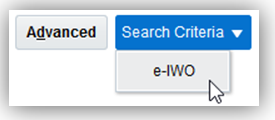
This displays the new fields:

Steps to Enable
There are no steps necessary to enable this feature.
Tips and Considerations
The search results display only the last 4 digits of the SSN (xxx-xx-1234).
Key Resources
For more information go to My Oracle Support for the following document:
- Oracle Fusion HRMS (US): Electronic Income Withholding Orders Processing Guide (Document ID 2238172.1)
Third-Party Periodic Tax FIling Extract Inclusion of Payroll Frequency
The Third-Party Periodic Tax Filing Extract now includes payroll frequency in the output file. If the payroll run includes multiple payroll frequencies for a given periodic date range, the file reports the tax data in separate batches by payroll frequency. The Periodic Tax Filing Audit Reports now include the payroll frequency.
Steps to Enable
There are no steps necessary to enable this feature.
Tips and Considerations
This feature is in support of Employer Service Fees imposed by the cities of Charleston and Madison, West Virginia.
For more information go to My Oracle Support for the following document:
- Oracle Fusion HRMS (US): Electronic Income Withholding Orders Processing Guide (Document ID 2238172.1)
Involuntary Deduction Fee Priority
This feature helps you improve your involuntary deductions processing through enhanced fee calculation. Use the new Calculate Fee after Deduction override for Garnishment and Creditor Debt elements to specify whether the payroll process calculates the processing fees before or after the involuntary deduction.
From the Enterable Calculation Values on Calculation Cards tab for the appropriate involuntary deduction card component, create the Calculate Fee After Deduction calculation value and enter Yes as the value.
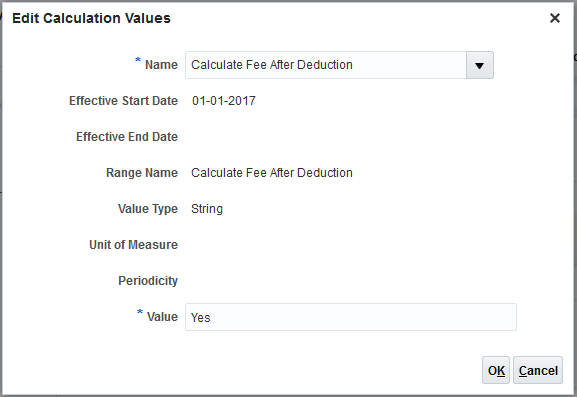
Steps to Enable
You must create a new involuntary deduction element to make use of this override.
Tips and Considerations
Set this override to Yes for states that have a percentage-based processing fee. This ensures the fee calculates on the actual deduction amount calculated instead of the order amount.
Involuntary Deduction Disposable Income Recalculation
You can improve the accuracy of involuntary deductions calculation by electing to recalculate disposable income for select deduction types. By default, the payroll process uses the disposable income of the highest priority involuntary deduction when processing combinations of orders. You can now direct it to recalculate the disposable income for the following deduction types when they are combined with other deductions:
- Educational Loan
- Debt Collection Improvement Act (DCIA)
- Bankruptcy
Steps to Enable
To enable this functionality, perform the following fast formula edits:
- Start the Manage Fast Formulas task from the Payroll Calculation work area.
- Select the formula named <element name>_LEG_BASE.
- Select Edit > Correct.
- Locate the following statement in the formula:
- Immediately after this statement, add the following:
- Save and submit the formula.
- Compile the formula.
For example, if your element is named “Ed Loan”, the formula to modify would be “Ed Loan_LEG_BASE”.
ReferenceCode2 = TO_CHAR(GET_CONTEXT(ELEMENT_ENTRY_ID,0))
WSA_SET(‘WSA_FORCE_RECALC_DI’,’Y’)
Tips and Considerations
If you do not perform these fast formula edits, the payroll process continues to use the disposable income of the highest priority involuntary deduction.
Elements using the Regional Tax Levy secondary classification always recalculate disposable income.
e-IWO Audit Report Enhancement
We have made it easier for you to validate the uptake of inbound electronic income withholding orders (e-IWOs) through an enhanced audit report. This report now includes a check for cases when the issuing state on the order is different from the employee’s work state.
Steps to Enable
There are no steps necessary to enable this feature.
Tips and Considerations
If the report detects such a case, review the employee’s Involuntary Deductions card component details and make any needed modifications.
Key Resources
For additional information go to My Oracle Support for the following document:
- Oracle Fusion HRMS (US): Electronic Income Withholding Orders Processing Guide (Document ID 2238172.1)
Tax Withholding Card Enhancement for Guam
We have updated the Guam regional component of employee Tax Withholding card. You can now make your updates directly on the Guam component rather than on the Federal component.
Steps to Enable
Prior to updating a Guam employee tax cards, you must perform this one time operation:
- Ensure you have the latest tax information from Vertex by running the Load Payroll Tax Information for US process.
- Run the Synchronize Calculation Cards process from the Checklist work area, and select the Synchronize GU Filing status between federal and state components mode.
- Filing Status
- Allowances
- Additional Tax
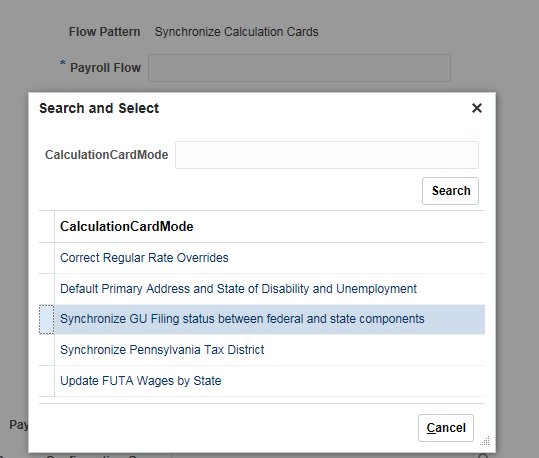
This process copies the following values from the Federal component on the tax card to the Guam component, using the employee’s hire date as the effective date:
No historical data is captured.
These values are valid as of the synchronization process run date.
Key Resources
For more information search for the following topic in Application Help:
e-IWO Inbound Process Enhancement
We have enhanced the processing of electronic income withholding orders (e-IWO) inbound process with new handling of the employee work state. If the issuing state on the incoming order is not the employee’s work state, the inbound process now uses the employee’s work state to create or update the Involuntary Deductions card component.
Steps to Enable
There are no steps necessary to enable this feature.
Tips and Considerations
The storage table now includes an Employee Work State field, derived from the State for Unemployment Calculation on the Federal W-4 card.
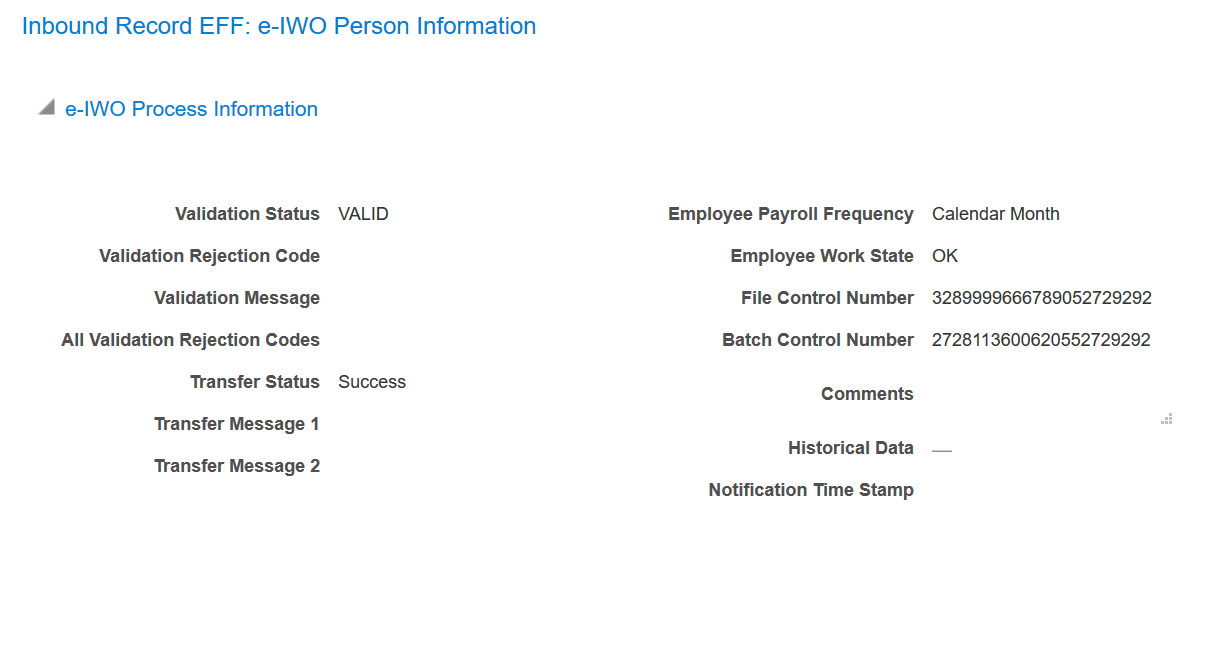
For employees working in multiple states, the process uses the issuing state.
Key Resources
For more information, go to My Oracle Support for the following document:
- Oracle Fusion HRMS (US): Electronic Income Withholding Orders Processing Guide (Doc ID 2238172.1)
Oracle Fusion Global Payroll Interface supports features to send personal payroll information to third-party payroll providers and then to import processed payroll data into Oracle Fusion Global HR. You can copy and modify predefined extract definitions to meet the requirements of your third-party payroll provider. Before extracting data, payroll coordinators can optionally run the Calculate Gross Earnings process to calculate periodic values to validate gross earnings calculations. If you import processed payroll data or payslips from your third-party payroll provider, the data is available for further reporting and analysis.
Use the Manage Payroll Interface Inbound Records task in the Payroll Administration work area to view, edit, and delete imported data including payslip data.
On the Manage Payroll Interface Inbound Records page:
- Filter imported data by using one or more of the following criteria:
- Payroll Name
- Batch Name
- Name
- Record Type
- Person Number
- Record Owner Type
- Select Payroll Data in the Record Type field to view, add, edit, and delete the following information:
- Payroll
- Payment
- Leave
- Messages received from third-party payroll providers
- Select Payslip Data in the Record Type field to view payslip data.
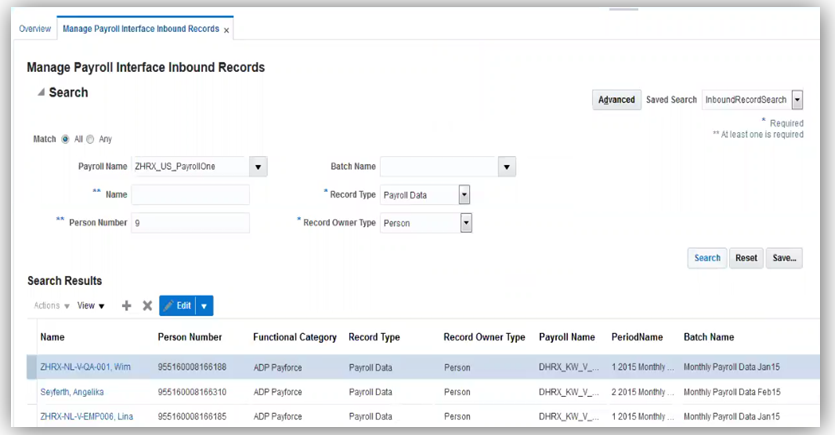
Filter Imported Data
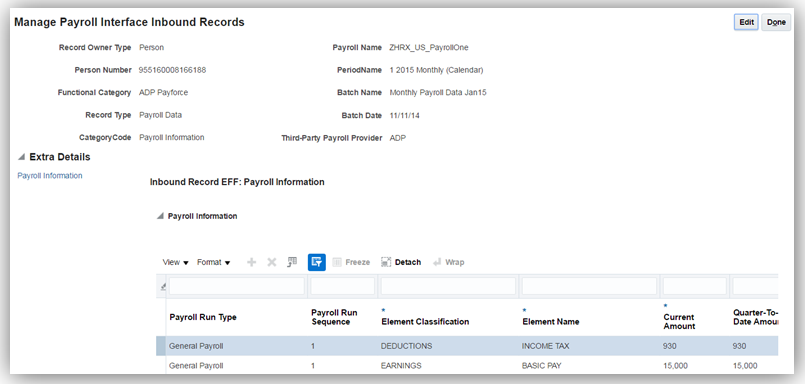
Select Payroll Data in the Record Type field to View, Add, Edit, and Delete

Payment Information

Message Information
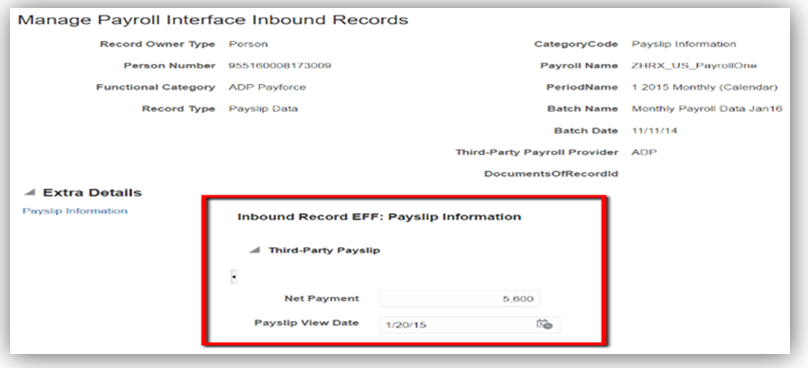
Manage Payroll Interface Inbound Records
Steps to Enable
There are no steps necessary to enable this feature.
Key Resources
For more information about inbound records, go to Applications Help for the following topics:
- Payroll Interface Inbound Records: Explained
- Configuring Extensible Flexfields and Lookups for Inbound Payroll Interface: Procedure
Integration with ADP Global Payroll
The ADP Global Payroll Interface provides a pre-defined point to point integration with ADP Global Payroll. Fusion HCM Cloud customers who wish to have their employees paid through ADP's Global Payroll product can opt to use this delivered integration.
Extended Data Capture for ADP Global Payroll Interface
Customers can use the delivered flexfield segments at Person and Assignment to handle the extended data capture required by ADP Global Payroll.
Follow the steps given below to enable the flexfield segments at Person and Assignment.
- Navigate to the Payroll Checklist work area.
- Click the Submit a Process or Report task.
- Search for Manage Global Payroll Interface Features flow.
- Select the flow and click Next.
- On the flow parameter page, provide a meaningful Payroll Flow Name.
- Click Submit.
- Repeat steps 3 to 6 choosing the various subcomponents that you want to enable under the feature.
- To enable the additional data available under Person, repeat the above steps using the following details:
- Navigate to the Setup and Maintenance.
- Search for and select the task Manage Extensible Flexfields.
- In the Name field, enter Assignment EIT Information and click Search.
- In the Search Results section, select Assignment EIT Information EFF row and click Deploy Flexfield button.
- Ensure the deployment completes successfully and the Deployment Status column shows a green tick mark.
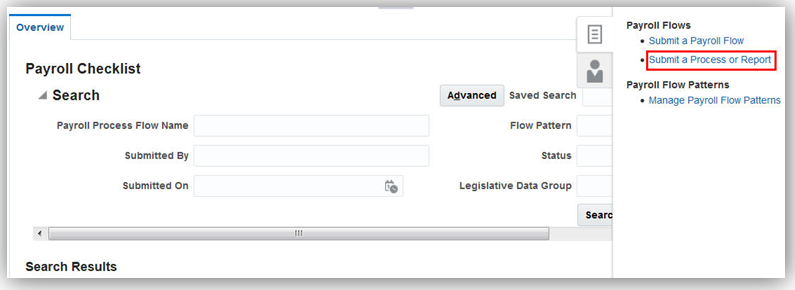
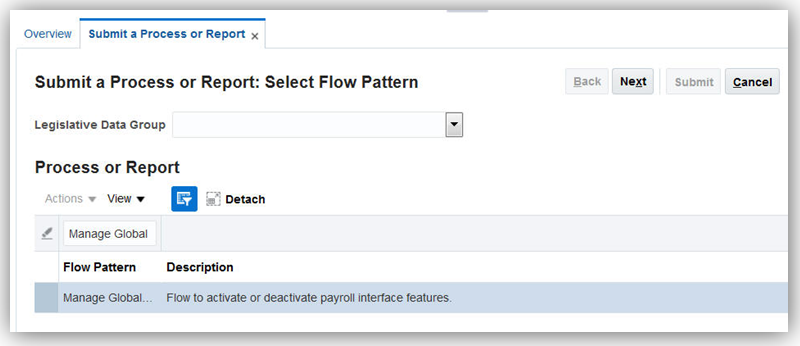
In the Activate Usage drop down, select Yes.
In the Feature field, search for and select Assignment EIT Information EFF.
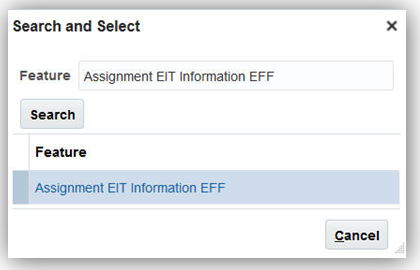
In the Component field, search for and select Additional Assignment Details for ADP Global Payroll.
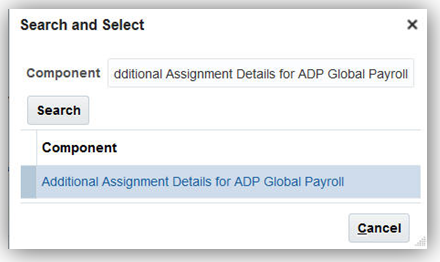
In the Subcomponent field, search for and select the required subcomponent.
NOTE: If you want to enable all the fields, choose “All”.
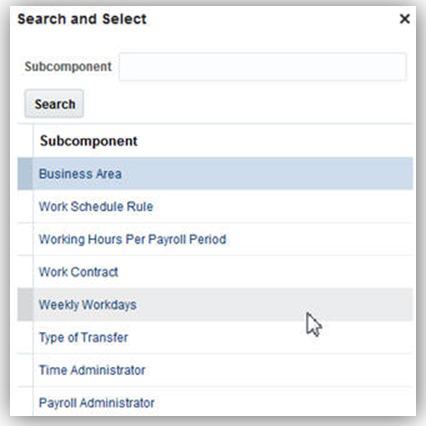
Feature: Person EIT Information
Component: Additional Person Details for ADP Global Payroll
Subcomponent: Select the subcomponents as applicable.
Features and the subcomponents under them to be enabled for your implementation depend on the recommendation given by ADP for your implementation. Please consult with ADP before enabling the features and subcomponents.
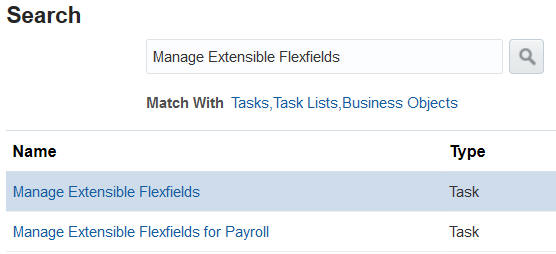
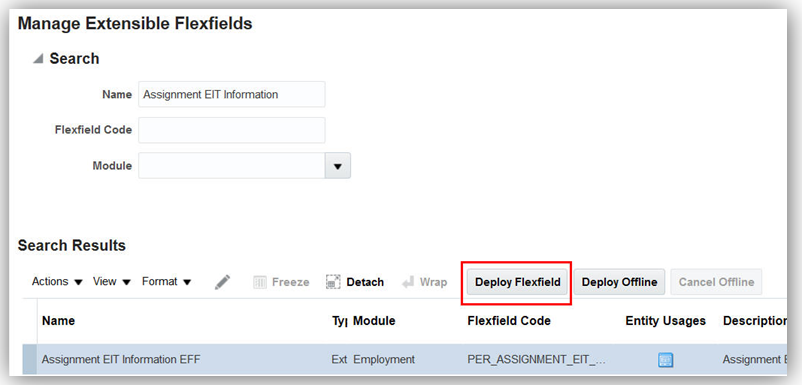
Repeat steps 11, 12 and 13 for Person, searching for Name as Person EIT Information.
Submitting the ADP Global Payroll Interface
Perform the following steps to generate the Payroll Interface for ADP Global Payroll.
- Navigate to the Payroll Checklist work area.
- Select the Submit a Process or Report task from the task pane.
- Select the legislative data group.
- Search for the process Run Payroll Interface for ADP Global Payroll.
- Select the process and click Next.
- On the Process Parameters page, provide the following parameters:
- Select the required object group in the Object Group field.
- In the Payroll Name field, enter a payroll name. Only those employees mapped to that payroll are considered for extraction.
- In the Process Start Date field, enter a start date for the extraction period.
- In the Process End Date field, enter an end date for the extraction period.
- Click Submit.
- Monitor the status of the process to successful completion.
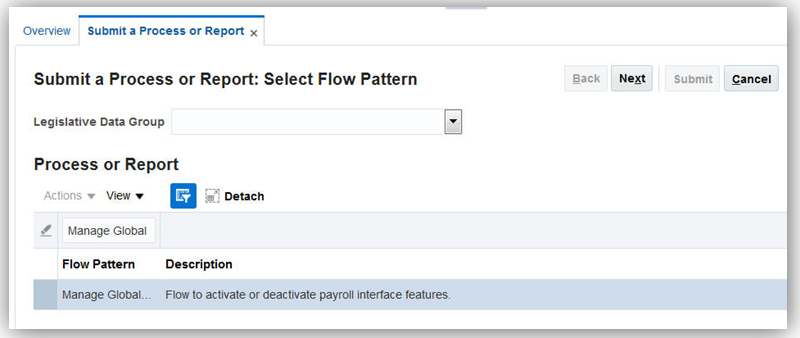
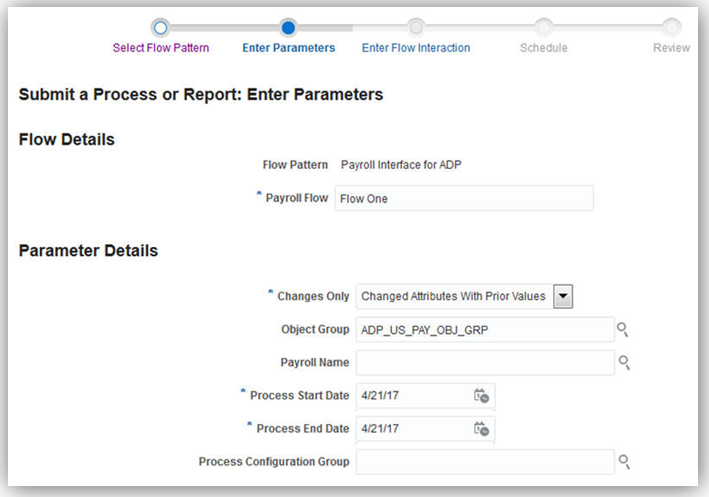
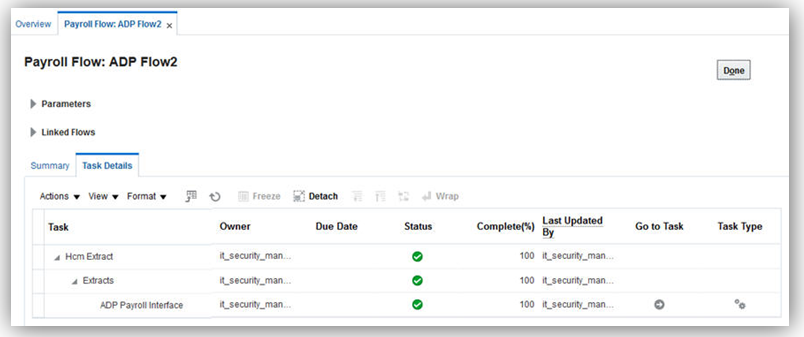
Steps to Enable
There are no steps necessary to enable this feature.
Role Information
Payroll Interface for ADP Global Payroll is available under the shipped Payroll Manager and Payroll Coordinator roles.
Tips and Considerations
The level of extended data capture and additional configurations (Rate Definitions, Object Groups and so on) required may vary by individual implementation depending on the customer requirements and the data required by ADP Global Payroll.
Finalize the details after analyzing the Implementation guides provided by Oracle and ADP.
The Deleted Data Report provides details of the data that you deleted during the extraction period, such as element entries and personal payment method. This report supplements the ADP Global Payroll Interface output xml file to provide details about the complete set of data changes within the extraction period.
Use the Submit a Process or Report task on the Payroll Checklist work area to generate the Deleted Data Report.
The report is based on the Audit functionality. Therefore, you will need to enable audit on the objects that must be tracked for deletion.
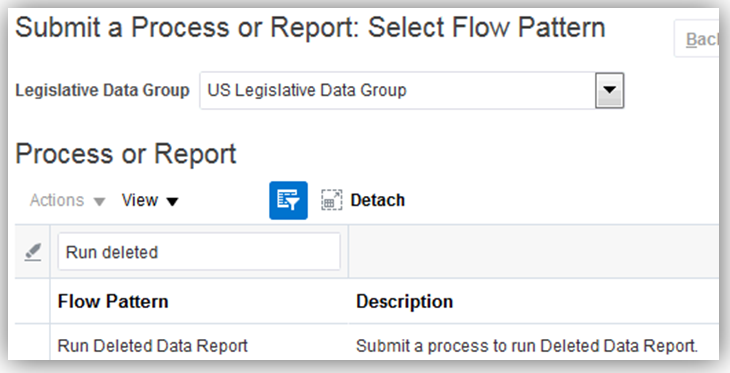
Deleted Data Report
Steps to Enable
There are no steps necessary to enable this feature.
Role Information
The Run Deleted Data Report flow is available for the Payroll Manager and Payroll Interface Coordinator roles.
Country Support for Payroll Interface
New Calculation Card: Hardship Factor
Use the Hardship Factor calculation card to capture information related to Hardship Factor. The calculation card component and component details contain the following fields:
- Year Concerned
- Hardship Factor: Hyperbaric activities, Night time work, Alternative cycle, Repetitive work
For the same year when the person reaches a new hardship factor, you must update this calculation card to specify the new factor. In the subsequent years, even though the hardship factors may remain the same, you must update the Year Concerned field to reflect the change in year, and the hardship factors, if required.
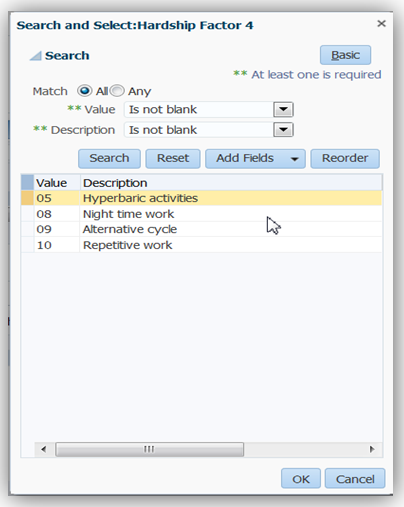
Values for Hardship Factor
STeps to Enable
There are no steps necessary to enable this feature.
Statutory Deduction Calculation Card Enhancement
Capture the following additional information in the Statutory Deduction calculation card:
- Resident Abroad: Social Security and Tax status
- Pensioner: Employee Pension status upon hire
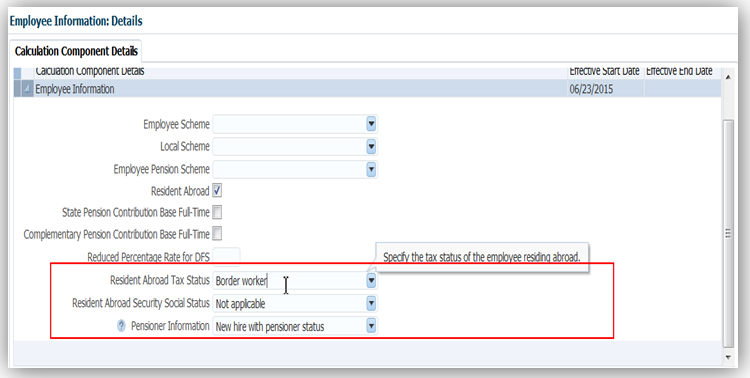
Enhanced Statutory Deduction Calculation Card
STeps to Enable
There are no steps necessary to enable this feature.
Pension and Welfare Calculation Card Enhancement
Capture the following additional information in the Pension and Welfare calculation card:
- Number of adult legal beneficiaries
- Number of dependent children
- Number of child legal beneficiaries
- Number of beneficiaries
The Internal Contract Reference field is defined at the TRU-level. You must select a value here.
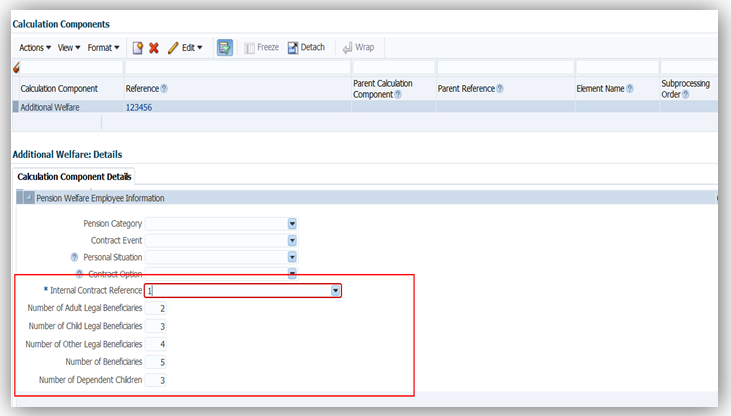
Enhanced Pensions and Welfare Employee Calculation Card
STeps to Enable
There are no steps necessary to enable this feature.
Human Resources Transactional Business Intelligence
Oracle Fusion Transactional Business Intelligence is a real time, self service reporting solution offered to all Oracle® Fusion application users to create ad hoc reports and analyze them for daily decision-making. Oracle Transactional Business Intelligence provides human resources managers and specialists, business executives, and line managers the critical workforce information to analyze workforce costs, staffing, compensation, performance management, talent management, succession planning, and employee benefits.
New Subject Area: Human Capital Management - Approval Notification Archival Real Time
This new subject area enables you to report on the tasks, the assignees for the tasks, approvals, and the corresponding dates of approvals.
Steps to Enable
If you use the predefined reference roles, then no steps are necessary to enable this feature.
Otherwise, you must assign relevant security privileges to your roles to enable this feature. See Role Information (below) for details.
Role Information
If you are using custom roles, then you need to ensure that the transaction analysis duty role that secures the new subject area is mapped to relevant job roles. This table identifies the required transaction analysis duty role and suggests a target job role. You can add the duty role to different roles if you prefer.
See the Upgrade Guide for Oracle HCM Cloud Applications Security (My Oracle Support document ID 2023523.1) for instructions on implementing new features in existing roles.
| Transaction Analysis Duty Role |
Job or Abstract Role |
| Archived HCM Approval Task Transaction Analysis Duty' |
HRC_HUMAN_CAPITAL_MANAGEMENT_APPLICATION_ADMINISTRATOR_JOB |
New Dimension: Person Schedule Assignment
Expand on employee schedule reporting using the new dimension called Person Schedule Assignment in the Person Real Time subject area. Using this new dimension, you can report on Schedule Name, Primary Schedule, Resource Type, and Start and End dates.
Steps to Enable
There are no steps necessary to enable this feature.
New Dimension: Person Schedule Assignment Exception
Expand on employee schedule reporting using the new dimension called Person Schedule Assignment Exception in the Person Real Time subject area. Using this new dimension, you can report on employee schedule exceptions such as Exception Name, Type, Availability, and Start and End dates.
Steps to Enable
There are no steps necessary to enable this feature.
New Dimension: Employee Supervisor Hierarchy Bottom Up
This new dimension shows the manager hierarchy chain from the bottom up, starting from the employee. This dimension is added as a subfolder in the Worker dimension.
Steps to Enable
There are no steps necessary to enable this feature.
Enhanced Subject Area: Vacancy Real Time
Enforce the hiring manager information whenever vacancies are reported using the Vacancy Real Time subject area. The Hiring Manager attribute is added to the Vacancy Details folder.
Steps to Enable
There are no steps necessary to enable this feature.
Enhanced Subject Area: Work Relationship, Worker Assignment, and Assignment Event Details
Enhance your reporting capability by including the line manager name in reports, even for terminated employees.
Steps to Enable
There are no steps necessary to enable this feature.
Enhanced Subject Area: Work Relationship Real Time
Streamline the reporting to also include the non primary work relationships of an employee along with the existing primary work relationship functionality using the Work Relationship Real Time subject area.
Steps to Enable
There are no steps necessary to enable this feature.
The Job dimension has been enhanced to include information on whether any benchmark exists for an employee, and if yes, then the benchmark Job Code for that employee is included in the report.
Steps to Enable
There are no steps necessary to enable this feature.
Enhanced Dimension: Person Names
The Person Names dimension in the Person Real Time subject area has been enhanced with these additional attributes: Person Name Information 1 to 30.
Steps to Enable
There are no steps necessary to enable this feature.
Enhanced Legal Employer Dimension - Position Synchronization
Reporting on legal employer has been enhanced with the addition of a subfolder called Position Synchronization. With this enhancement, you can report on synchronization, job, grade, and department, and so on.
Steps to Enable
There are no steps necessary to enable this feature.
Improve the performance of your prompts using the Compensation Manager hierarchy with the addition of a new dimension used exclusively for building the dashboard prompt. The new dimension named ‘Compensation Manager List’ is added to the Workforce Compensation Real Time and Workforce Compensation Budgets Real Time subject areas.
This dimension is exposed for showing the list of workers that can be accessed by HR and Compensation Professionals. This dimension is used in dashboards to improve performance. These list dimensions provide a simple list of Direct or All Reports within a prompt. No hierarchical support is provided through these dimensions. These list dimensions return the list of workers that can be accessed by the user. Because it is only meant to be used for dashboard prompts, adhoc reporting on this dimension will not return the typically meaningful hierarchical results. You must use other existing hierarchical dimensions for more advanced hierarchical reporting needs.
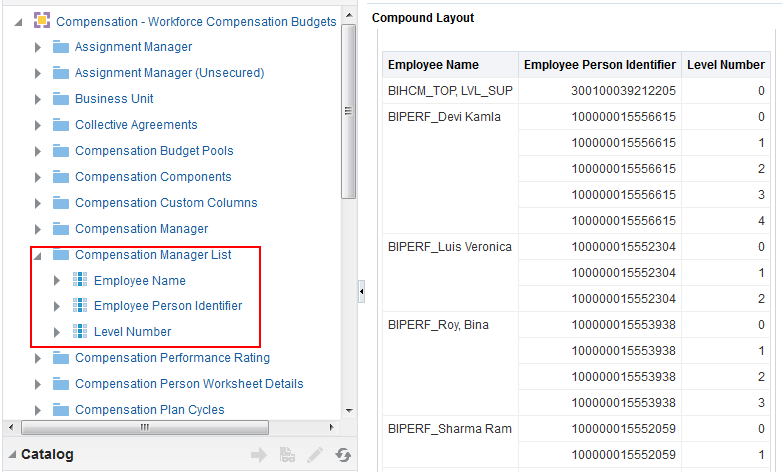
OTBI Catalog Showing Compensation Manager List
Steps to Enable
There are no steps necessary to enable this feature.
New Sample Analyses for Global Human Resources
Streamline building analysis by using the following new sample Global Human Resource analyses now available:
- Headcount KPI: Key metrics related to organization headcount.
- Headcount Trend: Trend across headcount, FTE and contingent workers for the selected year. Headcount is shown by months of the year.
- Joiners and Leavers: New hires and terminations for the selected year by month.
- Grade by Gender: Shows the split between gender counts for the selected grades.
- Headcount by Age Profile: Headcount by various age bands of employees.
- Joiners by Grade and Gender: New hires by grade and split by gender.
- Joiners by Age Band and Gender: New hires by calculated age band and split by gender.
- Leavers by Grade and Gender: Terminations by grade and split by gender.
- Leavers by Age Band and Gender: Terminations by calculated age band and split by gender.
- Promotions by Grade and Gender: Promotions by grade and split by gender.
- Promotions by Age Band and Gender: Promotions by calculated age band and split by gender
- Age Band Diversity: Percentage of workers in the organization by calculated age band.
- Length of Service Diversity: Workers in the organization by length of service band.
- Employee Ethnicity: Percentage of workers by their ethnicity.
- Gender Diversity: Percentage of workers by gender
For access to the library of sample reports and analytic that can be used and/or modified for use please access Apps Connect and the Report Sharing Center.
Steps to Enable
There are no steps necessary to enable this feature.
Translate long-term corporate strategy into execution plans by ensuring that the strategy is supported by the right workforce—the right skill sets and headcount at the right time. Look at long-term demand for resources by exploring scenarios that impact those demands.
Translate long-term corporate strategy into execution plans by ensuring that the strategy is supported by the right workforce—the right skill sets and headcount at the right time. Look at long-term demand for resources by exploring scenarios that impact those demands. Also look at what’s going to happen with your current workforce, for example, through retirement or natural attrition. Evaluating demand against supply helps you understand what gaps there may be—positive or negative—so that you can proactively plan for needed resources. You can anticipate the headcount and skills needed to support your business strategy.
Steps to Enable
There are no steps necessary to enable.
Oracle Fusion Employee Wellness supports corporate initiatives to improve employee fitness and health through the use of opt-in wellness features. This application integrates with popular fitness tracking services to simplify and automate the acquisition of exercise data from a wide range of devices.
Oracle Social Network Integration
Oracle Social Network capabilities are now available from Wellness pages, providing popular social media features to Wellness users covering goals and teams.
Where appropriate, links have been added to listed fitness goals and teams that will bring up discussion areas for these items in the Oracle Social Network applications. The links will be visible in displays for:
- Portal and Lifestyle Leaders Scoreboard
- Profile and Goals
- Personal Activity Tracking.
STeps to Enable
To enable OSN for Wellness follow these steps:
- Login to HCM Fusion.
- Navigate to the homepage and click on “Setup and Maintenance”.
- Enter “social” into the search field and search.
- Select “Manage Oracle Social Network Objects” from the result field.
- Select “GoalsOnly1” under Employee Wellness.
- Click the ‘+’ symbol under the “GoalsOnly1: Attributes” section and check the desired attributes to enable. Click OK when finished.
- Click on “Enable Object” by selecting “GoalsOnly1”.
- Select “Automatic” and click OK.
- Follow the steps 1-8 to enable the business object “HwrCnstParTeamB”.
- Click Synchronize.
- Click Save and Synchronize.
Provide surveys and questionnaires that help an employee assess their current wellness status and formulate their wellness goals
The following displays have been updated to implement this functionality:
- Portal and Lifestyle Leaders Scoreboard
- Profile and Goals
- Personal Activity Tracking
Steps to Enable
There are no steps necessary to enable this feature.
Wellness program administrators have the ability to set up corporate-wide competitions where employees can compete for prizes by competing with colleagues. The Portal and Lifestyle Leaders Scoreboard display has been enhanced to display daily results for the competitions.
STeps to Enable
There are no steps necessary to enable this feature.
Privacy Notification for Contest Participants
Concerns about the visibility of individual fitness or health activities of users participating in fitness contests and competitions are addressed by providing a clear notification as to the impact of enrolling in a contest. The competition entry page has been modified to show the disclaimer noting the user’s name will be visible in contest leader board displays, and requiring that the consent to this be given before the competition can be entered.
STeps to Enable
There are no steps necessary to enable this feature.
Users can now request an ergonomic assessment from within Oracle Fusion HCM Wellness. The ergonomic assessment request will be routed to a health and safety professional. The user can monitor the status of their request and respond to questions from the assessor. At the completion of the assessment, the results are provided to the requesting user.
The new features also include support for the ergonomic assessor, starting with the ability to view all active requests in a single work queue. The system also supports the assessor by providing a standard checklist for use during each assessment. The user is prompted to provide guidance on specific health and safety issues in the request for evaluation. After the requested assessment is completed, the results are returned to the user so that they can confirm that the ergonomic assessment has been completed successfully.
STeps to Enable
There are no steps necessary to enable this feature.
In support of non-US users, or those users more comfortable with the metric system, the following displays can now display fitness records in metric system units:
- Goal and Profile displays
- Personal Activity Tracking displays
The choice of units is selected by the administrator and will be applied to all users.
STeps to Enable
There are no steps necessary to enable this feature.
Wellness Administration Experience Improvements
We have created a user interface that is markedly visual in character. The intuitive graphical representation of corporate goals, competitions, participation rates, incentives, and activity tracking service information enables you to perform administrative tasks with ease. The use of donut graphs, bar graphs, and tables to represent information also ensures that you can view the nature of employee engagement at a glance, without having to delve into the minor details.
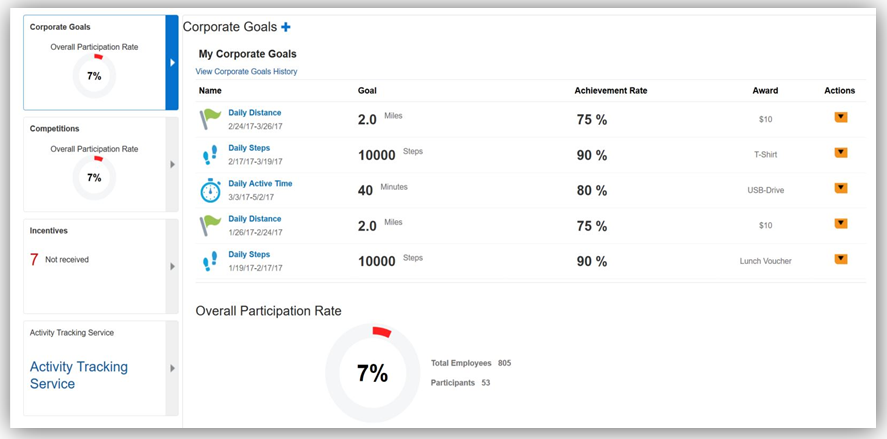
Corporate Goals Page in the Employee Wellness Work Area
Steps to Enable
There are no steps necessary to enable this feature.
Key Resources
For more information, go to Applications Help for the following topics:
- Managing Employee Wellness: Overview
Employee Experience Improvements
The intuitive user interface empowers you to manage your wellness with ease. You can view your activity progress at a glance on the main page of the Wellness work area. You can also add defined and custom activities with the click of a button. The simplicity of the user interface is also reflected in how quickly you can add personal and corporate goals, enroll in competitions, and join and create teams.
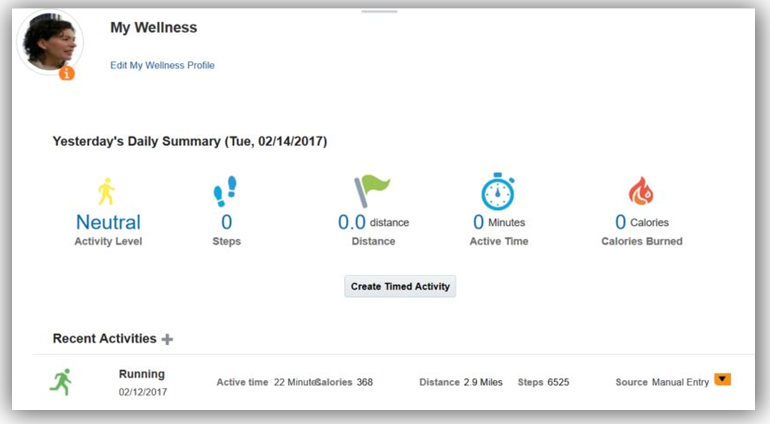
Daily activity summary and list of recent activities in the Wellness work area

View and add recommended corporate goals in the Wellness work area
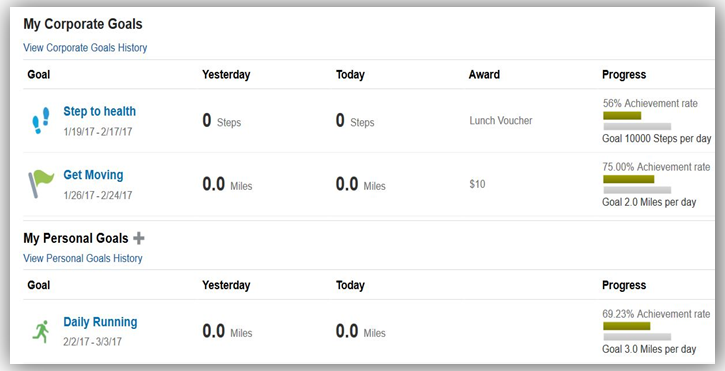
Track corporate and personal goal progress in the Wellness work area
Steps to Enable
There are no steps necessary to enable this feature.
Key Resources
For more information, go to Applications Help for the following topics:
- Managing Employee Wellness: Overview
Being in control of your wellness acquires a distinctly social dimension as you can now challenge your colleagues or accept challenge invitations from them to participate in various corporate wellness goals and competitions. Challenge your colleagues by searching for them by their name, or use the quicker option of directly adding your peers and direct reports. You can find this feature in the My Corporate Goals and My Competitions sections.

Challenge Your Peers and Direct Reports with a Click of a Button in the Wellness Work Area
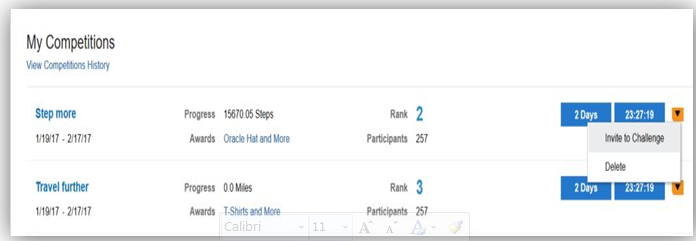
Challenge Your Colleagues to Competitions in the Wellness Work Area
Steps to Enable
There are no steps necessary to enable this feature.
Key Resources
For more information, go to Applications Help for the following topics:
- Managing Employee Wellness: Overview
In addition to challenging your colleagues to corporate wellness goals and competitions, you can extend the social dimension of wellness by inviting your colleagues to achieve the personal goals that you created. Challenge your colleagues by searching for them by their name, or use the quicker option of directly adding your peers and direct reports. You can find this feature in the My Personal Goals section of the Wellness work area.
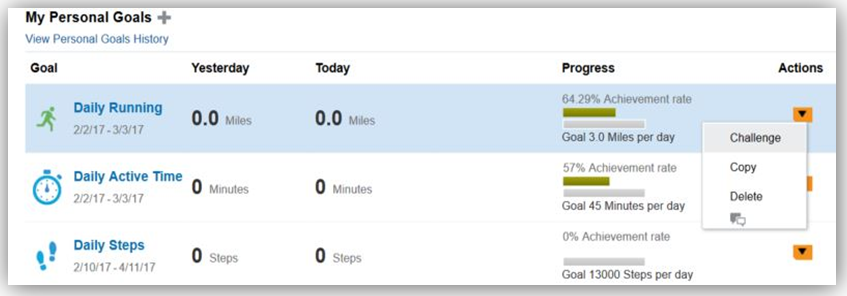
Challenge Your Colleagues to Personal Goals in the Wellness Work Area

Challenge Your Peers and Direct Reports with the Click of a Button in the Wellness Work Area
Steps to Enable
There are no steps necessary to enable this feature.
Key Resources
For more information, go to Applications Help for the following topics:
- Managing Employee Wellness: Overview
You can now record your activities even if you do not own a supported activity tracking device. Record an activity by timing it on the application as well as manually entering activity data. You can time defined activities such as walking and running and let the application calculate the distance and steps for you. You also have the option of timing custom activities, such as zumba or yoga. You can find this feature on the main page of the Wellness work area.
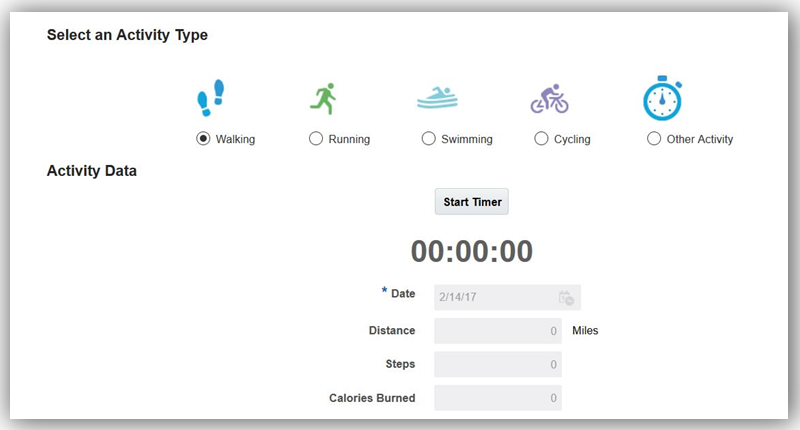
Time an Activity in the Wellness Work Area
Steps to Enable
There are no steps necessary to enable this feature.
Key Resources
For more information, go to Applications Help for the following topics:
- Managing Employee Wellness: Overview
Individual Measurement Preference
You can now personalize your Wellness work area even further by setting your measurement preferences to the metric or imperial unit system. For example, if you set your measurement preference to metric, the distance activities display in kilometers as opposed to miles. You can set your measurement preference to your preferred unit system at any time by clicking the Edit My Wellness Profile link on the main Wellness page.
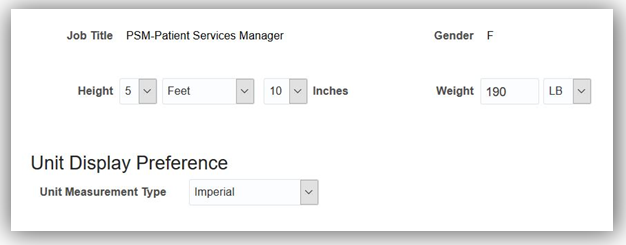
Set your Measurement Preferences in the Wellness Work Area

Recent Activities Section with the Imperial Measurement Preference
Steps to Enable
There are no steps necessary to enable this feature.
Key Resources
For more information, go to Applications Help for the following topics:
- Managing Employee Wellness: Overview
Hiring Manager Experience is a solution delivered as part of the Oracle HCM Cloud. It enables hiring managers to manage hiring activities related to candidates, candidate job applications, requisitions, and offers using a simplified Web experience.
Hiring Manager Experience is delivered as part of the Oracle HCM Cloud and provides access to hiring manager functions with a simplified Web experience.
You access Hiring Manager Experience by clicking My Team then Hiring from the Navigator page (Navigator > My Team > Hiring).
Hiring Manager Experience is comprised of three tabs:
- Hiring Activities
- Requisitions
- Candidates
Hiring managers can use the Hiring Activities page to view their pending tasks related to requisition approval, offer approval, and evaluations. Hiring managers can review the requisition or offer details before deciding to approve or decline the requisition or offer. They can also decide to pass an approval task to another user. The offer or requisition is then routed to the next approver in the approval flow. In the Evaluations section, hiring managers can also view upcoming interviews for which they are a participant. Clicking the requisition title opens the evaluation feedback form. From there, they can fill out the candidate responses in the evaluation questionnaire.
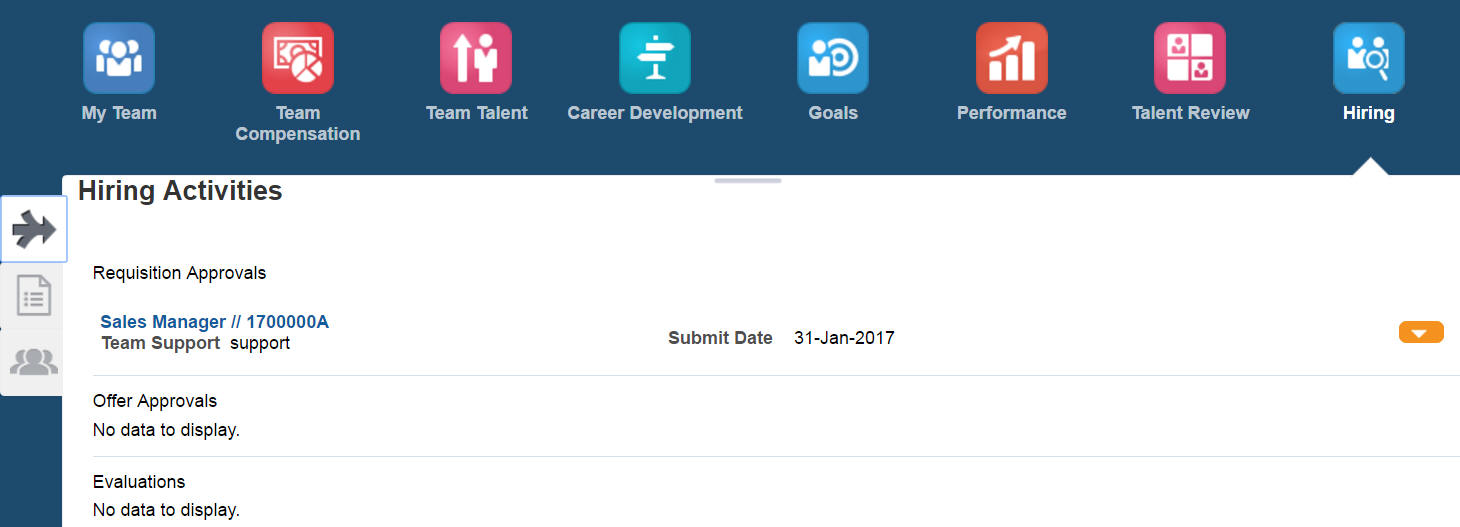
Hiring Activities Page
Hiring managers can use the Requisitions page to manage open active requisitions that they own. They can search for a particular requisition, they can see the number of candidates at each stage of the hiring process (New, Review, Evaluation, and Selection), and they can access candidates who have applied to their requisitions. Hiring managers can also evaluate candidates by comparing their submitted details side by side. After the comparison, they can move candidates forward in the hiring process or reject some of them.
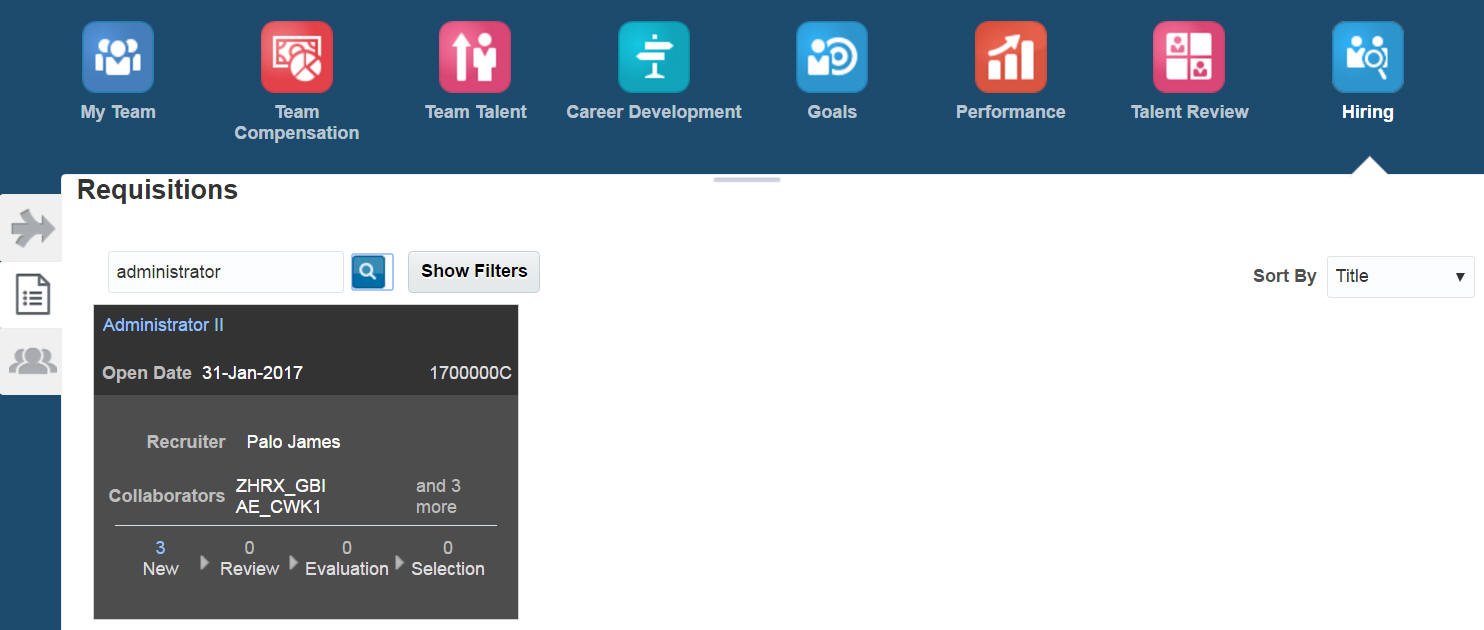
Requisitions Page
Hiring managers can use the Candidates page to quickly locate candidates who applied to requisitions. Hiring managers can view all candidate applications that are in various stages of the hiring process. They can search for a particular candidate application, review the details, and add comments. Based on their assessment, they can move the candidate forward in the hiring process or reject the candidate.
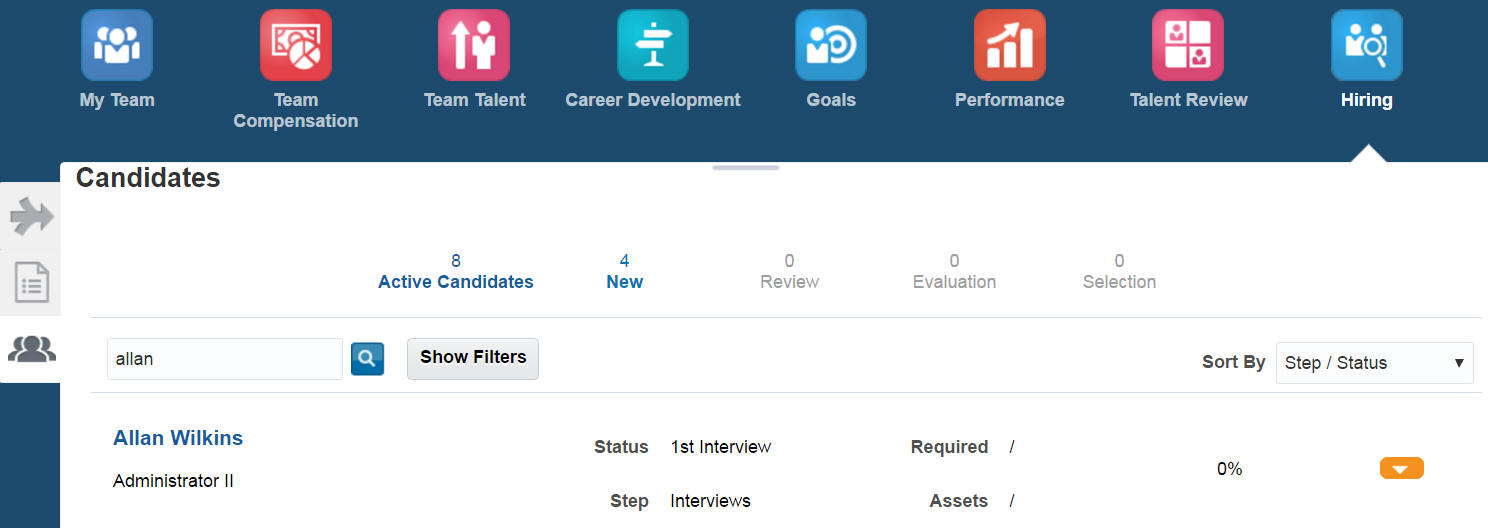
Candidates Page
Prerequisite:
- Oracle HCM Cloud and Oracle Taleo Enterprise Cloud Service environments must be successfully connected. The two environments are not configured automatically and customers must log an SR to request that the environments be paired together.
To enable the Hiring Manager Experience:
- Ensure SSO is configured correctly.
- Set the Enable Mobile setting to Yes to turn on Hiring Manager Experience (Taleo > Configuration > General Configuration > Settings). Note that this setting is used by both the Hiring Manager Experience and HCM Mobile as these two products share the same Web services.
- Set the Evaluation Questions and Questionnaires Activation setting to Yes (Taleo > Recruiting Administration > Settings).
- Create a Mobile user type and grant the Access Mobile permission (Taleo > Configuration > SmartOrg Administration > User Types). This is a security requirement to ensure that the right users gain access to Taleo services either via the Hiring Manager Experience or HCM Mobile.
- Assign the Mobile user type to users (Taleo > Configuration > SmartOrg Administration > User Accounts).
- Configure the candidate selection workflow to move candidates in the hiring process (Taleo > Configuration > Recruiting Administration > Candidate Selection Workflow).
Tips and Considerations
Hiring Manager Experience requires the following product pairing:
- Oracle HCM Cloud R12.PB5 and Oracle Taleo Enterprise Cloud Service 15B.6, as well as any future monthly or quarterly updates of those versions (Oracle HCM Cloud R13.0 and Oracle Taleo Enterprise Cloud Service R17.0 are not yet supported).
- The pairing is done with Version 1 of the out-of-the-box (OTTB) integration between Oracle Fusion Applications Cloud Service and Oracle Taleo Enterprise Cloud Service.
Workforce Reputation Management
Oracle Fusion Workforce Reputation Management harnesses social networks to help organizations discover, mobilize, and retain talent. This functionality provides insight into workers' social reputation and influence while also monitoring workers' social media usage compliance and mitigating social media risk.
Simplified Administration Now Available from Home Page
Simplify your administration using a new page available from the My Workforce icon on the home page.
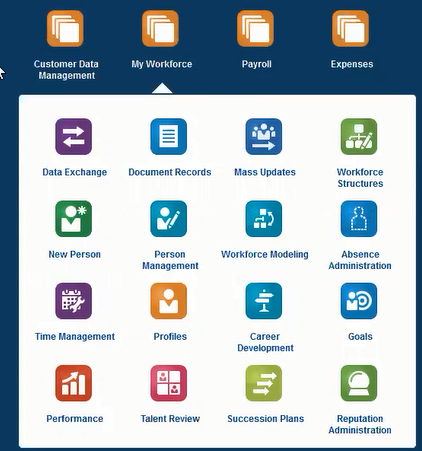
Reputation Administration Icon under My Workforce
You no longer have to download or deploy the subscription application file because the subscription is now integrated with the application.
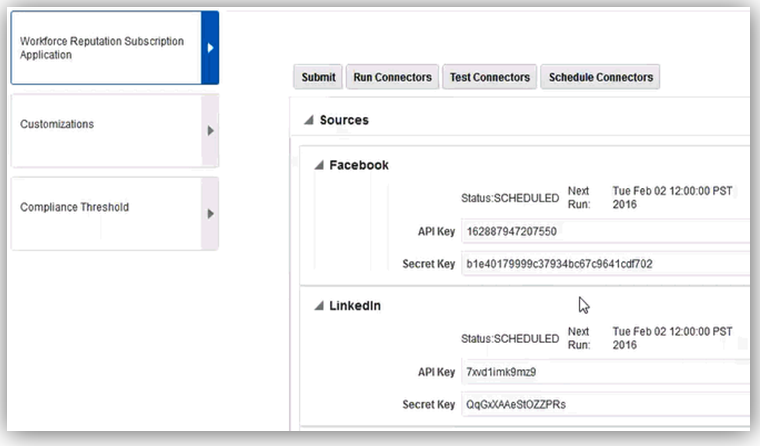
Workforce Reputation Subscription Application Page
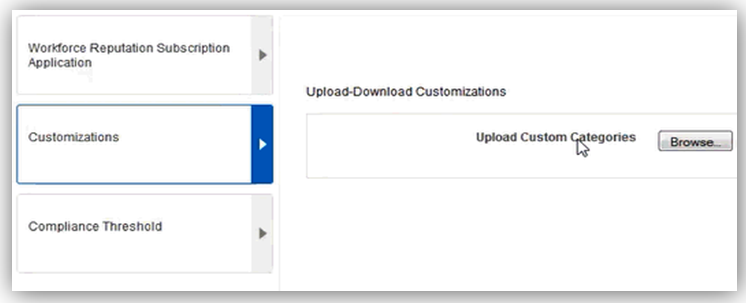
Customizations Page

Compliance Threshold Settings
The integration also means that the URLs you enter in the social media sites have changed. You now enter the host and port where Workforce Reputation Management is deployed. The following features are no longer required and so have been removed: entering a keystore password, entering a custom URL, and gamification.
There are no steps necessary to enable this feature.
User Registration Available from a New Page in the Reputation Work Area
You no longer need to manage registration using a separate subscription application. Users having the Workforce Reputation Subscription user privilege can register themselves using a new page available from the Workforce Reputation Subscription Application icon on the My Reputation page. From this page, users can also endorse other users and view their own endorsements.
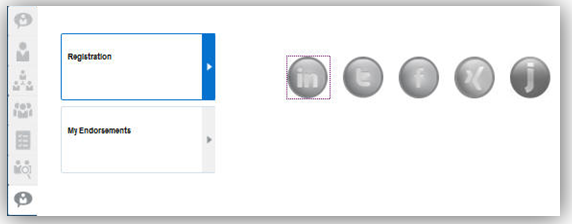
User Registration Page
There are no steps necessary to enable this feature.
You can now improve the user experience for users with the new redesigned application. The redesign includes a new user interface for employees. Employees can create their skill profiles, find mentors, participate in surveys, and manage their reputation profile from the My Reputation page.
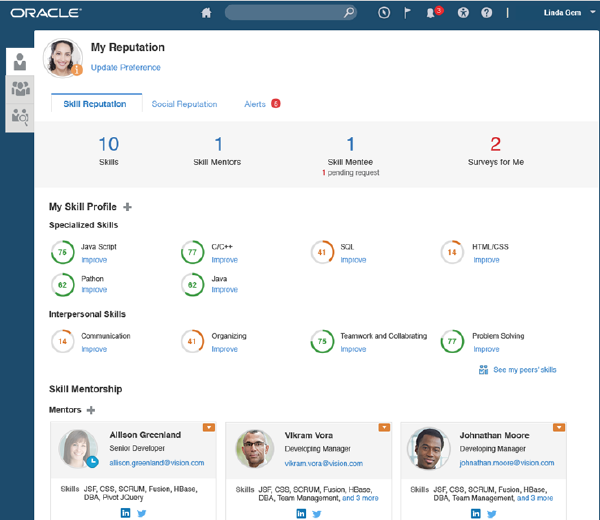
My Reputation Landing Page
Steps to Enable
There are no steps needed to enable this feature.
Tips and Considerations
Employees can select the top skills to display in their My Skill Profile. To personalize the skill profile, in the My Reputation page, select Update Preferences > My Skill Profile.
Key Resources
For more information, go to Applications Help for the following topic:
- Reputation: Explained
Build Skill Profile and Ratings
You can now create personalized skill profiles. Skill profiles enable you to build your reputation profile and identify areas for improvement.
An Improve link appears next to skills that need to be developed. The link directs you to a learning resource such as a course or training to help develop the skill. Completing the course or training improves the ratings for the skill. Select the Improve link next to a skill in the My Skill Profile section on the My Reputation page.
Steps to Enable
There are no steps needed to enable this feature.
Key Resources
For more information, go to Applications Help for the following:
- FAQ: How can I improve my skill ratings and scores?
Recognize Others Using Endorsements
You can now recognize and endorse peers and others in your professional network for skills. Employees can endorse their colleagues and managers can endorse their reports. Select Endorse Others in the My Skill Profile section on the My Reputation page.
When you receive an endorsement, a notification is displayed in the Alerts tab.
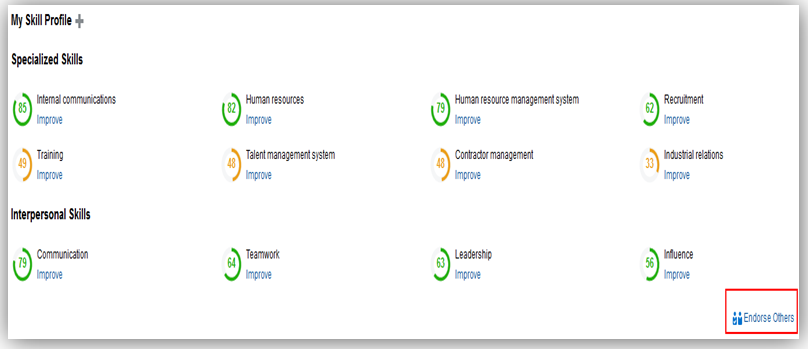
Endorse Others in the My Skill Profile Section
Steps to Enable
There are no steps needed to enable this feature.
Key Resources
For more information, go to Applications Help for the following topic:
- Endorsements: Explained
You can now search for mentors that are highly rated in specific areas. The mentor feature allows you to request and build mentor-mentee relationships to improve or develop skills.
You can request for mentorship to improve interpersonal as well as specialized skills. On the Social Reputation tab you can request mentoring to improve social or interpersonal skills. Use Find mentor to search and request for mentorship. Your mentor and mentee details are displayed in the Skill Mentorship section on the My Reputation page.
Steps to Enable
There are no steps needed to enable this feature.
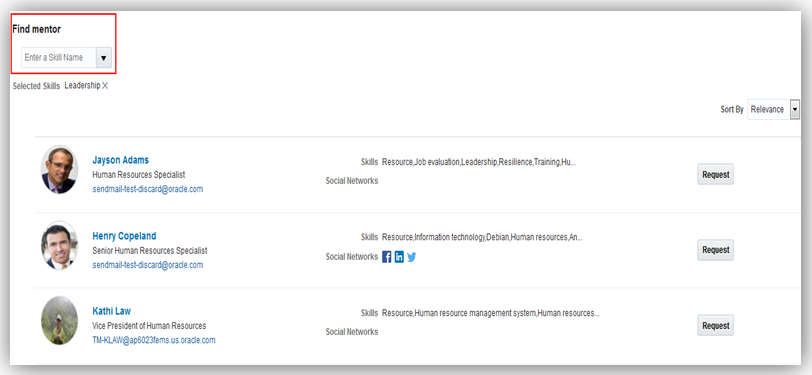
Find a Skill Mentor or Social Mentor
Key Resources
For more information, go to Applications Help for the following topic:
- Mentorship for Reputation Management: Explained
You can now create and send surveys to seek informal feedback. Managers can set up automatic meeting surveys to monitor the effectiveness of meetings organized by direct reports. You can also receive surveys from others.
Survey results for multiple choice questions are displayed graphically. Survey results for free text questions are analyzed for sentiment and organized by topic. Select Create new survey in the Surveys section on the My Reputation page.
Steps to Enable
There are no steps needed to enable this feature.
Tips and Considerations
You cannot view Reputation survey results until a minimum of five responses have been received.
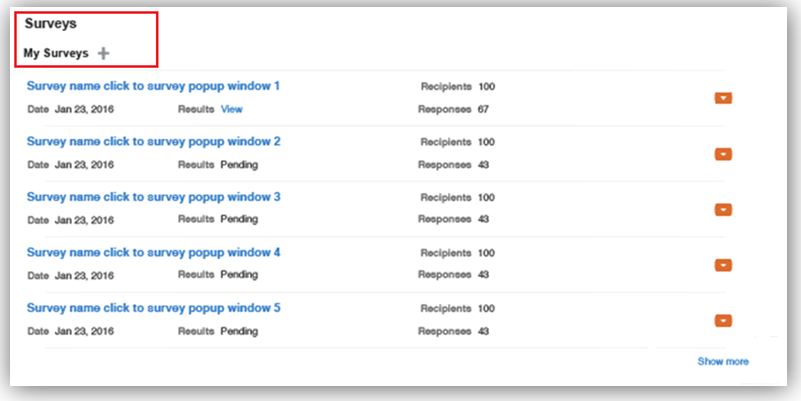
My Surveys Section in the My Reputation Page
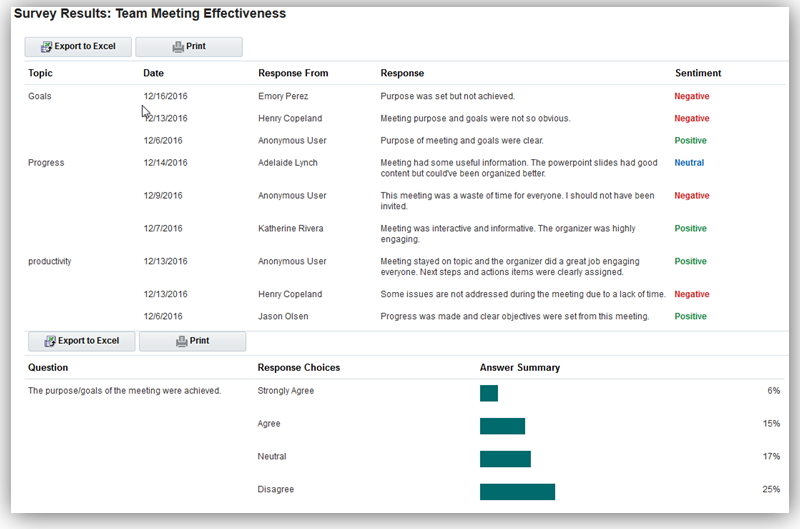
Survey Results
Key Resources
For more information, go to Applications Help for the following topic:
You can ask a question that will be automatically routed to experts who have the right skills to answer the question.
If a related discussion exists on the topic you post, the Oracle Social Network discussion pane is displayed.
Steps to Enable
Administrators need to define and enable attributes for questions that users can view, discuss, and share in the Ask an Expert section. To define and enable Workforce Reputation Management question attributes:
- Navigate to Setup and Maintenance and search for the Manage Social Network Objects task.
- Search for and expand Workforce Reputation Management.
- Select Questions1 and add attributes for questions that users post on the wall.
- Enable the attributes and select Automatic to ensure questions with the defined attributes are automatically shared.
- Click Synchronize and then Save.
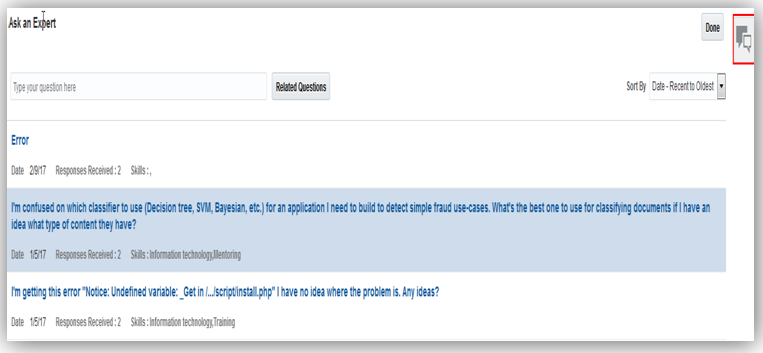
Ask an Expert section in the My Reputation Page
Key Resources
For more information, go to Applications Help for the following topics:
- Enabling Oracle Social Network in Reputation Management: Explained
- Social Networking with Reputation Management: Explained
Simplified Administration User Experience
Administrators can now configure and set up Reputation Management using the redesigned Reputation Administration interface. Configure and manage social network connectors, skill categories, meeting surveys, and compliance settings.
Navigate to My Workforce > Reputation Administration to access the redesigned administration interface.
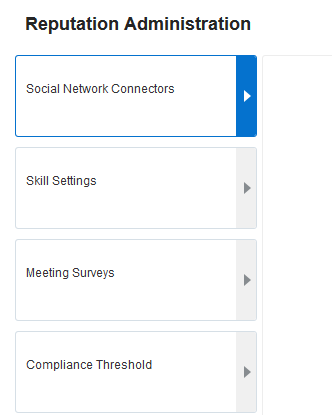
Reputation Administration Work Area
Steps to Enable
There are no steps needed to enable this feature.
Key Resources
For more information, go to Applications Help for the following topic:
- Workforce Reputation Administration Components: Explained
---

Copyright © 2017, 2018, Oracle and/or its affiliates. All rights reserved.
This document is provided for information purposes only, and the contents hereof are subject to change without notice. This document is not warranted to be error-free, nor subject to any other warranties or conditions, whether expressed orally or implied in law, including implied warranties and conditions of merchantability or fitness for a particular purpose. We specifically disclaim any liability with respect to this document, and no contractual obligations are formed either directly or indirectly by this document. This document may not be reproduced or transmitted in any form or by any means, electronic or mechanical, for any purpose, without our prior written permission.
Oracle and Java are registered trademarks of Oracle and/or its affiliates. Other names may be trademarks of their respective owners.
Intel and Intel Xeon are trademarks or registered trademarks of Intel Corporation. All SPARC trademarks are used under license and are trademarks or registered trademarks of SPARC International, Inc. AMD, Opteron, the AMD logo, and the AMD Opteron logo are trademarks or registered trademarks of Advanced Micro Devices. UNIX is a registered trademark of The Open Group.
12.17



